












































































Input costs, profitability, cashflow and loss of BPS payments top the list of factors that are impacting how farmers are now running their business, according to a new report.
The annual Marketing to Farmers report fromHillsgreenin partnership with England Marketing, which surveyed 745 farmers, also revealed that climate change and investing in renewable energy remain high on the farming agenda.
When asked to rank the factors which are having the most impact on the way they farm, respondents said:
1. Farm input costs
2. Profitability
3. Cashflow
4. Loss of BPS payments
5. Land availability
6. Government grants
7. Clarity on Defra schemes
8. Interest rates
9. Climate change
10. Staffing Issues
Whilst money worries continue due to inflation, energy costs and feed costs eating into potential revenue for many businesses, in agriculture it's also a lack of communication from the Government on various agri-environmental schemes and grant payments that is having a real impact on everyday farm operations.
Not making the top ten but highlighted in the research as other areas of concern were also weather, health and age, regulation and disease and pests.
In the current challenging climate, farmers were also asked about their investment plans and it was found that investing in some form of diversification (35%) was being most considered by farmers. They were also actively seeking investment opportunities in machinery (33%) and building (31%).
Other areas of potential investment mentioned by farmers were renewable energy, technology and soil and environmental health.
Andy Venables, Managing Director of Hillsgreen, said: "Farmers are actively exploring various investment opportunities to enhance their farm businesses, increase revenue streams, and
improve the overall sustainability of their operations. They do see potential growth areas within the sector and this emphasises the need for businesses to tailor support and resources to help farmers navigate and capitalise on these opportunities."
With financial considerations having such a significant impact on farming businesses, it's unsurprising that poor mental health in farming is estimated to be 46% higher than in other occupations.
In times of need, it is fellow farmers and friends that the majority of farmers look to for financial, mental health and practical support (15%). However, this is closely followed by going online or using social media to find support (12%).
Farmers are more likely to use the internet when searching for advice before going directly to family or the large farming welfare charities and networks provided by the likes of RABI, FCN and NFU.
It is however anticipated that the use of online services will be to connect with family and friends or to access charitable and support networks provided by organisations.
The report also analysed how farmers communicate with each other, with brands and with partners. More than eight in ten (83%) of farmers use social media regularly with six in ten (61%) using it daily, up from 45 per cent last year.
Nearly one quarter (22%) are using TikTok either daily or weekly, but WhatsApp kept top place in the channels most used by farmers. YouTube has seen an significant increase in daily use too, with 37 per cent using it every day, up from 14 per cent last year.
Whilst farmers use social media heavily, it is websites they rely on the most to inform their buying decisions. 77 per cent say websites hold the most influence when they are looking at making a purchase followed by search engines (65%) and farming forums (49%).
To download the full Marketing to Farmers report, free of charge, visit: https://www.hillsgreen.co.uk/marketing-to-farmershub/marketing-to-farmers-2023/
For more information visitwww.hillsgreen.co.uk
The Welsh government has today announced the interim agri-environment scheme will replace the Glastir Advances, Commons and Organic schemes on 1st January 2024.

Andrew Tuddenham said: "We're concerned that today's announcement from Rural Affairs Minister Lesley Griffiths will come as a shock for Welsh organic farmers, and particularly organic lowland farmers, as it doesn't appear to offer support for this system in the proposed scheme.

"We and other farming representatives recently called on the Minister to confirm that there would be no cliff-edge on funding for nature-friendly and low carbon farming ahead of the introduction of the Sustainable Farming Scheme. Whilst the announcement goes some way to addressing this, we remain concerned that what appears to be a singular focus on habitat will miss the wider range
of benefits secured through organic farming.
"This will be particularly unwelcome for organic dairy farmers who are squeezed between high energy and feed costs and diminishing returns for their milk. At a time when we are calling for fairer prices from the wholesalers and retailers this could be the final straw for some.
"We want to see current Glastir contract holders prioritised in the application process, given that it is proposed to be be open to all. Now is not the time to heap more pressure on farmers who manage their land through Glastir for nature, carbon and sustainable food production goals. Welsh Government must bring forward its engagement with stakeholders to ensure that the scheme helps rather than hinders sustainable farming in Wales."
The new Serena pillow bags offer a long-life easy storage solution for liquid fertiliser, slurry (not sand based), digestate, water and many other uses. The bag sizes range from 0.7m3 to 1000m3. We would recommend for large volume storage the 600m3 bag, this is approximately 130,000 gallons. At a price point under £20,000 it is the most costeffective storage and putting up multiple bags allows for easy management of the storage site when storage volumes plus of 600m3
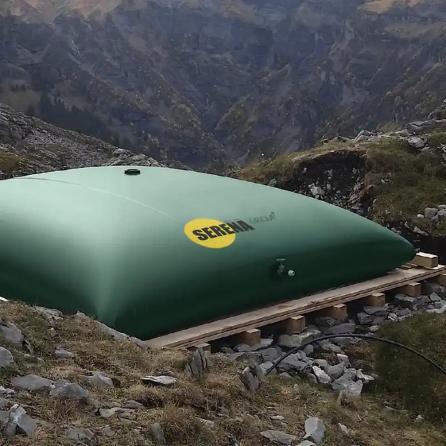

The bags can be grant aided when used as a permanent store, planning would be required while the bags meet all the SAFO regulations for the environment agency when the site is bunded. Because the bags are sealed there is no contamination by rainwater, and the gas can be tapped off for use as a renewable energy.
With life expectancy 20 years plus cost efficiency and the flexibility on storage locations is excellent. The bags have been in the Tunisian desert storing water for decades and remain fully
functional in extreme UV levels compared to the UK.
As there is no air in the bag a crust does not form when storing slurry. After 3 months we would recommend a circulation of the product. This is easily achieved by using an umbilical pump.
When specified with a connection point on the two from corners of the bag the liquid can be sucked out and pumped back in causing it to circulate and prevent sediment forming.
Covering some of the technical questions; When used as a temporary store there are no planning requirements, but we would recommend a soil bund to contain an disasters such as the tap being opened accidently and so preventing water course pollution. When bunded and at least 100 metres from a water course insurance is available to cover loss of product and replacement of the bag.
PFC offer a products to meet the demands of the modern farmer to aid with environmental protection and economic business growth.







Luke Houslay, from Widnes, makes regular trips with mum Nina and dad Duncan to Rhug Estate near Corwen, North Wales.
So the 19 year-old was thrilled to be given his own private tour of the 12,500-acre site with head gamekeeper David Pooler – on behalf of owner Lord Newborough and the National Gamekeepers’ Organisation - to photograph a wide selection of animals, including bison and deer, and the Estate’s incredible wildlife and scenery.
Taking pictures is what Luke loves to do, and despite being forced to use a wheelchair because of his disability – he contracted medulloblastoma at just 15 years old, a cancerous brain tumour that starts in the cerebellum – Nina said being out in the open at Rhug is when he is at his happiest.
“We have always visited North Wales and have been to Rhug Estate so many times,” she said. “As it’s one of Luke’s favourite places we have so many wonderful memories. He has been very ill so we bring him to relive his happiest times when he
would run around and explore as a child.”
Nina added: “Luke sadly missed their recent open day when there was the opportunity to go on a tour and look at the animals. “We contacted them via social media to see if there was another event coming up soon, and to our surprise they kindly offered him his very own private tour.

“As he is in a wheelchair it’s difficult for Luke to get around, but they drove he and Duncan in a vehicle so he could stop to get up close with the deer and other wildlife, something he would not be able to do anywhere else – it was wonderful.”

one of the country’s most picturesque organic farm estates has been a source of comfort for an inspirational young photographer
Luke has fought the cancer and its effects for almost five years, undergoing several surgeries, chemotherapy and radiotherapy and having to “learn how to do everything again” with the care and support of his parents. “He had been ill for a while when we managed to get a scan, and was admitted to hospital the same day,” said Nina.
“He didn’t return for four months; it completely turned our lives upside down.”
She added: “Because of that and residual injuries he has had so many knockbacks and sadly can’t do some of the things he would love to do, due to the life-changing impact of what he has been through.
“He is unable to go to college and he wanted to join
don’t think they know how much it meant to us.” The day will live long in their memories, as will his visit to the café, where Luke enjoyed his favourite item on the menu – a large slice of cake!
“He came home shattered but so excited, he doesn’t say much but he couldn’t stop talking about the wonderful day he had, he was ecstatic,” said Nina.
“Luke will always be on medication and will always need our care, and sadly he lost a lot of motivation and hope when he became ill, but for a few short hours he felt on top of the world, all thanks to the amazing team at Rhug – thank you.”
Rhug Estate owner Lord Newborough said Luke and his family are welcome to visit anytime.
a photography class but was unable to, so the time he spent at Rhug taking photos was huge for him, it really helped his confidence.
“Luke loves being behind the camera, nothing makes him happier. He had to prop himself up to take the shots he wanted but has a real passion for it and took some lovely photos.
“He spends his days sat with me at home, so for Rhug Estate to go out of their way for him is so heartening, I
“We are so pleased and proud to have been able to show Luke what goes on behind the scenes at Rhug, it was a privilege as we know what a supporter he has been of the Estate for many years,” he added.

“His photos are wonderful and really capture the essence of what we do, the nature and beautiful surroundings; we hope he will come and see us again soon… and bring his camera.”

For more news and information including upcoming events, visitwww. rhug.co.ukand follow them on social media @rhugestate




Rebecca Wilson is a farmer in North Yorkshire and has been involved in the recent Beaumont and Bear campaign to raise funds for the Royal Agricultural Benevolent Institution
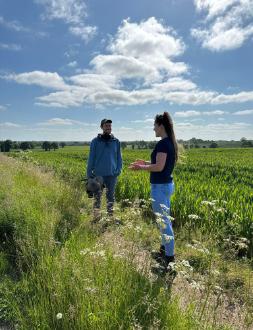


If you work in the agricultural industry, it’s likely that you’ll be aware of the unique challenges that face farmers and those who work tirelessly to produce our food.
As I write this article, we’re still waiting to get the combine out of the shed and with the weather forecast looking bleak, stress levels are rising alongside the
thought that we’ll have an even narrower window to get our harvest and drilling work done. Farmers are often subject to the impacts of factors outside of their control – weather, political decisions, commodity markets.
Whilst on some days farmers feel like they have the best job in the world, being able to enjoy nature, improve the environment and the welfare of their livestock whilst also producing food, the lows seem more pronounced than ever.


Year on year, it feels increasingly important to highlight and support the organisations set up to offer a helping hand to those in agricultural communities. One of those organisations is the Royal Agricultural Benevolent Institution (RABI). Whilst the challenges facing farmers may look a little different to when the charity was set up in 1860, RABI remains resolute in its aims to offer guidance, financial support and practical care to farming peopleof all ages.

Beaumont and Bear are a Devon based online
lifestyle clothing brand, first established in 2017. Each collection is inspired by timeless coast and countryside living. As a result of their classic clothing pieces, they have gathered a substantial farming customer base. With this in mind, Beaumont and Bear have created t-shirts to be sold as part of this campaign, with 100% of profits donated to support the vital work that RABI do to help the agricultural community.
Many of you will have heard of NFU Mutual through their role as an insurance provider and understanding the aims behind the t-shirts, they are supporting the campaign for a second year.
The t-shirts sold as part of the campaign have been fantastically designed by Doodling Lucy. Taking inspiration from the quintessential English countryside that she grew up in, Lucy is a keen advocate for backing British farming and supporting mental health through her beautiful work. Consequently she is an obvious choice for the illustrations which feature the classic Land Rover Defender. Last year, the campaign raised over £3,000 which was donated to Yellow Wellies. With the tshirts selling out in just 48 hours, the campaign is back even bigger this year with more t-shirts and aims to raise even more for charity.






I was lucky enough to welcome the team from B&B to the farm to
film a video to go alongside the sale of the t-shirts which highlighted the plight of farmers –the highs, lows and everything in between. It was a real honour to be involved. Whilst the rain falls now, we were blessed with glorious sunshine for the filming and the video shows off the Yorkshire countryside at its best! Ralph, my Jack Russell terrier and unwavering shadow was a star in the video and more than just being a nice sight, it reminds me of the need to find a way to combat the isolation and loneliness of the job.
The video has been released on social media which is extremely important. Social media can reach a wide demographic of people, and perhaps a lot of younger people. Hopefully we can help build a resilient next generation to secure the future of British farming.
At the time of publishing, the t-shirts may have sold out! But you can still find out all about the charity campaign on the Beaumont and Bear website: https://www.beaumontandbear. co.uk/pages/nfu-mutual-charitycampaign



If you’re looking for support or advice, head to the RABI website: https://rabi.org.uk or call their helpline on 0800 188 4444
You can keep up to date with Rebecca’s farm life on her Instagram page: @rebeccawilson722
Former England footballer Anita Asante has been transformed into a lioness ahead of this summer's tournament to encourage teenage girls to eat like a lioness to improve their performance.

TheAgriculture and Horticulture Development Board(AHDB) has partnered with Anita Asante –who has 71 England caps and has won the Women's FA Cup four times –and former nutritionist to the England Women's football team, Dr James Morehen, toraise awareness of the benefits of a balanced diet that includesred meat and dairy which are some of the most nutrient dense foods available. Together they want to help more young athletes realise
their full potential by understanding the science of what they eat, rather than feeling pressurised into restricting their diet, unnecessarily.
Former performance nutritionist for England's women's team, Dr James Morehen comments: "Young athletes, especially girls, require proper nourishment to meet the demands of a physically active lifestyle. Often overlooked,lean red meat and dairy are the main source of a range of vitamins and minerals that contribute to good health, including nutrients that can be more difficult to get from a plantbased diet, such as calcium, iron, high-quality protein and vitamin B12".
Anita worked with specialist body
artist Kate Monroe to transform her hands and back into a distinctive lioness' face. The artwork took over five hours to complete and aims to highlight the need for a diverse, nutrient-rich diet, particularly for active teens.
The campaign comes as research shows a third of girls (35%) play football[[1]]with many inspired to start by the current women's England football team. Yet,
• 53% of teenage girls told AHDB they restrict what they eat
• 44% have experienced tiredness and a lack of energy in the last year
• 29% say they have cut back on dairy or red meat in the last year
• A quarter (26%) either have been diagnosed with, or suspect they have, either a Vitamin B12 or iron deficiency.
Dr Morehen, adds: "It's not just about eating enough food, it's about eating the right balance of food.We know the healthier and more varied a diet you have the more likely you are to achieve recommended nutrient intake levels.
"Three in 10 girls (29%) say they have cut back on dairy or red meat in the last year – with many wrongly believing it's not good for their health (37%) or will make them put on weight(18%).
"For anyone looking to achieve a healthier more active lifestyle this year, my recommendation is to maintain a varied and balanced diet – and to not ditch certain foods unnecessarily, then you are giving yourself the best possible chance of achieving adequate nutrient intakes, and not missing out on health benefits," reassures Dr. Morehen.
This is supported by latest research from the Food and Agriculture Organisations of the United Nations, which has found that meat, eggs, and milk,offer important sources of much-needed nutrients, including vitamin B12,
iron and calcium,which are not so easily obtained when animal sourced foods are severely restricted. These nutrients are particularly important for those at key life stages such as adolescence.[[2]]
With more girls taking part in sport than ever before, our future sporting stars will require foods rich in these nutrients to ensure their bodies are fuelled to satisfy the physical demands of sport, with their current diets potentially putting them at risk of nutritional deficiencies, which can affect everything from their energy to their bones to their immune systems. Some of the benefits of a healthy, balanced diet containing red meat and dairy, listed below:
Beat tiredness. 44% of survey respondents said they have experienced tiredness and fatigue in the last year. Lean meat and milk contain essential B vitamins such as B12, B6, niacin (B3) and riboflavin (B2). These B vitamins help our body to convert the foods that we eat into energy. Red meat also provides iron, which helps to reduce tiredness and fatigue.
Stay strong. Lean red meat and dairy provide protein and phosphorous to our diet, which contribute to the maintenance of normal, healthy bones and the normal growth and development of children's bones, which is really important when playing active sports.
Fuel your muscles If you're more physically active. Meat and dairy are naturally rich in high quality protein, which supports the growth and maintenance of muscles. They also contain potassium, which helps muscles to work normally.
Keep your eye on the ball. Lean red meat and dairy contains zinc and B vitamins such as niacin (B3), B6 and B12, which will support normal mental function.
Stay match ready. Including lean red meat, such as beef, lamb and pork will provide vitamins and minerals such as vitamin B12 and zinc that help the immune system to work normally.
Former Lioness Anita Asante adds:"Without ample fuel before a

big game, I wouldn't stand a chance at performing optimally on pitch – both physicallyand mentally. The night before a big match I'd usually eat something with proteins and carbs for energy – such as spaghetti bolognese with lean beef mince, in fact itbecame a bit of a ritual for me.
"The morning of the game, I'd also have porridge with milk to ensure that when I'm on the pitch I'm fuelled with all the key nutrients that are needed to ensure my body is prepared for the physical demands of the game. Eating a balanced diet is critical in sport."
AHDB encourages parents, coaches, and healthcare professionals to provide more guidance on nutrition, helping athletes make informed food choices. By educating young
athletes about the science-based benefits of a balanced diet, that includes meat and dairy, this will support young girls in their athletic endeavours.
AHDB emphasises that while incorporating meat and dairy products into a young athlete's diet is important, it is equally vital to maintain a well-rounded and balanced eating plan.
Encouraging the consumption of lean cuts of meat and dairy products while also incorporating ample amounts of fruits, vegetables, whole grains, and legumes ensures a comprehensive nutritional approach.
For more information, please visit AHDB'sWe Eat Balanced(https:// weeatbalanced.com/balanceddiet)
Sustainability, water management and environmental schemes will be the key topics discussed during the 2023 Autumn Farming Conference at Wherstead Park, Ipswich on Tuesday 10 October.
Aimed at farmers, growers, landowners and the wider agricultural sector, it is being organised by Larking Gowen, a major regional independent accountancy partnership and one of the UK’s top 40 accountancy firms, in conjunction with the Country Land and Business Association (CLA), the membership organisation for owners of land, property and businesses in rural England and Wales.
“The 2023 Autumn Farming Conference will demonstrate the direction of travel for the farming industry and how the requirements of the environment and food production can be mutually compatible. The emphasis will be on delivering practical information and advice which delegates can use in their own businesses,” states Bruce Masson, the Larking Gowen partner behind the event. Joining him will be fellow Larking Gowen partner Laurie Hill and Steven Rudd, Head of the firm’s Farms and Landed Estates team.
“Farmers are currently having to deal with extreme volatility in input and output prices, making it incredibly difficult to plan or budget accurately,” Bruce adds. “The unprecedented scale and speed of interest rate increases following almost 15 years of low, stable borrowing costs, together with Defra’s announcements on environmental schemes and how they will impact the taxation of farming businesses, are adding complexity to these significant challenges.
“The speakers we have selected are all experts in their respective fields and will provide a valuable
insight into where we are as an industry, the headwinds and opportunities which exist for those who are correctly positioned, together with the future direction of travel. The aim is to consider how changing legislation will impact the farming sector, address delegates’ concerns and help them chart a roadmap for the future. Rather than simply being a series of presentations, this will be an interactive event where delegates will be able to ask questions and share their experiences with others.”
In the light of last year’s extreme drought and the last major water infrastructure in England being some 30 years ago, water management and how to make best use of this increasingly precious resource will be a key focus of this year’s Autumn Farming Conference. It will also be the focus of an interactive panel discussion hosted by specialists in this sector, including Charlie MacNicol of the Stody Estate, a family-run, diversified and everevolving estate in North Norfolk.
The organisers are currently finalising the line-up of sponsors and speakers, a full list of which will be announced nearer to the event, but already many individuals, businesses and organisations have committed their support.
Headline partners for the 2023 Autumn Farming Conference are Oxbury Bank and CLA Energy. Oxbury is the only UK bank dedicated to British agriculture, only lending to the food and farming sector. CLA Energy Services offers energy and water procurement services, free energy health checks, invoice validation and management of siteworks.
The conference is also supported by partners YAGRO, Integrity Asset Finance Ltd, and Impact Services.
The 2023 Autumn Farming
Conference will be chaired by CLA East Director Cath Crowther and include presentations by a range of speakers. Amongst them will be Ian Evans, who will outline the diversification journey which he and his wife Diane have been on since opening Copdock Hall, their stunning Grade II-listed Elizabethan barn in the beautiful Suffolk countryside, as a wedding and events venue in April 2015. A former journalist, who is passionate about wine and wine making, Ian and Diane also own Copdock Hall Vineyard.
Ian will be joined by Matt Ryan, Head of Farmer Relationships at Oxbury, and Henry Welham, Partnership Manager at Yagro, while Emily Norton, former Head of Rural Research at Savills UK Ltd, will focus on environmental/ sustainability policies and their interaction with agriculture. Born and raised on a mixed arable and dairy farm in Norfolk, Emily studied law at Cambridge and qualified in London before studying for a master’s degree in Sustainable Agriculture. Returning to the family farm, she founded Nortons Dairy, an on-farm dairy processing business.
Charity partners for the Autumn Farming Conference are YANA (You Are Not Alone) and Yellow Wellies, all profits from the event going to these much-admired organisations. YANA is the farming charity which provides mental health support for the farming and rural community. The Farm Safety Foundation, known by many as ‘Yellow Wellies’, works closely with Young Farmers Clubs, HSE, the Farm Safety Partnerships and a range of farming organisations to help raise awareness of farm safety.
Further details of the Autumn Farming Conference are available at www.larking-gowen.co.uk/AFC and tickets can be booked online. The event on Tuesday 10 October 2023 will start at 09.15 with arrival/ registration and conclude at 16:00.
Basic Payment Scheme (BPS) advance payments will be issued to famers on 1 August, the Rural Payments Agency (RPA) announced on 25 July.
Advance payments will be up to 50% of the total annual BPS payment and will help farmers impacted by price rises throughout the industry with their summer season cashflow.
Responding to industry feedback, this year the RPA is making the majority of payments on a single day: 1 August 2023. In 2022 – the first year advance payments were made – payments started in July and concluded in August.
Paul Caldwell, Chief Executive of the Rural Payments Agency,said:
"We recognise the importance of these payments to the rural community, which is why we listened to the sector and are making the majority of payments on one day to provide certainty to farmers.
"This also marks the second year of the permanent change to two payments, with the first instalment brought forward to the summer, and I'm pleased this is having a positive impact on farmers' cashflow."
In 2022, Defraannouncedthat payments would be made in two instalments each year for the remainder of the agricultural transition period. Around 50% of the overall payment is being made now with the remaining balance expected from December.
The RPA expects the vast
majority of farmers to be paid on time, though there will be a small number of farmers whose claims will require additional checks which will take longer to process. The RPA will contact these customers to inform them of next steps while maximising the number of farmers receiving their advance payment by the end of August.
Since 2021, BPS payments have been reducing each year as they are phased out completely by the end of the agricultural transition period in 2027. This is a process known as progressive reductions and was introduced to manage the transition from Direct Payments as smoothly as possible. The proportionate amount of progressive reductions will be applied to both the advance and balance payments.
All farmers should make sure the RPA has their up-to-date bank account details. Once a payment has been made, a remittance notice is sent in the post confirming the amount paid. When the balance payment is made in December, a claim statement will be sent to explain how the 2023 payments have been worked out.
The government has committed to maintaining the £2.4 billion annual farming budget, with funding from BPS payments being redistributed between our environmental land management schemes and our package of grants for innovation, R&D and equipment.
These include:
• 23 new actions in the newSustainable Farming
Incentive 2023, with payments made every three months and a management payment of £20 for the first 50 hectares enrolled in the scheme.
• A£5 million competitioncombining private investment with grant funding to scale up innovation in farming sectors.
• £31 million for equipment and technologyto boost farm productivity, increase environmental sustainability and help slurry management through the Farming Equipment and Technology Fund.
The Sustainable Farming Incentive 2023 will start accepting applications from August, offering an improved, more streamlined process for farmers.The 23 actions on offer cover existing themes including soil health and moorland, as well as new actions on hedgerows, integrated pest management, nutrient management, farmland wildlife, buffer strips, and low input grassland.
Applications for 2024
Countryside Stewardship Mid Tier agreements are open.Countryside Stewardship gives farmers and land managers the opportunity to be paid for environmental work alongside sustainable food production, from restoring wildlife habitats and managing woodlands, to mitigating flood risks. 32,000 Countryside Stewardship agreements are now in place across England – a 94% increase in uptake since 2020 – including nearly 26,000 Mid Tier agreements.
armers face an accelerated level of change with the loss of land-based subsidies. But agricultural businesses can become more adaptable, using new technology and a wider range of skills. That’s according to speakers at the Central Association of Agricultural Valuers’ (CAAV) annual conference in Oxford. Outgoing president, Simon Alden, reminded delegates of secretary and adviser Jeremy Moody’s prediction, a year ago, of what lay ahead. This was: ‘A generation’s change in a decade, fuelled by world events including exit from the EU, the Environment Act, the Agriculture Act, the tragic events that have unfolded in the Ukraine and challenge presented by climate change.’
“Now, 12 months on, these factors are well and truly playing out in our industry, economy and the world economy, in a period of accelerated change,” said Mr Alden. “As an industry and profession, we are all on a steep learning curve to meet these challenges and changes. In doing this, both agricultural and rural businesses can become more adaptable and seek out greater efficiencies and new markets. With new technology and a wider range of skills, we can face this new period with excitement, as we identify new opportunities and returns.”
Defra Minister Mark Spencer MP said it was important to get new environmental land management schemes (ELMs) right. “They work alongside and support food production. Food is the primary purpose of farming and always will be. But sustainable food production in the long term is also dependent on healthy soils, water quality and abundant pollinators. “There is something for everyone –different farms, sizes and
locations. We are accelerating rollout of the sustainable farming incentive (SFI) with 19 more actions. The schemes are straightforward to apply for with minimal paperwork. For example, a free vet visit under SFI takes eight minutes to apply for.” However, NFU president Minette Batters was sceptical. “I think we’ll see a lot more bureaucracy than under the Common Agricultural Policy,” she said.
destroyed by storms,” he added.
When selling carbon assets, farmers should look at the facts of the deal, said Mr Moody. This includes what is being sold and at what price, how fettered the landowner is, and what the terms are. Landowners should also consider the tax consequences and associated costs. “Is it worth it?”
One area causing concern is Agricultural Property Relief (APR) and how it might apply to environmental use of land. “CAAV and others see the simplest answer is to extend it, as in 1995 for tenancies, based on the model of the Inheritance Tax Act’s s.124C for Habitats Regulations.”

“Also, we have a massive job to level up on food production with the environment. We have the Environment Act, Environment Improvement Plan, have lost cross compliance and have the law of the land. This is a big game changer. Is the budget enough, is ELMs enough to deliver on the requirements of the Environment Improvement Plan? And what will be the impact of ELMs on food security? It won’t benefit it – we’re growing crops for the environment.”
Alternatives to schemes, like carbon trading, also had their downsides, warned Mr Moody. “Farming overestimates its role for others but underestimates what it will need to do. There is little value in offsetting – the farm level quantum is too small and value too low. Supply chains will expect farmers to move towards net zero, so why should they give away the easy gains? There could also be unforeseen risks, like woodland which has been sold for carbon credits being eaten by beavers or

The tenanted sector faces its own challenges as area payments disappear, he explained. “Many landlords and tenants may find this daunting, but it also offers opportunities for proficient future farmers. Consider terms and lengths of lettings – for example, a new slurry store scheme may need forward security. There may be opportunities for contract farming and joint ventures.”
Founded to give tenants more access to environmental opportunities, the Rock Report aimed to encourage longer lettings but its proposal to limit APR for Inheritance Tax to lettings of at least eight years would have the opposite effect, according to Mr Moody. “Using our CAAV Land Occupation Survey data, we see little or no gain in eight-year lets. Longer lets would shorten to eight years and other lets would tend to go much shorter, hollowing out the middle ground. We estimate that some 200,000ha would be lost from the sector in the short term and then a longer term reduction from a third of farmland to a fifth. Yet, the proposal cannot achieve its goal without an even more extreme reduction in the let sector.”
avaratnam Partheeban has been appointed to the role of Regional Head of Farm in the South of England for IVC Evidensia.
This follows his recent mention in the King’s Birthday Honours and subsequent OBE for services to inclusion, awarded in part for his founding of the British Veterinary Ethnicity and Diversity Society.
He will join his fellow Regional Heads, Gill Whitehurst and Hugh Thomson, alongside Country Head of Farm Paul Horwood in a new look Farm Support Team serving practices across the UK.
Dr Partheeban’s career stretches back over 14 years as a Farm Vet, and he has previously worked in a variety of specialist areas such as clinical practice, pharmaceuticals, academia and animal nutrition to name a few.

He is now relishing his new role and looking forward to implementing the wider strategy of the leading veterinary group in practices. He commented:
“Personally, this new role represents a huge opportunity for me to gain more experience of senior leadership in an established group like IVC Evidensia, and I can’t wait to get started in contributing to the Farm Vets brand and the wider local teams in my area.
“I’m already familiar with several members of the existing team such as Daniella Dos Santos [Head of Professional Culture] and Paul Horwood [Country Head of Farm] who I have known and respected for quite some time.”
And in return, Paul Horwood, IVC Evidensia’s Country Head of Farm, had this to say about his new colleague at Farm Vets:
“Having known Theeb for a number of years, I am really excited to be able to welcome him to the Farm Vets team.
“He brings a wealth of experience from across the farming sector, from clinical farm practice, time in industry and his Nuffield scholarship, and I am looking forward to working with him as we continue to grow the Farm Vets brand across the UK.”
As a powerful voice and wellrespected vet professional in the in the industry as a whole, Dr Partheeban aims to build upon the foundations of many existing values held by IVC Evidensia and aims to embed them further at practice level, for the benefit of colleagues across the UK.
He added:
“Initiatives such as the Positive Pawprint report, the new flexible working policy, Farm24, and the group’s strong stance on diversity and inclusion are what drew me to
In amongst royal accolades and an evolving career, Dr Partheeban also holds a directorship at the prestigious Oxford Farming Conference and has helped create and currently leads the Breaking Barriers Scholarship scheme. This is a scheme open to five individuals who have an interest in the farming or agriculture sector and identify as Black or a Person
the role in the first place and I hope I can drive these further and encourage best practice where possible.
“I believe the experience I have gained throughout my career can help contribute positively to these projects and others in the future. I look forward to collaborating with and supporting UK teams very soon.”
To find out more about:
https://ivcevidensia.co.uk/farm


The UK government has unveiled itsthird National Adaptation Programme (NAP3)today which sets out a strategic five-year plan to boost resilience and protect people, homes, businesses and our cultural heritage against climate change risks such as flooding, drought and heatwaves. From helping homes, schools and hospitals prevent overheating to safeguarding our food and energy supply chains from disruption, the publication of the third National Adaptation Programme marks a stepchange in the UK government’s approach to climate adaptation, setting out in one place the ambitious programme the government is undertaking to address the key climate risks facing the country.
The plan includes commitments to:
• Embed anall-encompassing approach toclimateresilience in line with the Government'sResilience Framework,which sets out commitments to review standards, assurance and regulation of infrastructure sectors, improving the systems and capabilities that underpin our resilience planning.
• Extend support to vulnerable communities worldwide and tripling adaptation funding through official development assistance to £1.5 billion by 2025. This is the first time ever a domestic programme of this type will have a dedicated response to overseas climate risks, including supporting climate vulnerable communities globally.
• Protect lives and wellbeing across the UK, with a new UK Health Security Agency Adverse Weather & Health Plan that builds on existing health alerting systems which will bolster the health system to be better adapted to an increase in the frequency and severity of extreme weather events.
• Pilot a dedicated Local Authority Climate Service which will provide easy access to localised climate data. This Met Office tool will help local authorities plan adaptation by informing them about hazards such asincreased heavyrainfallpatternsand extreme heat.
• Ensure a healthy and thriving natural environment through the measures in our landmark Environment Act, Plan for Water and Environmental Land Management Schemes which will all boost biodiversity, protect and restore our peatlands, wetlands and rivers, and the wider natural environment, and improve air quality - helping to meet our Net Zero goals and build resilience.
• Develop capacity and capability for Historic England to model long-term impacts of climate change on cultural heritage caused by increased temperatures, increased rainfall, sea level rise and extreme weather.
• Establish a senior government officials Climate Resilience Board to oversee cross-cutting climate adaptation and resilience issues across government,
including preparations for heatwaves, flooding and drought, driving further action to increase UK resilience to climate change.
The government is already investing billions on adaptation measures, including through £5.2 billion in flood and coastal schemes in England, over £750 million for the Nature for Climate Fund, which supports naturebased solutions for climate resilience, and £80 million for the Green Recovery Challenge Fund which creates jobs in nature recovery and conservation - all of which play a crucial role in enhancing the UK's resilience to climate change.
“The UK has decarbonised faster than any other G7 country since 1990 – but the effects of a changing climate are becoming increasingly evident in the UK, as well as on a global scale, through a surge in the frequency and severity of heatwaves, floods, droughts and wildfires.
“By taking action now, through enhancing our infrastructure, promoting a greener economy, and ensuring resilient food production, we can protect our national security, economic stability, and overall resilience in the face of these climate challenges. This robust five-year plan will secure a more resilient, sustainable future for future generations.”
To stay ahead of future threats, a new £15 million joint research initiative led by Defra and UKRI will equip researchers, policymakers, and practitioners with vital data, skills, and incentives they need to ensure proactive adaptation is happening across
all areas of government policy.
The plan also outlines how schools and hospitals will develop plans to adapt to a warmer climate, including the prevention of overheating. Schools will look to use naturebased solutions, including sustainable drainage systems such as rain gardens and natural shading for outdoor spaces.
The Government will also incorporate climate resilience into industrial and security strategies to protect the country’s energy sector, safeguarding the provision of goods and services from climate-related disruption.
£5.2 billion is also being invested in new flood and coastal defences - and the number of government funded projects, including nature-based solutions, will be doubled by 2027. Through the National Flood and Coastal Erosion Risk Management Strategy, it has been identified that more focus is needed on encouraging property owners to ‘build back better’ after a flood. It also contains a number of actions for working in collaboration with the insurance sector, professional bodies and suppliers to mainstream property flood resilience.
Environment Agency Chief Executive Philip Duffy said:
“The unfolding scale of climate change presents a huge challenge for our environment, society and economy. The Environment Agency’s work on flood risk reduction, water management and nature plays an important role in our national climate resilience. We look forward to working with Government and our partners to deliver the new National Adaptation Programme.”
To ensure a more robust natural environment, Local Nature Recovery Strategies and the Environmental Land Management schemes will support farmers and land managers to prioritise adaptation and help ensure food supply chains respond to climate and other emerging risks, while safeguarding their role as food producers.
The Climate Change Act 2008 (CCA) requires the government to complete a Climate Change Risk Assessment (the CCRA) every five years, followed by a NAP setting out how the government will address the risks identified in the Climate Change Risk Assessment. The government is currently in its
third statutory cycle of national risk assessment and adaptation planning under the CCA 2008.
Government Chief Scientific Adviser, Professor Dame Angela McLean said:
“The climate is already changing so adaptation is crucial. While we continue to work towards net zero, we must also implement plans to ensure our society is resilient to current and future changes in climate.”
Professor Stephen Belcher, Met Office’s Chief Scientist said:
“The publication of the latest National Adaptation Programme is a vital reminder that climate change impacts are increasingly becoming a feature of all of our lives.
“Even with attempts to cut emissions of greenhouse gases, Met Office science informs us that wildfires, rainfall events, rising sea levels, drought and temperature extremes are going to have more serious consequences in years to come. The NAP establishes a pathway to the best resilient future. We need to follow that journey.”
In response, Country Land and Business Association President Mark Tufnell said:
"This announcement will provide a much-needed boost to the rural economy. During a cost-ofliving-crisis, many people want to find more affordable ways of going on holiday. This change makes it easier for farmers and land managers to diversify their businesses by creating a
campsite, not just for their own benefit, but also for the benefit of other local businesses such as pubs and restaurants, and the holidaymaker themselves."
"Additional changes, such as increasing the period of time the film industry is allowed to use a site from 9 months to 12 monthsin a 27 month period, will help retain the UK's leading position in the entertainment sector. Given our countryside has such a rich diversity of landscapes and buildings, I have
no doubt filmmakers from across the world will want to make use of these changes.
"What matters now is that government continues to explore how permitted development rights can be further enhanced, allowing for different types of business activity, and ensuring appropriate infrastructure can be installed to cater for these businesses to a sufficient standard."
Following lobbying from the CLA, the Department for Levelling Up, Housing and Communities has extended development rights to 28 to 60 days(for up to 50 pitches)
A41-strong team of John Deere employees has completed its 1,000-Mile Challenge in style, smashing through its distance and fundraising targets in the process.
The group took on the Peak District Ultra Challenge on Saturday 8 July, choosing to navigate either 50km in 24 hours, or 100km in 34 hours. In doing so, team John Deere managed to collectively cover more than 1,400 miles.

Generous sponsorship has seen more than £11,500 pledged to Cancer Research UK in the process.
“Cancer Research UK does really important work which touches the lives of so many, and it is our chosen charity for 2023,”
said Chris Meacock, John Deere Division Sales Manager for Golf and Turf.
“We wanted to find something to suit varying fitness levels to encourage more participation, in
Five brave souls completed 100km with 36 covering 50km, and collectively the team far exceeded the 1,000-miles target.

“It was not easy, but the team was spurred on by the cause,” Chris said. “The event organisation was superb, and our team was looked after fabulously, with food, water, and feet patched up as required.
“From the company’s point of view the challenge has generated fantastic positive energy and strengthened relationships. The whole team is delighted to have completed the distance and raised a huge amount of money for a thoroughly worthwhile charity.”

turn helping to raise as much money as possible. We achieved both and a highly enthused team set about the challenge.”
Donations can still be made at https://www.justgiving.com/ fundraising/
johndeere1000milechallenge
Mr & Mrs John Thomas & Son of Gilstone Farm in Barry have won the 2023 Royal Welsh Agricultural Society's Farm Buildings and Works Competition.
The competition, kindly sponsored by Harrison Clark Rickerbys Solicitors was open only to farms in the Society's feature county for this year, Glamorgan. The award sought a traditional or modern farm building that has been adapted to support the sustainability goals of the business, and was judged by Mr Colin VJ Pugh FRAgS, Mr John Brookshaw (2022 winner) and Mr Christopher Lloyd ARAgS.
This year the competition took the judges from sea level near Barry up to the tops of the valleys at Ynysybwl, quite contrasting scenery.
The winning farm was Gilstone Farm, an arable farm in Barry, the home of Mr & Mrs John Thomas and Son. The farm grows around 500 acres of cereals and lupins (for protein) and over the years the family have added value to their crops by milling and mixing on the farm and selling animal feed either
directly to other farmers or to local retail outlets.
A lot of their processing takes place in old and original farm buildings which have been carefully adapted to house their milling and mixing equipment which they find adequate for their needs. But to improve and streamline their drying and storage area they have built a new grain handling and storage facility which also incorporates a sprayer and spray storage bay.
The building is 36 metres long and 18 metres wide and consists of 6 bays, all with roller shutter doors to protect the contents from the sea winds. One bay contains the wet grain pit and dryer, and the others are used for storing dry grain. The whole building had been set into the bank by digging out several thousand tons of rock, so enabling all operations around the farmyard to be carried out on the same level. The steel work is galvanised to protect it from corrosion from the sea air, and the walls were all made of either mass concrete for internal walls to give a smooth working finish or precast concrete panels on the rear external walls.
The end bay has been built into a dedicated secure store to house
their self-propelled sprayer and also a storage area for the agrochemicals. It incorporated a drained floor feeding into a silt trap to catch any spills or washdown waste and this in turn will be pumped into a Bio Box filtration unit which was being installed outside. All the roof water was collected, filtered and stored in two 20,000 litre tanks and used for filling the sprayer.
The RWAS Farm Buildings and Works competition brings forward the best of ideas and designs in a particular county and this year was no exception. After much deliberation the judges awarded first place to Mr & Mrs John Thomas and Son, Gilstone Farm, Barry, for their grain handling facility with its dedicated spray store which will see them well into the future and continue to allow them to add value to their arable operation.
Mr and Mrs Thomas will be presented with the Peniarth Estate Silver Trowel, given by the late Col J F Williams-Wynne CBE DSO MA FRAgS and a Society memento on Tuesday 25 July at the Royal Welsh Show. For more information about the 2023 Royal Welsh Show, or to purchase tickets head to our website:https://rwas.wales/royalwelsh/

NFU Mutual has produced new signage for farmers to display in the countryside to help members of the public who may come into contact with cattle.
worryingly found 50% would keep their dog on the lead if chased by cattle, while 18% would pick the dog up.* Eighty-six percent welcomed advice being displayed saying they would find signage about walking in fields with livestock helpful.
visiting our beautiful countryside has grown and this gives rise to new issues when thinking about health and safety on your farm. "Farming activities can pose risks to you, your workers, and also to any contractors or visitorsincluding walkers, hikers and cyclists.
"In a week where it has shown incidents involving livestock continue to be the main reason members of the public lose their lives on our farms, we are proud to support this new campaign by NFU Mutual and remind farmers of their legal duty to consider the health and safety of members of the public using public rights of way through their fields."
In a joint campaign being launched during Farm Safety Week from Monday 17thJuly to Friday 21stJuly the UK's leading rural insurer has teamed up with the Farm Safety Foundation and the UFU to raise awareness. The signs highlight cattle can react to peoples' presence, calling for walkers to move quietly and predictability to avoid any alarm.
The signs also encourage walkers to keep their dogs on leads but release immediately if chased by cattle and to give cows space if they are on or near the footpath, re-joining the route when safe to do so.

NFU Mutual's latest survey of over 1,100 dog owners
NFU Mutual Rural Affairs Specialist Hannah Binns said:"Farmers are proud to feed the nation and enhance the environment for everyone. "But it is important to remember these idyllic, remote locations are also places of work and home to millions of cows.
"These signs aim to highlight livestock may be nearby and encourage walkers to enjoy the countryside responsibly and safely."
Farm Safety Foundation Manager Stephanie Berkeley added: "As we have seen over the past few years, the rise in the numbers of general public

UFU deputy president William Irvine said:"Farmers have a duty of care to everyone who steps onto their farm. When public access is granted on farm land, walkers need to know if cattle are in the area for their own safety, as livestock pose a risk due their unpredictability.
"These signs have been designed for the wellbeing of the walker and will help to provide peace of mind for the farmer, as they clearly outline that livestock are in close proximity, the risks and how walkers can keep themselves safe. The signage will be a great addition to farms helping to create a safer environment for everyone."
Signs will be available from local NFU Mutual Agency Offices in the coming weeks.


Anew approach to growing algae in Scotland could offer a sustainable boost for the aquaculture and agriculture sectors, by providing locally sourced, alternative protein sources and ingredients for feeds.
Experts in animal nutrition from Biosimetrics and Abrimar, both based in Edinburgh, are working alongside researchers at the Scottish Association of Marine Science (SAMS) to explore the optimum conditions required for growing algae as a novel feed ingredient. Funded by the Industrial Biotechnology Innovation Centre (IBioIC), the results of the project could help to unlock new Scottish supply chains for natural and sustainable feeds.
viability, to minimise potential waste and maximise value.
By taking a collaborative approach to growing and harvesting, the consortium has devised a new strategy where multiple sectors will use different components of the algae crop for different purposes. While some elements of algae would go into fish and livestock feeds, other co-products – which may previously have been deemed waste – could be used as pigments for a range of food and drink or consumer products.
The researchers have tested a range of organisms supplied by the Culture Collection of Algae and Protozoa (CCAP) – Europe’s largest collection of living strains from freshwater and marine environments – to determine which species could unlock the greatest feed value for monogastric animals, fish and humans by measuring their speed of growth, protein yield and digestibility.
technical services at BioSimetrics, said: “Different species of algae have already shown huge potential in terms of the nutritional benefits for aquaculture and agriculture. However, transferring the process from the lab to full-scale production is not as straightforward as it may seem. As well as the technical hurdles, we also need to optimise the process so that it makes sense economically.
“Algae is a high volume and comparatively low-value product, so we have evaluated 10 separate species and different growing conditions to see which achieves the best results. Next, we’re keen to find partners from other adjacent sectors to work with and explore the collaborative opportunity where we each get what we need from different parts of the plant and make the entire process more circular.”
Previous studies have demonstrated the potential of algae as a high-quality, nutritious alternative to imported soy and fishmeal protein, however, the cost and complexity of scaling up to mass production has meant the process has not yet been developed further. For this project, species were specifically selected for their commercial
Algae has a similar nutritional profile to soy, eggs, fishmeal and other commonly used protein sources. However, whilst algae can be grown locally, the UK imports around 3.5 million tonnes of soybean equivalents per year mostly from South America, with approximately three-quarters used for livestock and fish feed.
Dr Virgilio Ambriz-Vilchis, head of
Liz Fletcher, director of business engagement at IBioIC, added: “The results of this project could lead to exciting new opportunities for feed supply chains based here in Scotland that reduce our reliance on imported ingredients from overseas. In some cases, one industry’s waste is another’s gold, so it would be great to see different sectors working together to extract value from one core raw material in a shared and sustainable fashion.”
This year’s National Organic Conference (NOC) showcased the value of cooperation to deliver transformative change throughout the UK’s food and farming systems.
Run by Organic Farmers & Growers (OF&G), the event welcomed over 200 guests to Mark and Liz Lea’s farm in Shropshire. Throughout the day, speakers repeatedly emphasised the importance of developing close working alliances with like-minded businesses and organisations to bring lasting change and greater equity to the sector.
OF&G’s chief executive, Roger Kerr, opened proceedings by highlighting the urgency with which a more holistic approach is needed.
“Incremental change isn’t going to be enough to tackle the challenges we currently face. We need a seismic shift in our farming systems. To harness long-term productivity, 21st century farming must focus much more on soil health, which represents a huge untapped opportunity,” he said.
The day’s speaker programme worked through all aspects of the supply chain, from global market opportunities down to a microbial level, with soil consultant Joel Williams extolling the benefits of companion planting that works collaboratively rather than in competition.

Garethe Hughes explained the importance of Open Food Network’s open-source software platform for building a fair and
transparent route to market for over 2,000 producers and 200 food hubs in the UK.
For farmers interested in receiving support to climate proof their businesses, Stephen Briggs of Abacus Agriculture invited delegates to register to participate in Climate Farm Demo. This European-wide network of 1,500 farms aims to reach a target of a 30% reduction in carbon emissions during its
included seeing 21 milling crop trials, ‘living mulches’ and a woodland creation project, which were run in conjunction with ORC, Organic Arable and the Woodland Trust. Each of these projects focusing on enhancing biodiversity, increasing resilience to pest, disease and climatic risks.
A demonstration of the Lea’s on farm grain cleaning and flour milling processes revealed how localised supply chains were able to connect more closely with UK farmers.
In the five years since Green Acres last hosted NOC, Mr Lea believes the speed of change in farming has accelerated rapidly.
seven-year lifespan.
A panel session with six members of the UK Grain Lab, illustrated how a partnership between researchers, food producers, wholesalers and bakers are bringing about legislative protection for genetically diverse cereal varieties.
The Organic Research Centre (ORC) also announced the winner of its Young Organic Farmer of the Year competition. The award went to RBOrganic farm manager, Alex Parkinson for his vision, influence, and leadership skills.
After a sensational organic lunch prepared by local, family-run restaurant CSONS, delegates were given a guided tour of Green Acres which runs a fiveyear arable rotation and 200 New Zealand Romney ewes. This
“We’ve the rise of regenerative farming, an increasing focus on soil health and carbon sequestration while social media provides a platform for greater knowledge exchange. It's an exciting time to be farming and I'm genuinely proud to be organic. I’m proud of the food we produce and the nature that we share on the farm,” says Mr Lea.
At the close of the conference, Mr Kerr says feedback from delegates had been incredibly positive.
“This year’s NOC has been a huge success. Through a range of insights and solutions all our speakers and the host farm have demonstrated how the organic community is unified to deliver significant change, whether through local networks or as part of wider European initiatives.
“It’s been immensely positive, and we look forward to delivering NOC 24,” says Mr Kerr.
The Chief Executive of the UK's Fresh Produce Consortium, Nigel Jenny urges government to heed the consortium's warnings concerning the proposed border strategy.
The Chief Executive of the UK's Fresh Produce Consortium, Nigel Jenny, spoke frankly to the House of Lords Horticultural Sector Committee on Thursday (6 July) urging them to heed the consortium's warnings concerning the proposed border strategy.

Referencing the governments TOM (Target Operating Model)
Jenney remarked: "Well, they've missed the first target, because the target was to actually respond to the industry with guidance by the end of last month. This hasn't materialised and won't materialise for weeks, which puts huge pressure on the industry in terms of being able to prepare for the hard delivery dates that the government is currently suggesting.
"We are operating in a sector which grows and distributes highly perishable, highly sensitive products as quickly and efficiently as possible," he continued. "So frankly, from my industry's point of view, we believe the current proposed strategy will fundamentally compromise our industry's least cost, highly efficient supply chain from Europe, without a doubt. "We don't manufacture widgets, we don't keep them in a UK warehouse for six months, hoping someone's going to buy them. Our produce is literally harvested, packed, and delivered within hours, not days.
"As such, the TOM provides
some huge challenges for our sector in terms of compromising that just -in -time least cost to maintain both the quality of the products, but also the cost of the products," Jenney explained. "We are extremely concerned that the current proposed government border strategy which adopts government managed border control points (BCPs) , are frankly highly inefficient.
"We believe the current proposed strategy will fundamentally compromise our industry's least cost highly efficient supply chain from Europe which will have considerable and wide ranging impacts.
"We also suggested it would be wise to allow responsible businesses within the industry to be trained and accredited to complete official inspections. Because do you want a few hundred official inspectors managing your border security, or do you want thousands of people managing your border security?
"And the best part is that you wouldn't have to pay them because the industry pays for those people. It's incredibly disheartening that this system will not be available, assuming the 31st of January date is the go live date.
"Our industry will be forced to either use BCPs or control points but still wait for an official inspection by an official officer. Which is so frustrating, because we've had years to manage and plan the processes, yet everything is last minute, and it appears to be poorly thought through.
"We will proactively, and we have for years now, offered solutions to the current BCP model, including adoption of control points. They are facilities which are managed by our industry, or our commercial partners. "A Government managed BCP adds, brutally, no value for my industry," he continued.
"One of the things that we proposed several years ago but which didn't happen at that time, is that we offered government the opportunity to use our industries facilities to carry out these inspections. This wasn't an option that was considered appropriate at that time.
"The industry, ultimately, is going to have to pick up the pieces and I'll remind you all again today that, with the costs we envisage the industry having to incur, I have to sadly say that we simply cannot absorb those costs. They will instead be passed on to hard pressed consumers in a very difficult environment at this moment in time.
"We have no choice. Our margins just simply do not allow us to do anything else."
The House of Lords Horticultural Sector Committee plans to release its report by the conclusion of this year to summarize their findings and recommendations.
https://www.youtube.com/watch?
v=OITyIeSinUM

Lincolnshire based lubricant manufacturer Witham Group, was delighted to host a special visit from His Royal Highness The Duke of Gloucester to the company’s headquarters in Lincoln recently.
Accompanied by Mr Ian Walter - the Deputy Lieutenant representing the Lord Lieutenant of Lincolnshire, The Duke toured the British lubricant manufacturer’s Head Quarters and Factory and had the opportunity to see how lubricants are made to different viscosities and how they are packaged and distributed throughout the UK.
The Witham Group, who recently celebrated their 100-year anniversary, showed His Royal Highness their award-winning carbon neutral lubricant blending
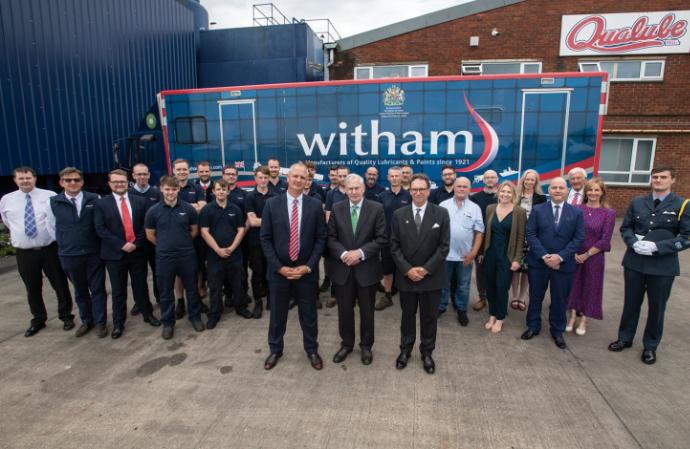
technology called Blendtek, which uses a new unique ultrasound technology to blend its products instead of traditional gas and fossil fuels, resulting in dramatic energy savings for the business, and cleaning up the way lubricants are made. The Duke also had the
biodegradable, extremely long lasting and derived from natural lanolin from sheep wool.
Nigel R Bottom, Managing Director of Witham Group said: “Witham Group is immensely proud of its heritage and the work we are doing to develop new technology to clean up the traditional blending of lubricants. We were honoured and delighted to welcome His Royal Highness to our Lincoln Headquarters to see our manufacturing process and meet the Witham team.”
opportunity to see Witham’s latest environmental range of products, including their award winning Prolan range of lubricants, which are
Deputy Lord Lieutenant of Lincolnshire, Ian Walter added: “The Witham team showed us an impressive set up during the visit and it was extremely interesting to learn more about the world of lubricants and the vast array of products made.”
Next steps for the governance of the Welsh bovine TB Programme was at the top of the agenda when Farmers’ Union of Wales staff and officials met with the Minister for Rural Affairs, Lesley Griffiths, today (25 July) at the Royal Welsh Show.

Dr Hazel Wright, FUW Deputy Head of Policy said:
“We had a constructive discussion with the Minister regarding industry involvement in future bovine TB control policies in Wales. We reiterated many of the concerns outlined in our response to the last Refreshed
TB programme in Wales and we were pleased that the Welsh Government repeated their commitment to partnership working on the future control programme.
“We would warmly welcome the opportunity to engage in all aspects of future TB policy in Wales in order to work together towards the joint aspiration of a TB free Wales.”
As part of the discussion, the union also highlighted concerns relating to the ban on feeding unpasteurised milk to calves on Officially TB Withdrawn premises and reiterated concerns over the lack of epidemiological evidence for this proposal.
“The FUW previously welcomed the establishment of a TB Technical Advisory Group in Wales and we believe that this issue should be examined by this group of experts when it is established with a view to determining the appropriateness of this potential regulatory requirement.
“It is essential that future control and eradication plans consider TB science, cattle welfare, farmer wellbeing and farm finances in equal measure in order to deliver a sustainable and pragmatic programme of TB control for Wales,” added Dr Wright.
ll signs are that the market for beans is growing,driven by the rising interest in adopting a healthy lifestyle and nutritious diet, also by the growing uptake of plant-based and vegan diets. Faba beans provide a good source of protein, fibre, carbohydrates - and are rich in minerals such as calcium, iron, and magnesium.
Michael Shuldham, Pulse Product Manager for LS Plant Breeding Ltd (LSPB) points out that, to match increased end market demand, growers need varieties that that give improved yield and
agronomics – plus improved characters to give crop production of the right quality for end users. "Up to now, enduse of faba beans as a human and animal food crop has been limited by the presence of the anti-nutritional compounds vicine and convicine, which have negative effects on feeding efficiency for pigs and poultry. For humans consuming beans with these compounds, a condition called favism can result, which can trigger symptoms such as headache, vomiting and nausea.(see Notes for Editors for detailed explanation).
"LSPB's introduction of LVC varieties (low vicine/ convicine) means that compounders can increase the level of beans in their rations – and food companies can increase the use of beans in their consumer products."

The first LVC varieties that came out of LSPB's investment in breeding research, such asTiffany, offered end market benefits but with a yield gaphencewere marketed with specialist end user contracts to make their use more viable.
Now LSPB's latest variety Futura all-but-closes this yield gap to just a few percentage points below the top bean variety on the PGRO Descriptive List and is close to the yield of the market-leading variety Lynx.
Futura's agronomic characters are similar to other top varieties except for a lower downy mildew resistance. However, LSPB have LVC varieties already in the pipeline to resolve that.
Michael Shuldham adds: "In Canada, LVC is increasingly an end user requirement and we can foresee that this will happen in the UK, either driven by market demand or by legislation - a situation that is similar to the introduction of double low oilseed rape varieties in the UK.
"All-in-all we see the future of spring beans in the UK is LVC and with Futura, UK bean growers can be ahead of the game."
Futura is on the PGRO Descriptive List of Spring Beans for 2023 as the highest yielding low vicine and convicine (LVC) variety with characters will help to further develop the UK pulse market with end users.

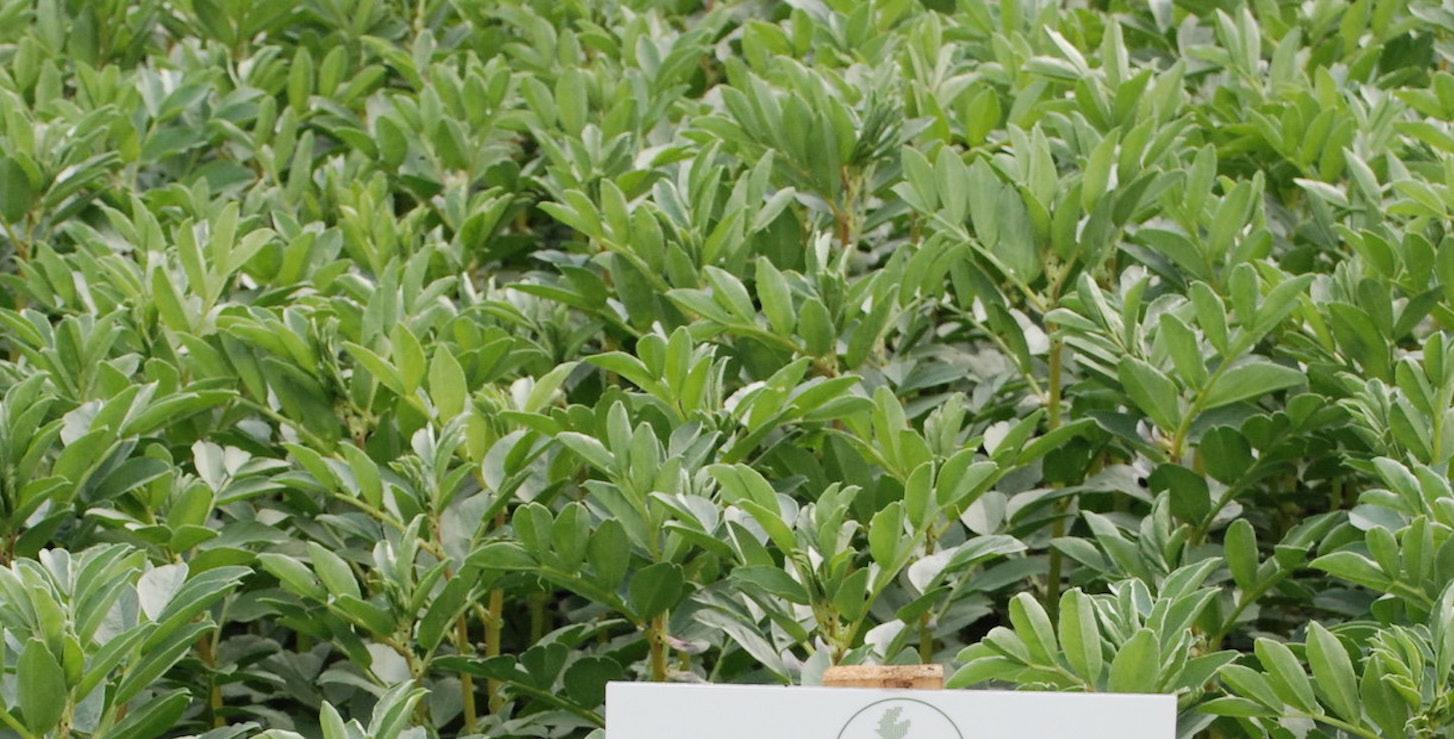
• Premiums on buy back contract for specialist animal feed use
• High seed yield comparable to other leading spring bean varieties

• High standing ability at harvest
The control for yield is the mean of 4 & 5 year varieties (4.24t/ha). Yield differences of less than 7.3% are not statistically different. Other DL varieties are shown for comparison.
Ratings above are 1-9. A high rating indicates that the variety shows the character to a high degree
Oilseed rape growers are being urged to adopt good propyzamide stewardship principles before drilling in the coming weeks.

Corteva Agriscience says field selection, tramline placement and buffer zones should all be considered with the objective of keeping the active ingredient out of watercourses.
Astrokerb and Kerb Flo 500 are the cornerstones of most oilseed rape weed control programmes but are applied in
the winter when rain can lead to run-off without good product stewardship.
“By following some fairly simple principles growers are able to keep the active where it needs to be – in the field, taking out weeds,” says Clare Stapley, Category Manager for Oilseed Rape Herbicides.
“This means your investment is working harder for you, and together we
can protect watercourses as well as the future of these vital active ingredients.”
Propyzamide is a selective, systemic herbicide used to control annual and perennial grasses and certain broadleaved weeds in winter oilseed rape.
Its importance in the herbicide programme has grown in the past decade as it retains the ability to take out grass weeds – most notably blackgrass –which are resistant to many graminicides used in cereal crops. After a heavy rain event there is a risk of propyzamide attached to soil particles getting washed into surface water.
Clare said: “Oilseed rape drilling is already underway in
some parts of the country, but the bulk of the crop will be going in over the next six weeks so it’s a crucial time to consider stewardship.
“Appropriate planning and ongoing management will go a long way towards mitigating the risk to water.”
Clare advises that stewardship begins with field choice.
“Before seed is sown, consider where you will plant your oilseed rape,” she says.
“Grow oilseed rape in a field which doesn’t slope towards water, that is less susceptible to run-off, or is far away from any watercourses.
“Then, when putting in tramlines, ensure they do not provide a direct route for
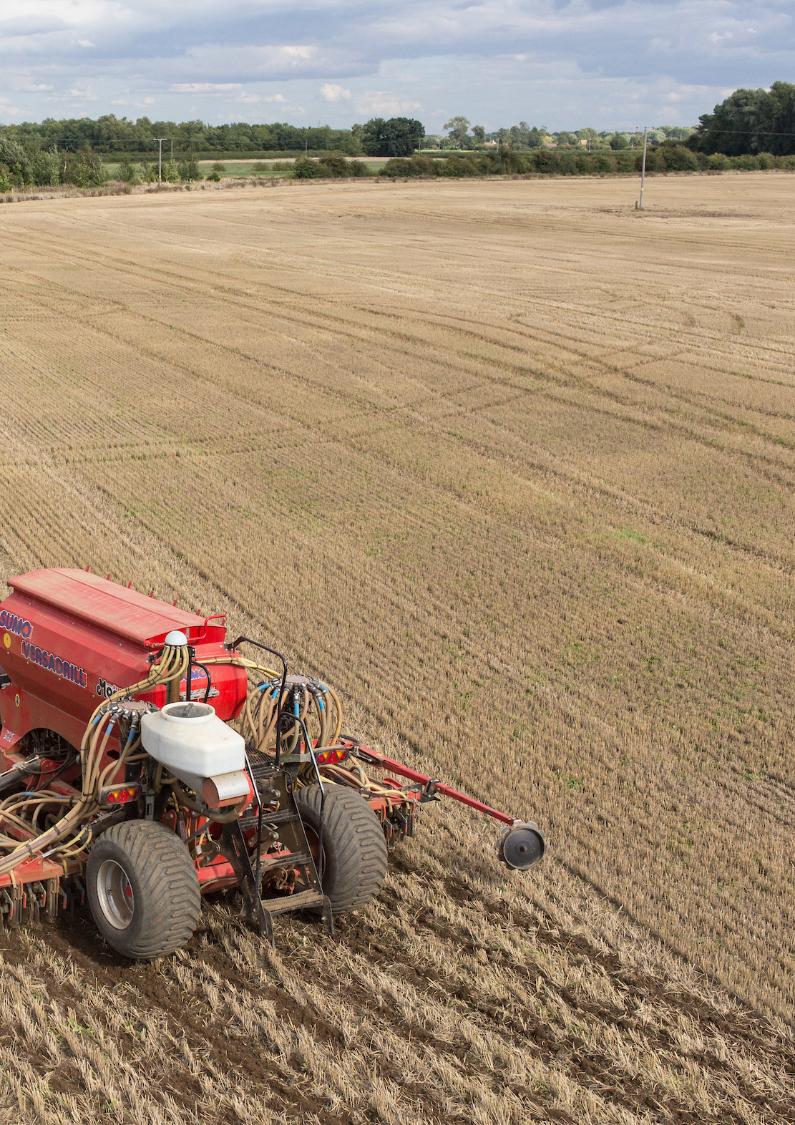
water to leave a field.”
Use of buffer zones to reduce the chance that run-off could reach a watercourse.
The Voluntary Initiative recommends a six-metre buffer, and, if possible wider buffers are advisable in particularly vulnerable areas such as at the bottom of a slope adjacent to a water course.
Establishment technique, direction of working travel, consideration of soil type and topography are also important parameters.
Propyzamide is vital in keeping problematic grassweeds like blackgrass or ryegrass controlled. Following stewardship practices will reduce the risk of it leaving the field, keeping the active ingredient where it is needed.
You can find more information on propyzamide stewardship at www.corteva.co.uk/ ppzstewardship

The average value of an acre of arable land could reach an all-time high by the end of the year, new research from Carter Jonas suggests.
The national property consultant’s latest Farmland Market Update shows pasture values have scaled new heights, reaching £7,683/ acre in the second quarter of 2023. Arable land is currently worth an average of £9,517/acre, which represents a year-on-year increase of 6.4% and is just £650/acre behind the all-time high of £10,167/acre. Best-in-class arable land is selling in excess of £12,000/acre where


Andrew Chandler, the firm’s Head of Rural Agency, said: “The market is not completely sheltered from the broader economic situation, as those buying with a large amount of debt are likely to be hesitant.
“The increasing cost of borrowing may also mean that more land comes to the market as farming businesses reassess their cashflows and release capital from existing assets. But, with a waiting pool of capital and demand showing no signs of slowing, we can expect that increased supply would be met with healthy interest.
“It is evident that scale, location and diversity remains key to many buyers. For the right assets, very strong values are being achieved, and this is reflected in our research figures. But there are hotspots and not-spots – if a farm or land doesn’t tick the right boxes, valuations need to be realistic.”
The previous record for pasture was £7,611/acre, set in 2016 when both arable and grassland reached their previous peak.
“Average pasture land values have now recovered from the losses seen from mid-2016 until early 2019,” says Sophie Davidson, Senior Research Analyst at Carter Jonas. “Average arable land values still remain marginally behind its peak in Q2 2016 but, if it continues its rate of growth, could surpass it by the end of the year.”
An influx of new agricultural land brought muchneeded supply to the market in the past three months. More than 42,500 acres have now been publicly marketed in 2023 – 16% more than in the first half of last year.
Carter Jonas says the market is still being driven by cash buyers, many of whom are holding rollover funds and are yet to find suitable land to invest in.
The uplift in values was seen across almost all regions, with the South West and South East performing particularly well.
demand outstrips supply, and investment or rollover buyers are active.
But the firm’s agents say market dynamics will impact the price sellers can realistically expect to achieve, and the limits to which buyers are prepared to go.
Greater availability of UK farmland in 2023 is allowing buyers to be more choosy over what they invest in, while higher borrowing costs will limit the

“There have been increases in the amount of silt and fen land in the East being traded, pushing average values up 11.1% in the 12 months to quarter two 2023,” adds Sophie.
“Upland values in the North and Yorkshire and the Humber have shifted upwards too and are now 13.2% greater than the same quarter last year, aided by the reassurance received this quarter by upland farmers on access to government schemes.”




wide range of products makes hay harvesting easier and more comfortable enabling the farmer to continuously improve productivity.
- It is summer in many parts of the world, and agriculture never stands still. In fact, the hottest season of the year is a time of intense work for farmers dealing with multiple activities from soil preparation to planting. A central activity is certainly haymaking. To best handle this job, operators rely on a wide range of machinery such as mowers, balers, trailers, tractors, and telehandlers. Each piece of equipment requires tires that provide excellent performance enabling users to constantly improve productivity. BKT caters for these needs by developing tires that provide excellent traction, reduced soil compaction, high load capacity, excellent durability along with great driving comfort. Thus, the Indian multinational companywhich has been attentive to listening to, taking up, and meeting the requests of field operators ever since - becomes the best ally for farmers,
assisting them during every haymaking stage with products designed for the wide range of machinery operating in this season.
BKT's main solutions for haymaking include the versatile top-of-the-range product
AGRIMAX FORCE that is perfect for being fitted on high-power tractors and combines. The tire features IF technology, i.e., it is able to carry heavy loads at a lower inflation pressure than a standard tire ensuring hence reduced soil compaction.


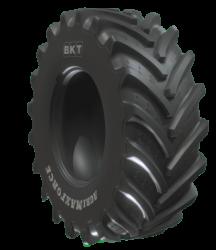

AGRIMAX FORCE provides excellent traction in addition to top self-cleaning properties and best fuel economy making the
tire a perfect ally for farmers. Part of the AGRIMAX range, too, is AGRIMAX TERIS, likewise suitable for high-power harvesters. This BKT tire has been designed for combined operations in which traction and high load capacity turn into outstanding performance.
AGRIMAX FORCE has a special sidewall protector and a reinforced shoulder for increased resistance even under difficult conditions and in the presence of stubbles, extending remarkably the product life-cycle. Another important product is AW 711, a radial tire for combine harvesters but also designed to adapt to the usage in modern agriculture, and in particular for soil tillage
operations. The special tread compound ensures a long product life-cycle, whether used on soft or hard surfaces. In
handling freedom to operators. Not to be missed is AS 504, a tire to be fitted either on telehandlers or trailers boasting exceptional
applications. Thanks to its footprint, which ensures optimum pressure distribution on the ground, FL 635 is a tire that significantly reduces soil compaction while preserving valuable crops. Belonging to the same range, also FLOTATION is a perfect ally for haymaking operations. The tire is particularly recommended whenever traction is essential for good tillage. Given its high load capacity, FLOTATION 558 is the ideal tire for harvesters and hay balers as well as for tank trucks and trailers. There is also
addition, the low rolling resistance during road transfer ensures significant fuel savings.
For lifting operations, instead, which are crucial during the final haymaking stages, BKT offers its MULTIMAX range, which includes tires that operate best with telescopic handlers. A perfect example is MULTIMAX MP 522, a tire providing excellent stability and traction along with exceptional puncture resistance. Particularly resistant to cuts and tears is MULTIMAX MP 527 featuring a robust sidewall to ensure extraordinary stability in lift mode providing maximum
durability and traction, as well as top self-cleaning properties.
For field-to-road transfers when transporting hay bales at the end of processing, BKT provides some of its best tires in the flotation range that excel with top traction and high load capacities. Designed for tractors and trailers, flotation tires provide excellent self-cleaning properties – a key quality in view of long off-theroad trips. An outstanding product in this range is FL 635, a radial tire suitable for both road and field usage. The special block tread pattern has been developed for hay baler
FLOTATION 648, which has some sizes that are suitable for harvesters and hay balers. In fact, the special tread design of FLOTATION 648 enables the transport of very heavy loads at low pressures, ensuring hence reduced soil compaction and protecting crops from damage.
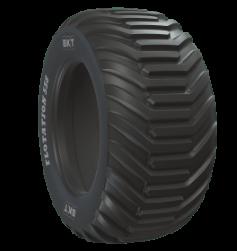


Each of these products is a perfect solution to cater for the needs of farm operators. BKT is daily committed to providing farmers with tires that can facilitate all kinds of operations and increase productivity, even in the hay season.


inter oilseed rape growers in England should consider the benefits of using a companion crop to aid crop establishment; not just to limit cabbage stem flea beetle (CSFB) damage, but also to unlock the Government’s new Sustainable Farming Incentive (SFI) payment. That is the advice from Mike Thornton, head of crop production for agronomy firm, ProCam, who emphasises that growers must consider several important factors before rushing in.
“Using the correct companion crop or blend of crops has clear agronomic benefits when trying to establish a new crop of oilseed rape,” Mr Thornton explains. “In addition to improving soil structure and reducing weed pressure, species such as buckwheat and fenugreek can also reduce insect damage by masking the developing OSR canopy from problem pests including the troublesome cabbage stem flea beetle.
“And with DEFRA offering growers an incentive of £55/ha* to grow a companion crop alongside arable crops, plus another £45/ha** for not using insecticides, the cost of purchasing and establishing the companion crop is negligible, if not completely covered.”
Mr Thornton explains that the ideal companion crop will enhance OSR establishment and protect against CSFB infestation, before being killed off naturally by frosts. “In doing so, the companion crop won’t interfere with or compete against the developing OSR plants as they continue to develop through the winter and into early spring, and won’t incur any costly or timely mechanical or chemical crop destruction charges.”
In terms of companion crop species selection, Mr Thornton advises that it is important to choose varieties suited for planting alongside OSR and to ensure that the chosen seed is of a high quality to maximise germination rates.
“Companion cropping is beneficial for a number of reasons including soil enhancement, pest deterrence and weed suppression, but it is important to ensure the correct type and quality of seed is used to attain these benefits,” Mr Thornton explains.
“To make seed selection simpler, ProCam offers three companion crop mixtures with various ratios of three carefully selected varieties of buckwheat, fenugreek and Berseem clover, all of which have been chosen to give growers flexibility depending on their individual needs and cropping circumstances,” Mr Thornton explains.
“For example, our ‘Shielder’ mixture contains 50% buckwheat (Lifago), 25% berseem clover (Tabor) and 25% fenugreek, all of which play a specific role in boosting OSR establishment.
“Lifago boasts a smaller seed size than standard buckwheat so that it produces a high population of plants. It also makes drilling easier as the buckwheat
seed is of a similar size to OSR seed so the two can be mixed and drilled together.”
The dense canopy that Lifago produces hides and protects the developing oilseed plants from flea beetles as well as improving phosphate mobilisation within the soil. “And because it is susceptible to frosts, Lifago breaks down naturally in the winter to reduce crop competition,” Mr Thornton adds.
For the Berseem clover element, Tabor – the only singlecut variety available in the UK – has been chosen. “This too is easily killed by frost,” Mr Thornton explains, “and doesn’t subsequently regrow. Its main advantage is to improve species diversity within the crop and to promote improvements in soil biology and conditioning. But growers shouldn’t expect it to fix any nitrogen due to the short time for which it will be growing.”
The third element of the Shielder mixture, fenugreek, emits a natural garlic-type odour which deters pests later into the autumn for prolonged defence against cabbage stem flea beetle. “It too is easily destroyed by frost and also promotes improvements in soil biology and conditioning and is therefore of agronomic value to the OSR and subsequent crops.”

Mr Thornton recommends that where soil moisture is plentiful the companion crop should be sown at the same time as the commercial OSR crop. “However, in a dry year where soil moisture is lacking and could impact oilseed establishment, the companion seed should be sown in advance, with the OSR seed introduced once sufficient soil moisture is available. If the latter option is taken, growers might want to choose a hybrid oilseed variety for its extra vigour which will help the crop to grow away later in the autumn.”
Mr Thornton also urges growers to think carefully about weed control options: “Pre-emergence herbicide applications won’t be possible as these have the potential to kill the companion crop,” he explains. “However, a wider range of post-emergence options such as propyzamide, halauxifen-methyl, picloram, and the Clearfield system can be used, but these shouldn’t be applied too soon as early application could diminish the value delivered by the companion crop. The best advice, where feasible, is to wait until the first frost has killed off the companion crop naturally.”
Ultimately, the decision of whether or not to grow a companion crop comes down to growers identifying their biggest priority when trying to establish a new crop of oilseed rape Mr Thornton explains: “If the primary objective is to improve soil condition and reduce cabbage stem flea beetle damage, a companion crop is a good option. On the other hand, if the main goal is weed control, it might be more sensible to grow OSR without a companion crop as this will ensure greater flexibility in terms of herbicide choice.”
The new Syngenta myFIELD app now provides growers with instant access to crop specific weather information and agronomy decision support tools in a single easy to use digital platform that can be tailored to each individual field.
myFIELD includes major developments to Syngenta’s highly popular BlightCast for potato growers and the Quantis Heat Stress Alert forecasting tool, designed to better time biostimulant applications in potatoes, sugar beet and maize crops.


Growers and agronomists can download and customise the free myFIELD for android and iOS phone, reported the system’s developer, Ed Flint.
“Simply downloading and registering MyFIELD will open access to detailed local weather information and warning risks selected to aid agronomy decisions,” he advocated. “By adding in individual fields or cropping blocks, using the integrated Google maps tool, all the information received will be tailored precisely to the specific location and crops.”
Potato growers and agronomists, for example, can receive the latest BlightCastinformation that gives up to 14 days warning of conditions conducive to disease infection and development. The system helps growers to fine-tune in season blight protection strategies to specific pressures.
New for the 2023 season, the BlightCast App now enables users to personalise the parameters that trigger
near miss threshold, to tailor the system’s sensitivity to specific situations and their own risk requirements; the full Hutton period warning remains fixed at nationally recognised humidity and temperature conditions.
“Risks are clearly defined with an easy to interpret green, amber or red alerts, to aid growers’ decision making,” added Ed.
a


The Quantis Heat Stress Alerttool notifies when heat events are forecast to trigger set parameters when crops suffer – in time to take action with preventative applications. Quantis application prior to heat events in potatoes, sugar beet and maize has consistently proven to protect crops from adverse effects and provide longlasting resilience to recover faster
In addition to the live on-screen updates, growers and agronomists can elect to receive email alerts of impending blight risk or impending heat event periods.
“Both BlightCast and Quantis Heat Stress Alert should be used in conjunction withSyngenta Spray Assist, to ensure optimum timing and application techniques to the prevailing weather conditions and assure crops are protected,” advised Ed.
Further Syngenta digital agronomy decision support tools for all crops will be added into the myFIELD App later this season and in future years. Growers and agronomists only need complete their registration details and field plans once, to be available for a tailored agronomy plan in future seasons.

Two new hybrid winter feed barley varieties offering enhanced defence against two of the major yield-robbing winter barley diseases are being launched by Syngenta for planting this autumn.
SY Nephin, which has a UK treated yield of 105% on the AHDB 2023-24 winter barley Recommended List (RL), brings growers the highest Rhynchosporium resistance rating currently available on the RL, says Syngenta seeds technical expert, Ben Urquhart, scoring 8 on the 1-9 scale.
Meanwhile, SY Buzzard, which has a treated yield of 104% on the AHDB winter barley Candidate List, is the first Syngenta hybrid barley available that brings barley yellow dwarf virus (BYDV) tolerance, he adds.
“Rhynchosporium is the number one damaging fungal disease of winter barley, causing yield losses of over 1.5 t/ha as well as having the potential to impact grain quality,” says Mr Urquhart. “BYDV, which is transmitted by aphids, can cause
winter barley yield losses of up to 50%.
“Both SY Nephin and SY Buzzard provide the hybrid vigour benefit of hybrid barley – which is associated with high and stable yields, vigorous rooting and competitive growth against a range of grass weeds. But they also bring other benefits,” he adds.
For SY Nephin, Mr Urquhart says, as well as its 8 rating against Rhynchosporium, these include a high untreated yield of 90% of treated controls on the RL, a high specific weight of 71.4 kg/hl, and barley yellow mosaic virus (BaYMV) resistance.
“Strong Rhynchosporium resistance offers growers potential breathing space if fungicide sprays are unavoidably delayed,” he explains. “In Syngenta trial plots, SY Nephin has also shown good rooting, and produced superior crop establishment to a conventional six-row winter barley following no-till and deep-till cultivations. SY Nephin is also relatively short-strawed compared with other hybrids. Overall, it looks set to be a straightforward hybrid to grow.”
Meanwhile, Mr Urquhart says scenarios in which to consider growing BYDV tolerant SY Buzzard
include: in areas of the country at higher BYDV risk; in fields where delaying drilling to reduce aphid numbers is not possible; and on farms seeking the £45/ha Sustainable Farming Incentive payment by growing the crop with no insecticide.
Mr Urquhart says: “Growing a BYDV tolerant barley is an important part of an overall strategy to manage BYDV risk. In Syngenta trial plots inoculated with BYDV-infected aphids to create high BYDV pressure, SY Buzzard showed only mild virus symptoms and suffered minimal yield loss.
“Other agronomic benefits of SY Buzzard include Rhynchosporium and net blotch resistance ratings of 7 and 6 respectively on the AHDB Candidate List, low levels of lodging and brackling, and resistance to BaYMV. SY Buzzard has also performed particularly well in the East.”
For this autumn, Mr Urquhart says while SY Nephin will be widely available, seed of SY Buzzard is in limited supply. However, its launch marks the start of a pipeline of Syngenta hybrid barleys with BYDV tolerance, he notes.

“Ever since we launched hybrid barley we have been improving the crop’s agronomic characteristics. As well as improved disease tolerance, a big success has come from breeding hybrid barley with higher specific weights. Around one in three winter feed barley fields are now planted with a hybrid,” he adds.

erminal's success as a leading breeder of top-quality grass and clover varieties is highlighted again by this week's publication of the Recommended Grass and Clover List (RGCL) for England and Wales.
The RGCL is an annual reference guide that reflects the highest quality grass and clover varieties, and over the last 35 years, Germinal has developed many high-ranking successful commercial varieties.

In the new 2023/2024 list, AberSevern is the latest of its high sugar grasses to gain
recognition. Germinal's Aber High Sugar Grass (HSG) range has delivered results for farmers since its award-winning launch in 2000.
With a superior energy-protein balance, Aber HSG varieties are proven to reduce the production and release of ammonia, methane and nitrous oxide, created when protein is wasted.Less is excreted too, with trials showing urinary losses of nitrogen are up to 24% lower in dairy cows fed Aber HSG mixtures.
These climate smart grasses contain higher levels of water-soluble carbohydrates (sugars)


compared to other ryegrasses and the readily available energy helps livestock convert more of the protein in forage into milk and meat – up to 6% more milk per cow and 20% higher live weight gains.
Developing grass varieties that combine the benefits of sustainability and productivityis a very real measure of Germinal Horizon breeding team expertise and commitment to forage research.Translating research is vital for success in the challenging agricultural climate and food production landscape.
"This latest RGCL List reinforces the position of
the Aber HSG range as a technology tool for farmers," saysPaul Billings, Managing Director, Germinal UK & Ireland.
"R&D drives the focus ofour business for the future, we are leveraging our specialist knowledge of forage seed innovation to affect change.
"Each year we reach a new level in forage production as innovations in plant science allow pasture-based livestock systems to thrive even as environmental demands increase. Sustainable and profitable ruminant food production is the future."

Perry of Oakley Ltd have been designing and supplying grain handling and drying systems to A T Bone and Sons for 14 years. This started in 2009 with the design and supply of a Perry model M410 roller discharge drier and plant at Cross Oaks Farm.
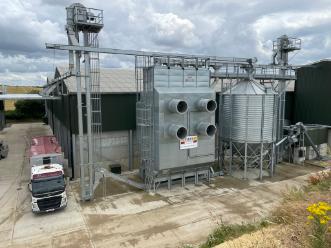
The most recent projects have been at Pilkington Farm Partnership (PFP) which consists of 1,460 Ha of arable cropping. A T Bone and Sons Ltd (ATB) farm this land under a contract farming arrangement and in total farm and contract farm 2,700 Ha for 5 different landowners and their own land. The arable crops are Winter Wheat 1,100 ha, Winter Barley 460ha, Winter OSR 401ha, Winter Beans 147ha, Spring Oats 300ha.
The work at Pilkington Farm Partnership began in 2018 with the design and supply of a complete system on a greenfield site comprising of 120 tph intake pit and cleaning system, wet grain bin, model S614 62 tph Perry Savannah continuous flow drier and 4 belt conveyors to fill a 10,000T floor store divided into 4 bays with a belt conveyor in each. The intake system utilises two Perry curved conveyors with 12m long intake hoppers with control slides this enables the pit to hold 240 tons and to be self emptying. The drier is fed using a feed on demand system with excess grain from the intake going into the wet bin. The drier features a fully galvanised, pneumatic shutter discharge
system to promote consistent grain movement right across the grain column and Tapered air ducts to ensure consistent flow of hot air across the drier. An additional feature is our light grain and chaff recovery system which automatically transfers the chaff or light grain build up in the exhaust plenum back into the discharge section of the drier to minimise cleaning needed in this area. The conveying equipment is from our mid range industrial range and suitable for up to 30,000T per year.
to provide an extra 5000T of storage. PFP carried out a feasibility study to compare the merits of the 2 options and a new floor store worked out as a more economic option when materials, construction and footprint were considered, and also having the large advantage of being much more versatile and multi purpose than silos.
The new floorstore has just been completed and is divided into 4 equal bunkers with a Perry belt conveyor feeding each one to optimise segregation and store filling. These belt conveyors have a remote control system for moving the tripper discharges along the conveyor so the operator can easily see where he is positioning them.
In addition to this in 2022 a 9 channel colour sorter and rotary cleaner system was designed, installed and successfully commissioned onto a mezzanine floor above the intake pit to utilize the unused space above the large intake area. The prime reason for this was for the separation of Ergot from Wheat. PFP have progressively taken more land back in hand in recent years. This has brought more land into the arable rotation and therefore increased the capacity needed for crop storage. In early 2023 Perry’s carried out the design and costing for either silos or an additional floor store
The whole plant including the drier and colour sorter sections is controlled by our own software written in house by our own engineers. The operator can control the plant either from the main screen in the control room or using a tablet when they walk around the site controlling or monitoring the plant remotely. Russell Bone said “ Working with Perry’s over the years has enabled us to make the grain drying and storage more efficient and reliable and their technical support provides the peace of mind you need during harvest”
For more information about the complete range of Perry equipment for grain drying, handling, cleaning or processing please visit our website: www. perryofoakley.co.uk or call 01404 890300 to speak to our sales office or email
sales@perryofoakley.co.uk

Full range of drying, handling & storage, including:
Grain Driers
Savannah or Mistral Series - 5 to 150tph.
Mobile Driers
Agrex Mobile driers - 7 to 42T.
Belt Driers
Perfect for drying most nonflowing products.
Chain & Flight Conveyors
Agricultural, Heavy Duty & Industrial ranges.



Curved Combinations
Feed elevator boots, enter buildings along roofline.
Levelling & Travelling Conveyors
Maximise grain store capacity.


Belt & Bucket Elevators
Single or double lift, up to 1,000tph.
Belt Conveyors
Widths from 300mm to 2,000mm, 1,000tph.
Intake Conveyors
Trench or Mechanical Reception Hopper.
Screw Conveyors
Diameters from 150mm to 1,000mm.
Twin Trace Conveyors
Standard or Heavy Duty specification.
Tote Bins & Silos
Capacities from 1 to 20,000T.
Visit our website to view the full range!
With harvest 2023 started for many, knowing your cost of production per tonne by crop type, is a great opportunity to manage risk and form/ manage a marketing strategy for your 2023 crops. This is especially important considering the higher input costs and lower output prices seen over the past yearwhat is measured, can be managed more easily.Understanding your cost of production and breakeven point can help you to identify what price to sell at to make a profit.
Right now, you might have
started harvest or nearing harvest and will likely have a very good idea of what your crop conditions are currently like. Crop conditions can be assessed by looking at any weed impact, disease, as well as weather impact, both from dry periods and the rain now. Plant counts are also important too. For any harvested crops, you should be starting to get an early indication of yields and quality. While the weather over the next few weeks is impossible to predict, many growers can call upon experience and previous data to estimate yields and quality of this year’s crops.
Additionally, with most costs already spent, you have an accurate idea of what it has cost to produce your crops –both fixed and variable costs (for example fertiliser, crop protection products and fuel). Accuracy is very much key here, especially when splitting variable costs down by crop type.

There are many benefits of budgeting and knowing your cost of production, including managing risk and informing decision making. This information can help inform your marketing plan and help you evaluate what price is
actually a ‘good’ price for your business, as well as assessing your attitude to risk and business position.
Tools likeFarmbench, can help you create a budget.
Farmbench is an online benchmarking tool, designed to compare your business’ performance figures against similar businesses. You can evaluate your fixed costs and, in turn, improve your understanding of the strengths of your business. Farmbench has over 3,000 registered users for a range of comparable farms. If you would like to discuss,you can contact your regional Farmbench Manageror even join a benchmarking group.
What to do with this information?
For the 2023 crops, you should have a relatively accurate cost estimate and can produce a sensitivity analysis for different yield and quality scenarios. You can
then calculate a cost per tonne for each scenario, with the aim to understand at what point you can make a profit for your crop in different outcomes.
This year is important as ever to understand the detail
Looking back, I talked about budgeting around this time in 2021, mentioning volatility in the context of extreme weather impacting grain supply in major exporters. Little could we have predicted an outbreak of war in Ukraine and the significant challenge presented to the industry in price volatility and high costs, with the additional context of changing agricultural policy. Now, global, and domestic grain prices have fallen significantly from highs seen back in May 2022,while costs have fallen too, for many they remain historically elevated, creating a difficult environment for margins. Budgeting and knowing your
cost of production is vital to help decision making in times such as these.
What is the outlook for grain prices? Well, total global grain supply is still set to fulfil global demand, especially with rebounding global maize production. Ukrainian grain is still expected to flow this season, despite Russia withdrawing from the Black Sea Initiative – with grain expected to move via the Danube ports as well as road/rail. However, global wheat supply and demand remains finely balanced, with Northern Hemisphere harvest remaining a key watch point. Looking to the UK, weather will be a key watchpoint now for the harvest of winter crops.
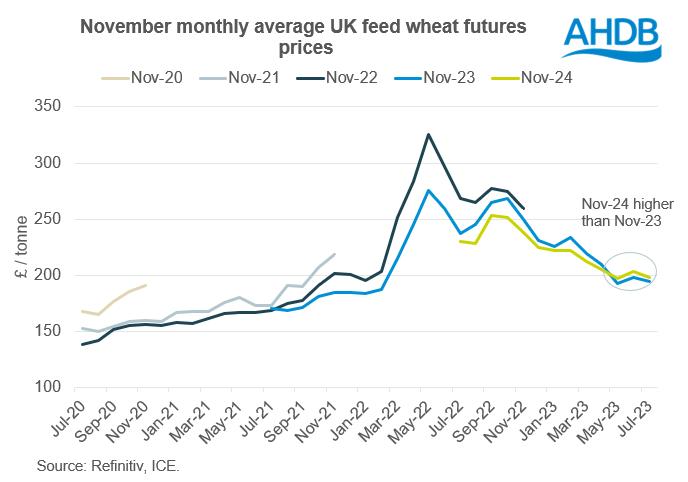
The Port of Immingham has handled over 137,000 tonnes of grain since investing in a new grain handling system.
As preparation for the UK harvest gets underway, the north Lincolnshire port is preparing itself for a busy season of grain handling.
With farmers exporting the last of the large domestic surplus of grain to make way for the 2023 harvest, port owners Associated British Ports are targeting those in central and eastern England to use the port for their business.
The largest port operator invested significantly in grain handling operations earlier this year at the east coast port, with two metal plate bunds which can be set up on any quay on any surface. They can also be sanitised between vessel discharges meaning grain for human consumption can be handled, and a specific standard of cleanliness is met. Using the new Liebherr 420 mobile harbour cranes means faster and more time efficient handling operations.
Located nearby is a weighbridge, essential in ensuring what quantity of grain is being loaded onto the ship. In 2022, 81,000 tonnes of grain passed through the

Humber ports’ quays.
Simon Bird, Regional Director of the Humber ports said: “This is a great achievement in
support of our customers, existing and new. It’s a cost-effective method of ensuring we can load on to any quay in inner dock. It’s a developed and proven capability for operations to receive and load human consumption grains, which is part of our key competitiveness.”

The Humber plays a strategic role in relation to export markets and our continued investment
into infrastructure and equipment maintains our agility and resilience in keeping Britain trading.”

The Port of Immingham is suitably located in north Lincolnshire and is one of the largest ports in the UK by volume of tonnage. It plays an important role in supporting UK supply chains for both imports and exports across Europe and beyond.
The inner dock can take cargo vessels between 4,000 and 27,500 tonnes. With an experienced ops team, strict adherence to Trade Assurance Scheme for Combinable Crops (TASCC) accreditation is another reason why customers choose us.
Since the beginning of this year, operators have already handled over 137,000 tonnes of grain handled by the new grain loading system. On average 250 lorries a day arrive direct from the farm to the vessel, and the grain is directly loaded thus saving on storage costs.
Earlier this year the UK arable sector had a large domestic surplus of grain and to make way for the 2023 harvest, stores will need clearing to make way for the new crop, which is seeing a bumper market in agribulks.
The Port of Immingham’s grain handling facility is open to deep water vessels and can operate around the clock. There is a weighbridge close to the berths, and access points for sampling the cargo adjacent to the quays.
I’ve recently attended what I would deem to describe as the best festival in farming!

In its eighth year, The Groundswell event provides a forum for farmers, and anyone interested in food production or the environment to learn about the theory and practical applications of Conservation Agriculture or regenerative systems, including no-till, cover crops and reintroducing livestock into the arable rotation, with a view to improving soil health.
Groundswell is a practical show aimed at anyone who wants to understand the farmer’s core asset, the soil, and make better informed decisions. It is a two-day event featuring talks, forums and discussions from leading international soil health experts, experienced arable and livestock farmers, agricultural policy experts, direct-drill demonstrations and AgTech innovators.
that they only really needed a good seed drill and not a barn full of expensive cultivating equipment, so Cereals and all those Tillage events were a waste of their time. None of the lectures and very few of the exhibitors talked about the soil, let alone soil biology.
And so, Groundswell began seven years ago and is growing, and it is going from strength to strength. In 2022 they welcomed over 5,500 delegates. This growth reflects the snowballing of interest in Regenerative Agriculture, not only from farmers but also from policy makers attracted by the ‘public benefits’ of such systems such as carbon sequestration and flood/ drought prevention. And then there are the Foodies who go to find new and better ways to join the conversation about how and what we might grow in the future; they don’t need to be told that food tastes better when it grows in healthy soil.

With wide appeal across the food and farming spectrum, Groundswell is relevant for conventional, organic, livestock, arable, landowners or tenant farmers.
The Cherry family started Groundswell out of a sense of frustration that no-one was putting on a Summer Show to which we might want to go. Having gone down the no-till route, they realised

‘Regenerative Agriculture is quite simple: it is any form of farming, ie the production of food or fibre, which at the same time improves the environment. This primarily means regenerating the soil. It’s a direction of travel, not an absolute.’

As a food & fibre producer myself, I feel it’s very much a holistic approach of leaving this land in a better place than we found it which we as a family are well indoctrinated since our farming journey began yet respectfully if transitioning from one

system to another, it’s much more of a challenge. What was probably the most noticeable aspect of this festival was the sheer diversity of those that attended such as farmers, growers, graziers, food campaigners, gardeners, policy makers all keen to learn, share and leave with keenness to improve, and knowledge to integrate all the information, into their own systems.
I left Groundswell completely shattered and if honest quite emotional. Why? Truly I’ve never attended such an event where so many people were fighting the same cause without judgment and one where it was so well organised and with such a wonderful atmosphere of inclusivity & kindness.
It’s a movement that is gathering pace very quickly indeed as consumers are expecting more.
One of the discussions I was most interested in by Helen Browning OBE, Mike Purnell, Judith Batchelar OBE, Catherine Chong and Rosie Boycott was about understanding what exactly constitutes Regenerative Agriculture. What does a farmer have to do to become ‘regenerative’? What is ‘regeneratively produced’ food? This lack of strict rules and focus on principles and context is, to some proponents, what makes regenerative
agriculture so powerful. But to others, it’s a flaw that makes the word open to abuse. This featured voices both in favour and against the idea of certifying ‘regeneratively farmed’ produce. Would a Regenerative certification limit farmer, impede innovation, and wrap them up in additional bureaucracy, or will it create clarity for consumers looking to make good choices in what food and fibre they buy?
As a food campaigner for Love British Food, I’ve noticed a shift from consumers seeking a guarantee that produce they’re purchasing has had very little impact environmentally. But is it too early to certify a set of practices that are still evolving as part of a very complex adaptive system? Should we keep placing labels on everything or is it just another scheme that misleads and confuses consumers like the Red Tractor Scheme that has been controversial in the
past?
Only time will tell but one thing is for sure, that with fantastic efforts from the Groundswell team, conversations like this continue to flourish in an honest fashion. Whilst Regenerative Agriculture isn’t a new concept, it’s a very trendy buzz word that consumers will keep questioning.

To keep up to date with all the Groundswell news head to https://groundswellag.com/



Connect with Groundswell on social media @groundswell_agriculture

Photo credit: Groundswell Festival
Catch up on You Tube https://www.youtube. com/groundswell-agriculture
Host sponsors : Yeo Valley; Affinity Water, Kings Crops, NIAB, Barenbrug, Agricology.

Instagram: @ecoewe
Climatic weather patterns and this year’s challenging potato season have significantly increased the risks of Alternaria. Historically infections have been identified from mid to late July, but have already been reported this season, with instances of serious plant dieback.
Crops that were slow to establish in cold, wet seedbeds, after late planting, have subsequently been hit by prolonged periods of damaging high heat and light stress, along with many growers cutting back on expensive fertiliser inputs. These have all compounded the risk of stresses that make potatoes more susceptible to Alternaria infection, advised Syngenta Technical Manager, Andy Cunningham.

Furthermore, a reduction in mancozeb availability and less use in extended blight programmes during the dry weather has enabled Alternaria to gain a foothold in some crops. “That further exacerbates the issues of spore production and spread across
fields and between crops,” he warned.
“Growers and agronomists should be thinking of including Amphore Plus in their blight strategies now to target Alternaria, possibly one or two sprays earlier in the programme than would be the case in a normal season.”
Successive years of a Syngenta Alternaria monitoring initiative, with sampling and analysis by NIAB, had highlighted the consistent presence of multiple Alternaria species spores throughout the crop growing cycle. However, it was consistently the most prolific A. alternata that was identified infecting potato leaves earliest in the season, followed by the larger lesions of A. solani becoming more prevalent later – frequently on the back of damage caused by earlier A. alternata infection.
“That was a really important finding, which was contrary to potato industry thinking at the time,” pointed out Andy. “It reinforced the importance of Amphore Plus early in the alternaria strategy, as it provides the highest possible loading of
difenoconazole, that is proven more active on A. alternata than other options, as well as being effective against A. solani.
“It also means potatoes are getting the blight protection of the full rate of mandipropamid in the same application.”
Later in the season, agronomists can switch to including Amistar in the blight spray programme for Alternaria protection against the later infecting A. solani, he advised.
Andy highlighted that any fungicide treatment must
be applied preventatively for Alternaria. “However, if you catch infection early, or when just a limited number of plants in the crop have been affected, the clean plants can still be effectively protected,” he added.

He also advocated that managing potato crops to make them more resilient to stress will help better cope with the impact of an Alternaria attack. That could be through mitigating heat stress using Quantis, nutrient stress with fertiliser, or drought stress with irrigation.
“The pressures of stress on potato crops have been increasing year on year, which raises the risk of more significant Alternaria outbreaks.
“Along with increasingly scarce water resources, coupled with the climate patterns of prolonged hot, dry periods, growers could look to a new generation of bioproducts to optimise use of resources and reduce stress on plants, as well as adapting fungicide strategies to incorporate the most effective Alternaria protection.”

Farming has always been about the attention to detail required to get the best from crops and livestock. In spite of generations of labour saving and information gathering devices, there is still nothing quite as good as the human eye at spotting the fine detail and making the correct decision on the day. This is particularly true of the new world of potato storage following the demise of CIPC.
Biox-M, along with the other new suppressants introduced since 2021, are volatile - they want to escape from the store. Keeping the store closed following treatment is enormously important if you wish to have good efficacy. That now seems to be pretty well understood, although we still come across the
occasional incident of stores being opened within a few hours of treatment to remove some freshly treated crop. Volatile products will escape if they are given the chance.
As with other sprout suppressants, there is a small risk of Biox-M condensing or coalescing in store if the crop temperature is not even throughout the store before treatment. Avoiding this risk should be an essential part of store management ahead of fogging. Refrigeration and ambient air exchange should be turned off on the day before treatment and the store should be managed to even up the crop temperature as a matter of routine. A temperature gradient across the store during fogging also risks an uneven distribution of the fog at the very moment that an even distribution is
essential.
Every store is different and should be managed accordingly. It is always good practice to keep records, as detailed as possible, of crop and store condition during the storage season, but most importantly in the lead up and immediately following each treatment. A good set of records of store and crop temperatures, of the date(s) when the store is re-opened and refrigeration or ambient air exchange switched back on, allows the storekeeper to record and assess the factors that deliver the best efficacy, and to work towards extended treatment intervals, as well as to avoid unintended problems.
Biox-M has been in market for more than a decade, and a great many growers have become familiar with the need for attention to detail.
• Is a naturally occurring product, in widespread use in the food industry,
• Is approved for use on organic potato crops,
• Has no harvest interval or MRL beyond the one-day mandatory withholding period after treatment,
• Does not leave persistent residues in the fabric of stores and boxes used for storage,
• And is therefore suitable for use in stores, which may subsequently be used for the storage of other crops or seed potatoes,
• Is effective at higher storage temperatures, reducing the risk of acrylamide development when crop is processed,
• Sequesters carbon during growth, removing 1t of CO2 for every 1,000t of potatoes treated,
• And should be a component of the sustainability plan for every farm and every customer; effectively carbon neutral.





The Farming Minister Mark Spencer has today (6 July 2023) driven a tractor around Parliament Square into the Houses of Parliament to help raise awareness of mental health in farming and rural communities.

The trip around Westminster marks just one segment of the Len’s Light Tractor Relay –which is covering over 2,000 miles from John O’Groats to Land’s End – to shine a spotlight on how mental health can affect those in rural communities and help break
down stigma surrounding mental health in the farming sector.
Len’s Light was launched in June this year by Lynda and Andy Eadon in memory of their son Len Eadon who took his own life in January 2022, and is working with the Farming Community Network, Farm Safety Foundation (Yellow Wellies) and Papyrus to raise awareness and funds to support farmers’ mental health.
The relay comes as the Farm Safety Foundation recently surveyed 450 UK



farmers under the age of 40 and found that 94% of them agreed poor mental health is one of the biggest hidden problems facing the industry today – up from 84% three years ago.
need, including through our Future Farming Resilience Fund and ongoing work with charities such as Yellow Wellies.”
Andy and Lynda Eadon, Founders of Len’s Light, said:
“Len’s Light is a nationwide journey reaching out to everyone in the rural community with the message that no one in the rural community should feel isolated and alone.
“Len’s Light Tractor Relay would not have started if we had not reached out for support from Sir Jeremy Wright MP, Mark Spencer MP, Stephanie Berkeley from the Farm Safety Foundation, and the NFU team – especially Minette Batters and George Bostock.

“With the help of everyone, we will continue to talk about positive mental health in the rural community which hinges around talking, listening and honesty.”
Farming Minister Mark Spencer said:
“It’s hugely important that we raise awareness of the mental health impacts in farming and rural communities and I’d like to pay tribute to all those charities and individuals, including Lynda and Andy, who are working tirelessly to bring this to light.
“I’m honoured to have played even just a small part in this goal by getting behind the wheel today, and will continue to do all I can to ensure farmers can access the support they
Today’s relay builds on other important work to reduce stigma around mental health in farming. Earlier this year, for example, Sam and Emily Stables received Prime Minister Rishi Sunak’s Points of Light award for their work establishing ‘We Are Farming Minds’, a charity that offers a befriending service and dedicated 24-hour helpline staffed by trained volunteers, and provides funding for farmers to access professional counselling services.
The government is investing at least £2.3 billion of additional funding a year by March 2024 to expand and transform mental health services in England so that two million more
people will be able to get the mental health support they need.
Farmers’ mental health and wellbeing are also being prioritised and supported in the government’s Future Farming Resilience Fund, which provides free business support to farmers and land managers in England. This includes support from in-house experts or signposting to external expert services, and the government has worked with the Farm Safety Foundation to provide advice and information on how to identify potential mental health issues and provide tools for addressing them.
The Len’s Light Tractor Relay began at John O’Groats on 20 June, with a specially designed beacon on the front of the tractor lighting up the route. The relay has stopped at livestock markets and machinery depots around the UK to spark conversations around mental health with farmers and others living in rural communities, as well as raising awareness at large agricultural events including the Royal Highland Show. The final leg of the relay will take place at Land’s End on 23 July.
NFU President, Minette Batters, said:
“As an industry we’ve got to make greater strides to talk openly about our mental health and wellbeing. We’re encouraging the farming community to start a conversation with a neighbour, friend or family member. It really could make a huge difference.
“I applaud the bravery of Andy and Lynda Eadon who have worked so tirelessly to shine a light on achieving positive mental health in farming and rural communities. Having lost their own son, they’re both doing all they can to ensure no one in the countryside feels isolated or alone. The Len’s Light tractor relay is an extraordinary and emotional journey by a couple who are determined to make a difference to mental health and wellbeing. On behalf of the NFU we wish them all the very best on their onward journey.”
Stephanie Berkeley, Manager of the Farm Safety Foundation, said:
“There are thousands of farmers struggling with long term ill health in the industry and many more with mental health conditions.
These people are working every day regardless to ensure we have food on our plates.
“Initiatives like this by Lynda and Andyunder the most tragic of circumstancesreally do make a difference. We are so grateful to them and admire them for the hard work and pure determination that making this journey through the country will help raise awareness and prevent another farming family going through the worst of tragedies.”
Ged Flynn, Chief Executive of the national charity PAPYRUS Prevention of Young Suicide, said:
“We would like to say a big thank you to Andy and Lynda Eadon and all those who are supporting their remarkable Len’s Light campaign.
“Their event is raising valuable awareness of suicide prevention which in turn will help us to continue giving hope to young people who are struggling with life.
“Fundraising and generous donations help to pay for potentially life-saving calls, texts and emails to our confidential HOPELINE247 service, which offers support and advice to young people and anyone who is worried about a young person who may be having thoughts of suicide.”
Dr Jude McCann, Chief Executive Officer, The Farming Community Network, said:
"Andy and Lynda and the Len's Light campaign are carrying a vital message of support that is resonating with farmers and people living in rural communities across the UK. None of us should feel alone - we are part of a supportive community that is here to listen, support and help
“No matter what pressures you may be facing, FCN and other farm support charities are here to help people find a positive way forward. FCN volunteers understand farming life and its unique stresses, and can be contacted in confidence 365 days of the year on 03000 111 999 or help@fcn.org.uk."
am proud to be a woman in agriculture. Having been born and raised on the family sheep farm in Norfolk, it was natural for my sister and I to help our parents on the farm from a young age. This gave us both a good grounding in the jobs required around the farm and an understanding of livestock. At the age of 10 I was gifted my very own sheepdog, a sable border collie called Alfie. He never did achieve his full potential as a sheepdog, but he was my very best friend, and it is where my love for dogs started. A love that continues to this day.
I graduated from college and as a young woman, I was driven by ambition to broaden my agricultural experience by working on as many farms as I could at that time to see and learn as much as possible from those around me. I realised very early on in my career that to fit into what is still predominantly considered a man’s world I needed to become accepted as ‘one of the lads’. I vowed to
myself that I would always work hard, get my hands dirty and take on any job required. No excuses because I was a woman!
One of the best things that I did in those early days was to take a leap of faith and travel to New Zealand with a view to broadening my agricultural knowledge and experience further. I went alone and wouldn’t know a single person on arrival. Was I scared? Of course, I was terrified! However, it was for me, the most amazing experience and I would recommend it to anyone. I visited and worked on seven different farms across both North and South islands over the course of six months. Working voluntarily on the farms in return for food and accommodation. I met saw the most wonderful places, formed genuine friendships for life and whilst working on the farms was given the opportunity to study the farm dogs. This sparked a keen interest in other types of stock working dog to the Border Collie, such as the Huntaway, Bearded Collie, Kelpie and New Zealand heading dogs.
I would love to see more women in agriculture. I now can confidently say that I’ve developed a successful career as a contract shepherdess. If anyone is
reading this and wanting to know the secret to being successful in such an enterprise, I believe it is to work hard, have a ‘can do’ attitude and be honest and respectful. It really is that simple.



It goes without saying, that I wouldn’t have achieved much success as a shepherdess without the dogs who have worked so hard alongside me. I owe much of my early



Caitlin Jenkins shares her unique story ofsingle parenthood, farming & her amazing business of training sheepdogs in Norfolk!
contracting career to a dog called Arwen. We were both young with so much to learn and we grew together, it wasn’t perfect, but we got the tasks done. Arwen was loyal to the core, often anticipating what was needed and never leaving me in a muddle. It was the best kid of partnership and cemented my appreciation of just how important the sheepdog is to the shepherd.
I became a mother in my midtwenties and realised I needed to make some changes with regards to work at that time. Agricultural working hours are long and demanding to say the least. I continued to contract during peak periods such as lambing, when I would arrange child cover but on a
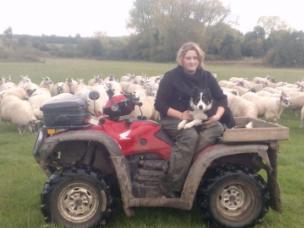


day-to-day basis, I started to train sheepdogs to fit around raising my child.

Having been blessed with many good dogs over the years I am passionate about being able to
Livestock worrying has become a huge problem on farms all over the country. Because of this something I also offer is obedience training with pet dogs around my sheep. The uptake from pet owners on this has been most encouraging and I hope to be able to do my bit to help prevent these distressing and unnecessary incidents in the countryside, raising awareness and encouraging more people to be responsible pet owners.
share my knowledge to help others to get the best from their dogs. I believe in producing good solid, reliable stock working dogs capable of being an asset on any farm. I enjoy helping people with their dogs and knowing that in doing so I am also helping that dog to have a happy fulfilled life.
As a single mother running my own business it certainly isn’t all sunshine and rainbows, it’s hard work in all weathers. I strive to give my daughter the best possible life and would be very proud to see her blossom in the agricultural industry if she should choose to follow that path. I firmly believe that gifting a child an organic up bringing in the countryside, understanding the value of an honest day’s work and knowing where the food on her plate comes from, is truly the best education a parent can give.
@claygates_sheepdogs on Instagram
Caitlin Jenkins, Claygates Sheepdogs.
he world's largest independent renewable energy company, RES, has announced today the acquisition of its 25MW Upper Ogmore Wind Farm and energy storage project in South Wales, by Marubeni.

Welsh Ministers approved the scheme, located near


Blaengarw and Nant-y-Moel in Bridgend in September 2022.
Upper Ogmore was the first onshore wind project to be considered under the Developments of National Significance planning process. RES had been progressing proposals for the seven-turbine wind farm and energy storage project since 2017 from its Cardiff office.
John Boyce, Development Director for Wind in the UK&I, said:"We're really pleased to partner with Marubeni to help deliver Upper Ogmore, a project that will produce clean, secure electricity for thousands of homes.
"This month the world experienced its three hottest days on record and it is projects like Upper Ogmore
that will deliver the practical solutions to climate change, while simultaneously creating cheap electricity and investing millions in the Welsh economy."
TomokiNishino, President &
CEO of MarubeniEuropower Limited, added:"RES has a long and proud history of developing, constructing and operating renewable energy
projects in the UK, as well as around the globe. That knowledge and experience is invaluable, so we know RES has developed a good project in Wales. Marubeni plans to sign an MoU with the UK government which envisages approximately £10 billion of investment in the UK with its partners over the next 10 years. This project would be one of the forefront projects
RES has been active in Wales since the early 1990s and has developed and/or constructed five onshore wind farms in the country.
For further information about the project, visitwww. upperogmore-windfarm.co.uk


nergy Secretary Grant Shapps has challenged JCB to have its superefficient hydrogen machines working on building sites and farms by next year – declaring himself "impressed" with the company's early success in developing engines powered by the zero-carbon fuel.
The Secretary of State for Energy Security and Net Zero visited JCB Power Systems, Derbyshire, yesterday to see the progress a team of more than 150 engineers have made in developing hi-tech hydrogen combustion engines for use in construction and agricultural machinery. More than 50 prototype engines have been produced so far and several machines are currently undergoing testing.

Mr Shapps said: "This is a unique prospect that works well, and I've challenged JCB by the middle of next year - by 2024 - to be operating some of these on our roads and on construction sites. And JCB told me that it will be happy to try and achieve that objective, and good luck to them!"
Mr Shapps was hosted by JCB Chairman Lord Bamford and JCB CEO Graeme Macdonald. He was told how JCB had successfully launched a range of battery-electric compact machines, with more than 20,000 battery-electric machines already sold. He was shown how battery-electric technology was largely unsuitable for heavier equipment due to the higher energy demands, and
the longer working hours of such machinery in remote locations where access to grid connections is limited.
At JCB's Staffordshire proving ground, the Energy Secretary drove a hydrogen-powered JCB backhoe loader and tried his hand at the quick and easy task of refuelling the prototype. Mr Shapps added: "JCB operates in two fundamentally quite difficult areas to decarbonise: construction and agriculture. I have to say they're making decarbonisation look easy, and I've been very impressed with what I've seen."
Lord Bamford said: "It was a pleasure to show the Secretary of State the great progress JCB's British engineers are making in developing a zero-carbon solution to power our future machines. They need to be powered by something other than fossil fuels in the future and super-efficient, affordable, hightech hydrogen combustion engines with zero emissions can be answer for the construction industry and agriculture. What's more, they can be brought to market quickly using our existing supply base."
JCB's emergence as a leader in zero-emission hydrogen technology comes as governments around the world unveil strategies to develop the infrastructure needed to support the use of hydrogen to drive down CO2 emissions. JCB has manufactured engines since 2004, producing around 200 per day at its UK plant in Derbyshire and 200 per day at its plant in Delhi, India.


cotland’s increasing use of renewable energy could make vertical farming techniques more climate friendly than the traditional ways our greens are grown in fields, according to researchers in Aberdeen.
The experts at The James Hutton Institute initially found that using indoor, controlled farming methods for growing lettuce would emit more carbon than traditional open field methods, based on Scottish energy use in 2019.


But that increased use of renewables for power –which accounts for up to 91% of the carbon footprint of vertical farming – could now mean it’s on a par with UK open-field grown lettuce in terms of its environmental credentials.
With 100% renewable electricity and further improvements of the technique, emissions from indoor growing could fall further, to less than other traditional growing methods, including Spanish grown lettuce and lettuce grown in UK heated greenhouses.
vertical farming currently, with the focus mostly on leafy greens and herbs. But there are other crops being grown, such as strawberries and tomatoes, and others are being constantly explored.
“There are also other benefits to vertical farming, such as providing year-round produce that’s not exposed to seasonality and can be grown locally, with less need for storage and pesticides.”
The study was based on a theoretical farm. The researchers now plan to expand their research to work with actual vertical farms across the UK, thanks to new funding from the Scottish Government and industry.
The latest funding will also allow them to look at how facilities could be improved to further improve their environmental credentials, including their full lifecycle footprints.
But even with 100% renewable energy, vertical farming has still yet to achieve carbon neutrality, says Dr Frances Sandison, a life cycle analyst at the Hutton, who led the work.

“There has been mixed evidence around the carbon footprint of vertical farming and it is complex as there are many variables involved,” she says. “But it is a relatively new way to grow food that’s still in a development phase, so there are still many areas that could be improved.
“There are limitations to what can be grown using
Professor Derek Stewart, Director of the Hutton’s £27 million Advanced Plant Growth Centre (AGPC) innovation centre, funded by the UK and Scottish governments, says, “This work, encompassed within the APGC, highlights the need to think wider and deeper when considering the implications of food production.
“Scotland is increasingly a land of renewable energy and this study highlights that this offers the potential for it to also become a leader in the production of sustainable food for the UK and beyond. A shift to fresh produce production could increase the availability of nutritious and highquality food, diminish the UK annual import deficit of £6 billion for fruit and vegetables and create permanent high value jobs.”
More than 15 farms in Yorkshire have adopted solar energy in the last six months arms across Yorkshire are embracing renewable energy and installing solar PV panel systems to help power their operations. In the last six months alone, Yorkshire-based cleantech companyGreen Building
Renewableshas installed over 500kW of solar systems at more than fifteen farms across North Yorkshire and the East Coast out of its Scarborough office.

In a concentrated move towards sustainable agriculture, more than ten working farms, as well as former farms, which have been converted to commercial operations like holiday complexes and manufacturers, have taken a significant step to reduce their energy bills, dependence on the grid, and carbon footprint by installing solar panel and battery storage systems.
Peter Southwell of Southwell and Knapton in Sancton, York, who recently installed solar PV systems on two farms in Sancton and Beverley, said, "We needed to future proof our business from the current and future energy crises. Investing in renewables has allowed us to do this as well reducing our carbon footprint on the farm, which will be increasingly important as we move towards net zero."
"The energy price crisis has dramatically impacted farms over the region and country in the last eighteen months. Installing solar panels allows us to lower our energy bills and be less reliant upon the grid."
June 2023 was the warmest on record in the UK, and hot summers are predicted to be even more frequent. Solar energy, therefore, has the potential to harness even more power for farmers and farms over the summer when their energy usage and costs are high.
The farms, known for their dedication to responsible farming practices, have recognised the urgent need to transition to renewable energy sources. By embracing solar power, they are reducing their reliance on traditional fossil fuels and promoting cleaner air and a healthier ecosystem within the region.

Farm buildings, as well as farmland, are ideally suited for solar panel installations with both roof and ground mounted systems possible due to the amount of space often available on farms.
Investing in solar panels can offer substantial financial benefits for farms. Not only do they reduce energy bills, but they can also generate income through the Smart Export Guarantee (SEG)—an incentive which provides financial rewards for generating renewable electricity and exporting excess power back to the grid. Additionally, solar battery storage systems allow farms to store excess energy during sunny periods and utilise it during high demand, further maximising savings.
The installation of solar panels marks a significant milestone for the agricultural sector in Yorkshire, demonstrating the industry's commitment to sustainability and a low-carbon future. By adopting renewable energy solutions, these farms are taking proactive steps towards achieving the region's ambitious climate goals and inspiring others to follow.
Manor House Farm, an arable farm in Garton-onthe-Wold, recently had a 30KW ground mount solar PV system fitted with three Tesla Powerwall2 installed by Green Building Renewables. Chris Massey of Massey Farmers LTD said, "The agricultural sector faces many challenges in the future. Energy prices have already been one of them. Installing a solar PV system and battery storage protects us from the volatility of prices around fossil fuels. We want to transition towards more sustainable energy systems, and companies
Despite the UK's reputation for cloudy weather, the UK still receives a substantial amount of sunlight throughout the year, making solar energy a very viable option. At the same time, advancements in solar panel technology have significantly improved their efficiency, allowing them to generate electricity even in lower light conditions. Our long summer days are particularly advantageous when generating electricity during the peak summer period.
Managing Director of Green Renewables, Chris Delaney, said "The recent work that our Scarborough Office has done reflects a growing trend that we are seeing across the country of farms, and other commercial buildings, adopting solar energy to power their operations.Energy costs are still very high, having more than doubled in the past five years, and despite a temporary decline over the summer, all evidence suggests that the long-term trend for energy prices is still upwards.For high energy use industries like farming, the payback time on installing a solar PV system is relatively short. When farmers factor in energy storage options and sell surplus energy back to the grid, they can see huge dividends from investing in solar for their farm."
Green Building Renewables is a nationwide network of renewable energy installers. They install both residential and commercial systems and have offices across the country. In Yorkshire, they have offices in York, Scarborough and Doncaster.
Green Building Renewables (GBR) is a nationwide network of local renewable energy experts with over 20 years' experience of installing low carbon and renewable technologies. GBR installs a range of products including air and ground source heat pumps, underfloor heating, solar PV, EV charging, and battery storage.
Green Building Renewables is actively acquiring like-minded renewables businesses to expand its local network across mainland Britain.
Based in York with offices in Doncaster, Scarborough, Daventry, Wellingborough, Colchester, Peterlee, Norwich, Nottingham, Cambridge and Oxford. GBR's Managing Director is Chris Delaney.
Green Building Renewables is anEfficient Building Solutions(EBS) business. EBS acquired the company in 2020.

Efficient Building Solutions (EBS) is a purpose-led business committed to tackling the climate and ecological crises by radically improving the UK's buildings.
EBS combinesdesign, consultancy, product supply and installation of low energy technologiesand products into residential and commercial buildingsthrough itsbusinesses:
• Green Building Renewables(GBR)isgrowing network of local renewables experts.With over 20 years of experiencein the field, itprovidesa range oflow carbon andrenewabletechnologysolutionsincludinga ir and ground source heat pumps,underfloor heating, solar PV,EV charging,and battery storage.
• Green Building Store (GBS)has over 25 years' experience ofhelping to deliverlow energyPassivhausand sustainable buildings. GBSoffersleading-edgeproducts and services includingtriple glazed timber andalu-clad windows and doors, advanced MVHR heat recovery ventilation, specialist airtightness and insulation products, as well as consultancy and building services. GBSislocated inHuddersfieldand Gillingham.
• QODAConsulting- Founded in 2011, engineering consultancy QODA offers a human approach to the design and construction of efficient buildings. Working across mechanical,electricaland sustainable areas of building design, includingPassivhaus.QODA offers expert advice and design support to resolve development issues such as infrastructure planning, building design and refurbishment. QODA has officeslocatedin Oxfordshire, London,Bristoland Norwich.
Philip Fellowes-PrynneisEBS's CEO.EBSis backedbyentrepreneurial private equity firmAnsor.
Green Building Renewables can play a huge role in helping farms to achieve this."
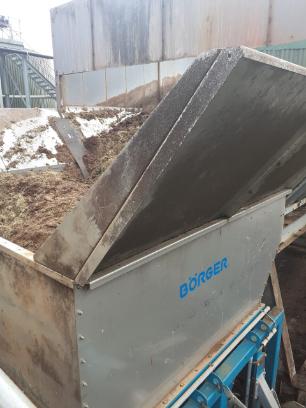

farmer in Wales who decided to diversify into renewable energy could have been tempted perhaps to have built as big an anaerobic digestion plant as possible, but his attention to the economies of scale has paid off.
The biogas plant, from which an impressive 80% of clean, renewable energy is exported, has slotted right into the existing land, rather than the farm having to change to accommodate the new technology.
Seven years ago, the price of energy wasn’t the main driver. The farm had just reached a point where it made sense to diversify, control its costs, and not have all its eggs in the one basket. A decade ago, it had invested in a 250kW wind turbine, and moving forward with a biogas plant that could require plenty of extra work, simplicity was the aim, but with maximum
output.
Producing grass silage and spring barley on the estate, the farmer also has his beef herd to look after, plus 1200 sheep. So, part of that wish for simplicity and importantly, easy maintenance, came in the form of investing in an automated Powerfeed unit from Borger, to convey the organic feedstock of crops, manure and chicken litter.
David Brown, Borger UK’s Managing Director, said: “Our customer did his homework properly; visiting farms to see our existing units in operation, and find out why it had been so strongly recommended. Feedstock for biogas is always going to cause wear and tear on equipment, so he also wanted a UK company that wouldn’t keep them waiting for spare parts.”
The Powerfeed setup, which includes a Borger rotary lobe pump, can integrate into an existing biogas system at an appropriate point in the pressure pipe system to convey the feedstock into the flow pipeline. It is a closed-system, so it prevents
odours from escaping and prevents gas leaks. Only light agitation in the tank is required, so power consumption is kept to a minimum.


Brown added: “After seeing how the process worked for our feedstock, we worked closely with the farmer to slightly modify the Powerfeed, so that it could operate in reverse as well as forwards. When needed, this helps keep everything moving better and prevents any blocking.”
The farmer built a filling hopper to supply the organic matter to the Powerfeed, which is designed with an auger shaft that also breaks down the feedstock and compresses it towards the press channel. This leads to the flushing unit, which is connected to the flow pipeline. The clumps that form in the press channel have the effect of a self-renewing seal. The

substrates obtain a larger surface area, removing trapped air.

Every two and a half to three hours, 2.5 tonnes of organic matter at the farm is fed through by the automated system for the biogas plant, which has primary and secondary tanks (both 1200m3). The farm also benefits from two boilers, which bring the total power output up to 450kW. Once again, that important planning and economies of scale came into play as the existing infrastructure for the wind turbine helped minimise gas-to-grid connection costs for the exported energy.
David Brown from Borger continued: “The plant produces plenty of power, but with the Borger Powerfeed as part of the set-up, the farm also benefits from very good quality digestate at the end of the process. They add farmyard manure to the

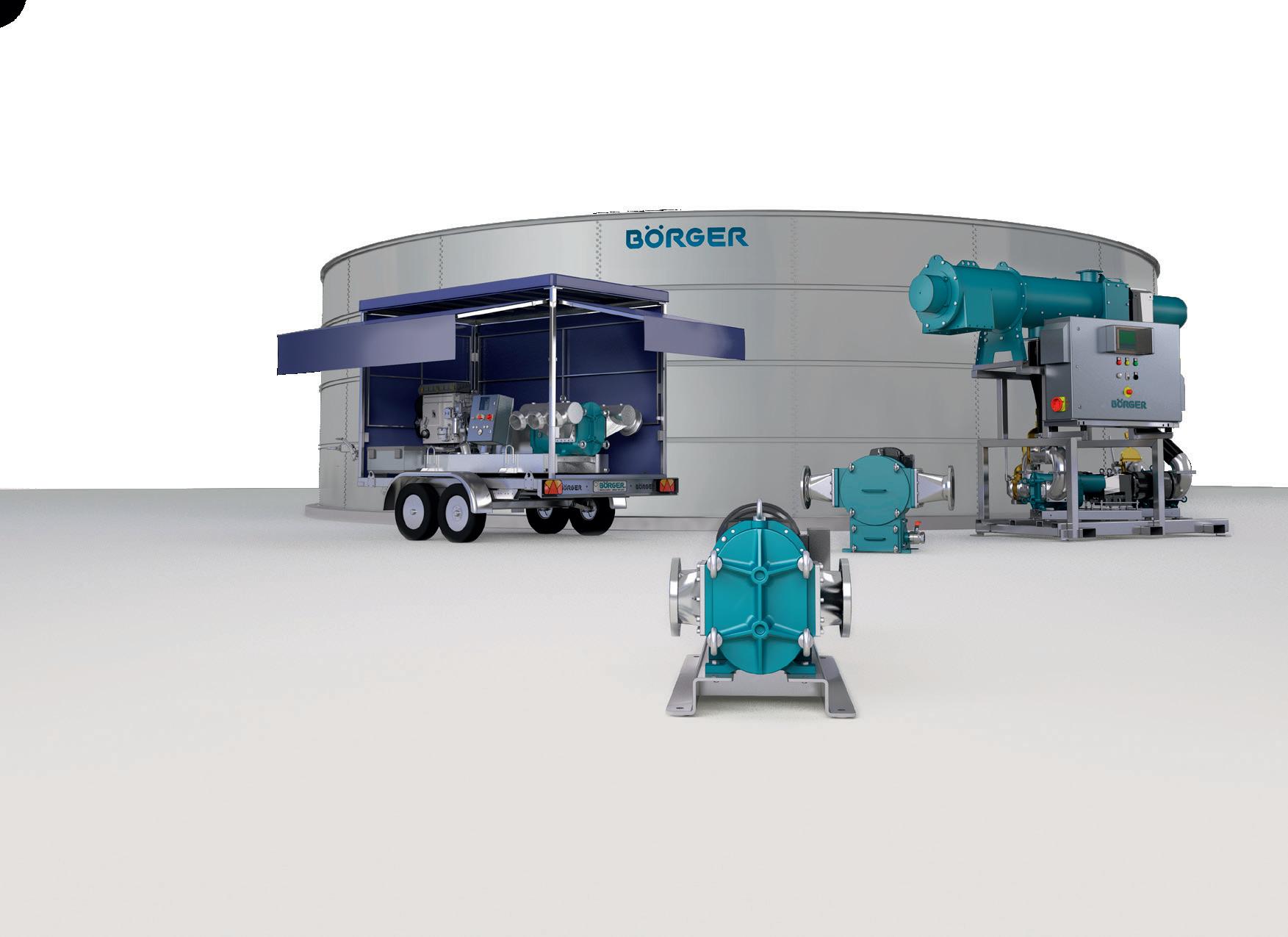
feedstock, which might not produce that much gas, but is very good for the biology. The soil there now is so much
healthier. You can see loads more activity. It’s full or worms! The farm no longer has to buy fertiliser, which as all farmers know, has had a huge increase in price. This has become a big part of being able to keep costs under control. Also, the low pH of the fertiliser at around four to five meant that what they were adding was too acidic, whereas the biogas digestate at a pH of around 7.8 acts more like an alkaline. The whole plant can be monitored remotely. There are very few moving parts in the Borger Powerfeed, so there isn’t excessive wear, but running a biogas plant properly is a 24/7 job, so there is a complete set of spares available to prevent any downtime. “
Borger UK
01902 798 977
www.boerger.com
uk@boerger.com
he Joseph Ash Group takes immense pride in its expansive network of plants in the United Kingdom, from the northern Yorkshire region to southern county of Kent. This month, we turn our attention to our facility in Yorkshire,Premier Galvanizing Hull, to showcase its exceptional capabilities and modern amenities.
The galvanizing industry in Yorkshire flourished during the 19th century, driven by the region’s industrialisation. Hull experienced significant growth in the galvanizing sector thanks to its thriving maritime trade. Situated on the River Humber with a bustling port, Hull became a central hub for importing and exporting goods. Galvanizing was pivotal in safeguarding metal components used in ships, including anchor chains, fittings, and various marine equipment.
Throughout the late 19th and early 20th centuries, the galvanizing industry in Hull continued to thrive. Several galvanizing companies emerged to meet the growing construction, engineering, and agriculture demand. Technological advancements and modernisation in the latter half of the 20th century transformed the galvanizing process, propelling the industry forward.
In 2000,Premier
Galvanizingopened its first plant in Yorkshire. Today, the galvanizing industry in Hull remains a vital sector, serving diverse industries both locally and globally.

Premier Galvanizing Hull is located within the Stoneferry Business Park in the East Ridings of Yorkshire. With an extensive fleet of vehicles, we cater to galvanizing needs in Yorkshire, Nottinghamshire, Teeside, and the Northeast, ensuring timely service for our valued customers.

Whether fabricators require a small amount of steelgalvanizedfor a sculpture or 100 tonnes for a new bridge, Premier Galvanizing Hull is here to assist.
In addition to our core services, Premier Galvanizing Hull offers the following amenities to our customers:
Full technical support: Our comprehensive technical support ensures customers receive guidance and assistance at every stage, guaranteeing a smooth galvanizing process.
before and after the galvanizing process.
Premier Galvanizing Hull’sbath dipping sizemeasures 7.0m x 1.2m x 3.2m, with a maximum dip weight capacity of four tonnes.

At Premier Galvanizing Hull, we fully understand the value of meeting time-sensitive demands and adhering to strict deadlines. We have extended opening hours for drop-offs and collections to ensure optimal customer assistance. Additionally, we provide expedited turnaround times, such as overnight or within 24 hours (by prior arrangements). We aim to deliver prompt and efficient service, catering to your specific requirements.
Collection and delivery service:Regardless of your location or the destination for your fabrications, we provide efficient steel transportation. Our fleet includes two articulated vehicles capable of carrying 22 tonnes each and five rigid vehicles that can accommodate up to 10 tonnes. Shot blasting and powder coating: These services are available through our trusted external subcontractors.
Packing and bundling:We can bundle, pack, and label your steel per your requirements. We can accommodate your needs if you need items delivered to the end user or prepared for export or containerisation. Upon request, we can issue certificates of conformity, and all work is conducted following BS EN ISO 1461 standards.
On-site storage:With ample on-site storage capacity, Premier Galvanizing Hull allows customers to conveniently store materials
At Premier Galvanizing Hull, we prioritise excellence in all aspects of our operations. This includes maintaining the highest occupational health and safety standards, quality management, and environmental management. Our certifications include BS EN ISO 1461, ISO 45001, NQA ISO 9001, ISO 14001, and OHSAS 18001.
The Hull team comprises dedicated individuals with extensive knowledge and experience in their roles. We strive to provide our customers with the highest level of service. We also consider ourselves an integral part of your team, ensuring your needs are met with utmost care and professionalism.
Andrew Tweddleserves as the Divisional Manager at Hull, whileChris Youngoversees the Transport and Production Manager role.
To book your projects with us or for any enquiries, please don’t hesitate tocontact the Premier Galvanizing Hullteam today!


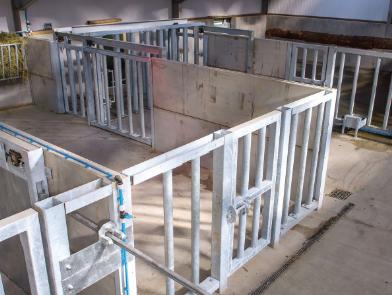




n the United Kingdom, the agricultural sector plays a vital role in providing food and resources for the nation. To ensure the longevity and efficiency of farm buildings, choosing the right roofing and cladding materials is essential. Over the years, metal roofing and cladding have gained significant popularity due to their numerous advantages, including durability, sustainability, and costeffectiveness. This article delves into the benefits and applications of metal roofing and cladding for farm buildings in the UK.
Metal roofing and cladding are known for their exceptional durability and longevity. In the demanding agricultural environment, where structures are exposed to harsh weather conditions, corrosion, and impact, metal roofing and cladding offer robust protection. Steel and aluminum, commonly used metals, have a high strength-to-weight ratio, making them resistant to warping, cracking, and other structural issues. Their non-combustible nature also provides added safety in the event of a fire.
Farm buildings often face extreme weather conditions, including heavy rainfall, snow, strong winds, and even hail.
Metal roofing and cladding systems are designed to withstand these challenges effectively. Properly installed metal roofing panels and cladding sheets form a watertight barrier, preventing leaks and water damage. Additionally, metal's ability to shed snow easily reduces the
risk of structural overload during harsh winters
3. Energy Efficiency
Metal roofing and cladding can contribute to improved energy efficiency on the farm. Some metal coatings have reflective properties that help reduce heat absorption, leading to a cooler interior during hot summer months. By minimizing the demand for artificial cooling, farmers can save on energy costs and reduce their carbon footprint.
In today's environmentally conscious society, sustainability is a key consideration. Metal roofing and cladding are eco-friendly options for farm buildings. Most metal products are made from recycled materials, and they are themselves recyclable at the end of their long service life. Opting for metal not only reduces waste but also supports sustainable practices within the agricultural industry.
While the upfront costs of metal roofing and cladding may be higher compared to some traditional materials, their longterm cost-effectiveness cannot be overlooked. The durability and low maintenance requirements of metal significantly reduce repair and replacement expenses over time. Moreover, the energysaving benefits of metal contribute to further cost savings in the long run.
Metal roofing and cladding systems are designed for ease of installation, which can lead to reduced labor costs and
shorter construction timelines. Additionally, metal offers versatility in terms of design and finishes, allowing farmers to choose from a range of profiles, colors, and coatings to match the aesthetics of their farm buildings.

The lightweight nature of metal roofing and cladding places less stress on the supporting structure, which can be particularly advantageous for older farm buildings that may not have been designed for heavier roofing materials. This can lead to increased building integrity and longevity, as well as potential cost savings by avoiding the need for structural reinforcements.
Metal roofing and cladding offer a plethora of benefits for farm buildings in the United Kingdom. Their durability, weather resistance, energy efficiency, and eco-friendliness make them ideal choices for agricultural structures that face challenging environmental conditions. Additionally, the cost-effectiveness, ease of installation, and design versatility of metal roofing and cladding systems further enhance their appeal. By opting for metal, farmers can invest in a long-lasting, sustainable, and visually appealing roofing and cladding solution that will serve their needs for years to come.
Ultimately, metal roofing and cladding contribute to the modernization and longevity of farm buildings, supporting the growth and development of the agricultural sector in the UK.





Driven by the simple principle of creating a healthy environment and that ventilation is not the volume of air in a building, but critically it is the rate of air exchange, simply clean air in and stale air out - Farmplus design and build to these principles.



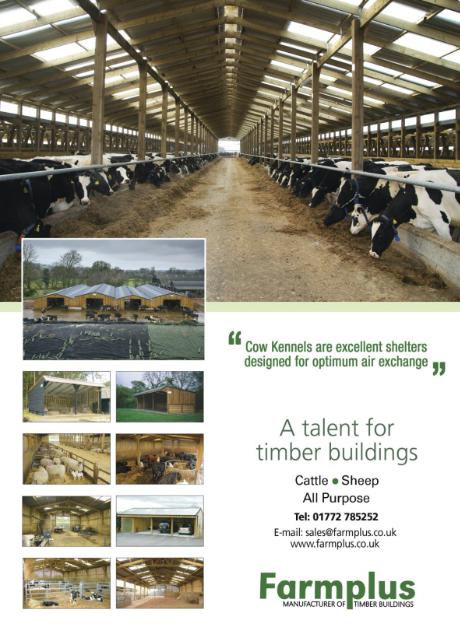

Animals left to nature always try to find shelter in the basic form, they use hedges, walls & natural hollows to get out of or reduce the impact of the winds. Likewise, they will use trees for shade from the sun and shelter from the rain. When we look at buildings we should aim to replicate these basic principles of nature wherever possible. Remember that animals want in the basic form shelter from the wind, rain, shade from the sun, and plenty of fresh air. Ideally giving animals a shelter wall to be able to lie behind with a decent gap above for air to pass over. All air movements need to be above animal height so as not to create a draft.
Depending on the height of the wall, the gap above will often need some form of wind break material to reduce wind speed on bad days.
The best and cheapest form of ventilation is and always will be natural ventilation using the stack effect with sufficient gaps at the low eaves and open ridges. No fans using electricity, no moving parts & nothing to breakdown, so no ongoing expense.


In very high rainfall areas, special ventilated ridge capping’s can be supplied. For most situations, the best ridge treatment is still, simple upturned flashing, for these will make the outside air lift over the ridge of the roof. The base of any upstand should always be at a minimum 50mm (2” inch) back from the top edge of the roof sheet, so any water/rainfall that hits the inside of the upright flashing can then drip of the heal and drain away down the roof sheet.
Animals left to nature always try to find shelter in the basic form, they use hedges, walls & natural hollows to get out of or reduce the impact of the winds. Likewise, they will use trees for shade from the sun.
Thieves who steal expensive GPS technology from farm machinery are being targeted as part of a national crackdown spearheaded byCambridgeshire police.
Since 1 January, there have been 113 reports of thefts of GPS guidance systems used by farmers across Britain.
In response, the force’s Rural Crime Action Team (RCAT) has teamed up with the newlylaunched National Rural Crime Unit (NRCU) on Operation Walrus, which will target the criminals and work on prevention.
Sergeant Tom Nuttall, from the RCAT, said: “Theft of GPS equipment causes farmers much misery and also costs them serious amounts of money so it’s fundamentally important we tackle this increasing problem head-on.
“While there have been arrests and convictions, there is still a lot of work to be done to tackle these organised crime gangs who target farms using sophisticated methods.”
There will be increased patrols of farms, property marking sessions, crime prevention advice for farmers and partnership working with Countryside Watch groups.
Last month, two men from Cambridgeshire were arrested in Northumbria on suspicion of stealing GPS systems from Scotland.
Meanwhile, other forces have secured convictions.
In March, Mantas Dvareckas,
25, of Granville Road, Great Yarmouth, was jailed for two years and six months at Chester Crown Court, having pleaded guilty to the thefts of GPS systems from tractors in Cheshire in October 2021.
Last year, Aidas Cesna, 28, of Webb Street, Lincoln, and Gintaras Jankauskas, 30, of no fixed address, were jailed after admitting conspiring to steal equipment valued at about £380,000 from agricultural vehicles at multiple farms and estates across Essex, between September and October 2021.
In November, Jankauskas was sentenced at Chelmsford Crown Court to three years and 10 months in prison while Cesna received three years at Chester Crown Court in July last year.

Cesna also got a further one year and six months in prison for numerous offences at farms in Cheshire in February last year.
DC Chris Piggott, from the NRCU, said: “These incidents show offenders are willing to travel the length and breadth of the country to steal GPS systems.
“We’re seeing reports of thefts from every part of Britain — not just the arable areas in the east of England— with recent clusters of thefts in north west and north east England and Scotland.
“It looks as though at least two criminal gangs are currently active.
“They are putting a lot of effort into identifying farm equipment fitted with GPS, watching those farms and even using drones to spot opportunities to return at night. They go to great lengths to
get hold of systems, breaking through locked gates and buildings security systems to take GPS from machinery.”
Police are also offering the following advice to farmers:
• Be sure to remove GPS systems, screens and other valuables when leaving vehicles and store securely.
• Park tractors and other agricultural vehicles in secure, alarmed buildings in well-lit areas covered by CCTV.
• Activate PIN security on GPS systems, with your own unique number if available.
• If your system is not PIN enabled, mark your postcode to deter thieves and trace your property back to you.

• Keep tractors and combines with GPS stored out of sight when possible.
• Record serial numbers and photograph your systems.
• Check serial numbers of second-hand systems offered for sale.
The Equipment Theft (Prevention) Bill has today received Royal Assent after months of work between the NFU, NFU Mutual, Home Office, National Rural Crime Unit and other industry organisations.

The Act will give the Home Secretary new powers to make regulations that deter the theft and resale of quads and ATVs (All Terrain Vehicles), whichcost the NFU Mutual £2.2 million in 2021.
Fitting ATVs with immobilisers and forensic markings and ensuring the owners details are registered on a database will help make these essential utility vehicles less attractive for criminals.
NFU Vice President David Exwood said:"Farmers across the country will be delighted that the government and police now have wider powers to tackle increasing incidents of equipment theft on farm.
"Quads are often one of the main things that attract criminals onto farms which often leads to further thefts. But if these new powers can deter criminals in the first instance, I hope they
will drive a reduction in further instances of rural crime.
"This legislation is a big step forward in protecting Britain's farms and I thank Greg Smith MP, Lord Blencathra and the Home Office for working with us so closely on it.
"We now urge the government to pass secondary legislation to widen the scope of the Equipment Theft (Prevention) Act to include other agricultural equipment, especially GPS systems after the stark rise in thefts this year."

Bob Henderson, NFU Mutual's Engineering Lead on Rural Crime, said:"We know the role that measures such as forensic marking, registration and immobilisation play in preventing crime and we have a huge opportunity to protect farmers and tradespeople through this legislation.
"The Equipment Theft Bill receiving Royal Assent comes at a time when we are seeing an increase in theft of vital equipment and machinery."
n ex-SAS military adviser and his daughter have launched a new business specialising in improving farm security and personal safety.
Having spent 22 years working in corporate security following 24 years in the military, Mick Hawkes returned to rural Herefordshire, where he realised how significant the problem of rural crime has become. “The Government and the police seem to do very little to help, and rural crime is a financial, physical and mental burden on farmers,” he says. “I came back to the UK to help people defeat criminals, teaching personal safety and situational awareness with my daughter Keeley. But when I realised the challenges that farmers and rural communities are facing, I decided to see if I could help them with a more practical approach.”
therefore have a strong understanding of farms’ weak points, and know that farmers and farm workers are the first line of defence against criminals.”


Rural theft across the UK cost an estimated £40.5m in 2021, according to NFU Mutual’s annual report, with thieves targeting fuel, livestock and machinery. And the cost increased by over 40% in the first quarter of 2022, with rural crime a worry to 50% of the rural community.
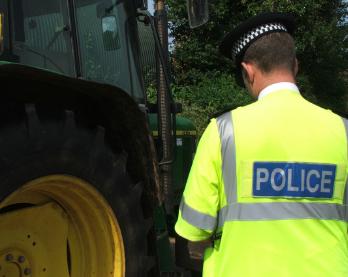
vigilance, and ensuring your own personal safety,” says Mr Hawkes.
He also knows that farmers are on tight budgets, so he is offering a cost-effective approach to farm security, rather than selling expensive security systems. “We can carry out security assessments of vulnerable farms that have been targeted for crime, then recommend cost effective solutions using what they already have, to ensure we keep recommendations realistic.”
Mr Hawkes spent 14 years in the SAS, and as part of his work in Northern Ireland he worked for four years breaking into farm complexes covertly to combat the IRA. He then returned to Hereford, where he taught military students in the art of Close Target Recces, again, working around farms covertly. “I
But it's not just farm theft that is a concern for rural residents –the rise in animal rights extremists breaking into farms is a very real threat, and training in farm security and situational awareness will help producers to combat this. “It’s about knowing what to look out for, general
Mr Hawkes and his daughter also offer personal safety training for farmers, their workers and families. “Keeley trains young people and adults in security, situational awareness and rape prevention, helping them to manage confrontation and keep safe on the streets,” says Mr Hawkes. “If we can maintain zero security incidents working in the world’s crime hotspots, then we can do the same in here in the UK countryside.”
For more information visit www. hawkesandco.uk or call 07929 233092

risk management specialist is urging Britain’s farmers not to relax safety standards after official figures revealed a drop in the number of agricultural work-related fatal injuries.
Latest figures from the Health and Safety Executive (HSE) revealed 21 people were killed in the agriculture sector in 2022/23 – two fewer than last year.
Alex Cormack, of Lycetts Risk Management Services, said: “The drop in the number of fatalities is encouraging, but I would urge those who work in the industry to remain vigilant, and to avoid becoming complacent.

“Agriculture is a dangerous industry to work in, coming second only to construction in the number of annual fatalities.”
A third of all fatal injuries in agriculture were caused by people coming into contact with cattle. This was followed by being struck by an object/ falling from height, contact with machinery/contact with a stationary or fixed object, and contact with a moving vehicle/being trapped by something
collapsing.
Cormack said: “Over the last five years, 64 per cent of all fatalities in the sector involved the self-employed. This suggests that although employers may be conscientious about health and safety measures and training for their staff, they are not giving their own personal safety enough attention.
“The ‘cost-of-business’ crisis is putting a lot of pressure on the agricultural industry, and there could be a danger that in order to make savings, or to save time, some people may be tempted to take risks. This could leave families devastated, and businesses ruined.
“While it is true that some fatalities can be attributed to freak accidents, others could be avoided by adopting a more rigorous approach to safety.
“This includes ensuring risk assessments are thorough, all appropriate training is undertaken, and safety policies are implemented.”



his Farm Safety Week the NFU has launched it's 'Take 5 to Stay Alive' campaign working with the agriculture industry to change attitudes towards farm safety and prevent life-changing and fatal accidents.
The campaign, supporting Yellow Wellies' eleventh Farm Safety Week, encourages everyone working on a farm or in an agricultural setting to take a fiveminute pause and think about the task in front of them, and the safety precautions they could take before starting it. Actions include everything from remembering to put on your seatbelt and engaging the Safe Stop principle when using a vehicle, to wearing a helmet when riding an ATV or staying vigilant when working at height or with livestock.
NFU Vice President David Exwood, said: "People are our most valuable assets, and we should all be
thinking about our safety on farm 365 days a year. But Yellow Wellies' Farm Safety Week is an excellent way for us to come together, raise awareness and share practical advice about how to look after ourselves and each other out in the field. We all have to talk more about safety.
"Our new campaign, 'Take 5 to Stay Alive', gets to the core of this year's theme of 'Farm Safety Starts with Me'. We all know the main causes of on-farm accidents. By taking a few seconds to think before we start a job, it gives us chance to put in place those small, cost effective, life-saving actions which can stop tragic incidents from happening.
"Five minutes or even five seconds could save a life or stop a life-changing accident. By making this small behavioural change, we are protecting the most important part of our businesses - ourselves."
• New video raises awareness of sepsis and its symptoms among farmers
• Farmers at increased risk of sepsis due to nature of their work
• In 2022, NFU Mutual Charitable Trust donated £70,000 to The UK Sepsis Trust
Anew video raising awareness of sepsis and its symptoms among farming and rural communities has been launched by NFU Mutual and The UK Sepsis Trust (UKST).

Five people lose their lives with sepsis every hour in the UK, and farmers are at increased risk due to the nature of their work.
The newly launched video follows the legacy of Hannah Brown, a 26-year old Cumbrian livestock farmer, who tragically passed away on 26th March 2021, just two days after developing sepsis.
The six-minute film features NFU Mutual Rural Affairs Specialist, Hannah Binns, and founder of the UKST, Dr Ron Daniels BEM, discussing onfarm scenarios where farmers, employees and family members could cut, fall or injure themselves, putting themselves at risk of sepsis.
Also known as blood poisoning, sepsis is the immune system's overreaction to an infection or injury. If it isn't treated immediately, it can result in organ failure and death.
The video forms part of the £70,000 donated to UKST by the NFU Mutual Charitable Trust in 2022 to support the charity's work in raising awareness of the risks of sepsis within the rural community.
NFU Mutual Rural Affairs Specialist, Hannah Binns, said:"Farmers are fantastic at looking after the welfare of their animals and stock, but less so when it comes to their own health, having a tendency to crack on, especially during busy periods.
"However, the very nature of farming means farmers can be more prone to grazes, cuts, falls and injuries that can become infected and potentially lead to sepsis.
"Living and working in rural and often isolated settings, means farmers cannot always get medical attention as quickly as they should.
"This video highlights the real risks of contracting sepsis on a farm. By watching it, we hope farmers learn important information that can potentially save lives and livelihoods.
"I'm really proud that the NFU Mutual Charitable Trust is supporting The UK Sepsis Trust's important work to raise awareness of the condition within the farming community."
Dr Ron Daniels BEM, Founder and Joint CEO of The UK Sepsis Trust, added:"Here at The UK Sepsis Trust we're incredibly grateful for the generous support of the NFU Mutual Charitable Trust, which has enabled us to produce this lifesaving film.
"While anyone can get sepsis at any time, and it's not exclusively obtained through infected cuts and scrapes, farmers are one of the key demographics that our charity wanted to help educate following the tragic death of Hannah Brown.
"I hope that this new film will help further Hannah's life-saving legacy, and ensure the farming community doesn't have to experience any more unimaginable tragedies caused by preventable deaths from sepsis."
In September last year, UKST delivered their first campaign to try and grow awareness of sepsis among farmers. The campaign included a moving film in memory of sepsis victim, Hannah Brown.
Farmers can watch the new video athttps://www. nfumutual.co.uk/news-and-stories/nfu-mutualannounces-partnership-with-uk-sepsis-trust/

Tradespeople are being warned to step up security as a crime wave sweeps through construction sites in the UK.
Commercial insurer NFU Mutual’s new research* published today (29 June) reveals almost nine in 10 (89%) tradespeople have experienced theft and crime specialists are warning that the world events, including the conflict in Ukraine, is driving up demand for stolen goods.
Since 2010 NFU Mutual has funded a dedicated vehicle theft unit which shares intelligence, delivers training, and works with police forces across the country and overseas to seize millions of pounds of stolen machinery. The team, which is now part of the new National Construction and Agri Theft Unit (NCATT), is responding to thefts which are hitting both sole traders and large construction firms.
NFU Mutual is warning people not to be complacent as its study finds over three quarters (78%) of tradespeople and contractors admit they have left machinery and tools in a vehicle overnight. Vans are a key target for criminals, with nearly six in ten experiencing theft from their vehicle (58%). And over half (55%) have experienced theft of their items from a building site, as 83% say they have left portable tools and equipment on site overnight.
Tradespeople say the main impacts of these thefts include loss of income (55%) and extra costs to replace or hire new kit (43%), and worryingly over a third reveal theft has an impact on their mental health (34%).
Despite this, the study found an alarming number (43%) of tradespeople don’t have a full list or know the value of what they own which could make it difficult to report crimes to the police or track recovered items back to their owners.
Zoe Knight, Commercial Specialist at NFU Mutual, said: “In the current climate as supply is low and demand for stolen equipment is high we are urging people to step up security.
"Tradespeople rely on their tools for their income and to keep the chain of a project on schedule. As our report findings show, the theft of equipment can have a devasting impact, professionally, financially and mentally.
"It is crucial that tradespersons are
fully supported should the worst happen. The cost of replacing kit and machinery has increased significantly due to supply chain issues in recent times. We are advising tradespeople to know what they own by recording serial numbers and keeping up to date with current market values."
Only 57 percent of respondents said they would be able to produce a complete list of their tools and value, leaving 43 percent without a recorded inventory. Only 41 percent keep photographic evidence of their tools and just 17 percent video their equipment – yet these are quick and easy ways to keep a record.
The study by NFU Mutual comes as the Equipment Theft (Prevention) Bill has passed through the House of Commons and is expected to be signed into law later this summer. It aims to ensure high value tools and machinery are marked, registered, and traceable if stolen, making it harder for thieves to sell stolen tools, and help re-unite them with their owners.
NFU Mutual has been a key contributor in helping shape the Bill and in offering insight at the consultation stage; highlighting the impact of theft, as well as the importance of security, marking tools and keeping an inventory of items.
Detective Constable Chris Piggott, Field Intelligence Officer for the National Construction and Agri Thefts Team (NCATT), added: "In the face of increasing thefts of machinery, tools and vehicles, we are working urgently to disrupt criminal gangs who are operating in this country and overseas. World events including the conflict in Ukraine are driving up demand for stolen goods.
"We welcome NFU Mutual’s study and their support for our work and are urging people to secure their property by using marking, tracking and immobilisation as well recording all serial numbers to aid the police to detect and prosecute criminals.
"We often end up on warrants and searches where numerous high value power tools are located, if serial numbers are not recorded these will be untraceable and cannot returned to their rightful owners. There is nothing more frustrating than having to hand suspected stolen property back to a known offender, because the person who has lost them didn’t take the time to accurately record the information when they purchase them. This ultimately means that we also can’t prosecute and bring offenders to justice, meaning they
can carry on stealing tools without fear of retribution."
Find out more about NFU Mutual’s insurance packages for building trades and tradespeople at www. nfumutual.co.uk/trades-insurance/
NFU Mutual Risk Management Services are sharing the following advice:
• Minimise storage of tools and equipment in vans: a robust, lockable building is preferable with locks which comply with BS3621 where possible. Consider intruder alarms for high value equipment.
• If you have to leave tools and equipment in a van, make sure it’s alarmed and, as a minimum, park against a wall so that doors cannot be opened easily.
• Don’t make it easy for thieves to guess that equipment is kept inside (a van or a building) e.g. by leaving items on display and leaving tools around which may assist an intruder.
• Store portable items within a robust, lockable store that is fixed in place.
• Secure free-standing equipment to fixed point even if within a building e.g. eye bolt in concrete floor with chain and robust padlock. (At least 10mm thickness chain and security grade 5 padlock).
• Restrict and control vehicular access to the work site.
• Consider video security system (temporary systems and temporary intruder alarm systems are available for site use).
• Security mark your tools and equipment (e.g. forensic, engraving or permanent marking) to deter thieves and aid recovery.
• Don’t stockpile high value materials such as lead and copper or leave them around for longer than necessary.
• For construction vehicles use CESAR marking, tracking and immobilisation to prevent and trace thieves.
• Check all locks and security measures before leaving any site e.g. alarms switched on, cameras facing the right direction and security lights working.
Livestock agriculture is perceived to be one of the biggest contributors towards climate change and pollution but could hold a key to creating a sustainable food system, with a positive impact on the environment. By 2050, the global population is expected to reach nearly 10 billion, and to meet dietary demands food production must increase by 70%.
To raise awareness and understanding of the importance of livestock and the role it has to play in feeding the population sustainably, the Agriculture and Horticulture Development Board (AHDB) has partnered with ITN Business to produce news-style programme 'Farming a Greener Future'.
The programme will be anchored by journalist and news presenter Duncan Golestani from the ITN London studioand will look at the positive contribution livestock makes to society.
The programme will explore key themes including:
• Dispelling the myths around livestock agriculture
• Livestock's unique role in providing and supporting nature-based solutions to climate change and nature decline while producing a
nutritious, quality food source
• Delivering food security for a growing global population to support health
AHDB's Divisional Director of Engagement, Will Jackson, said: "The reputation of our industry is a core priority for AHDB, and we are delighted to be able to partner with ITN to deliver a critical message about our livestock industry.

"Too often the public narrative about the impact of livestock is a negative one, while their unique ability to provide both solutions for climate change, nature decline, and food security is either ignored or misunderstood. AHDB hopes to shed light on this and encourages anyone who would like to be part of highlighting livestock's unique abilities to join us in this partnership."
Launching this November, 'Farming a Greener Future' will combine expert interviews, news items and reporter-led sponsored editorial profiles.The programme will be hosted on the ITN Business content hub
and will be supported by a digital advertising campaign. The programme will also be hosted and promoted on NewScientist.com.

Nina Harrison-Bell, Head of ITN Business, spoke about the partnership with AHDB: "This is a really interesting partnership for ITN Business. By partnering with AHDB, we hope to share the many benefits of livestock farming, such as the nutritious food for the global population, the jobs it providesand positive impacts for our planet."
There are commercial opportunities for leading organisations to be featured in the programme and spearhead their own news item. We are looking for organisations contributing towards food security, delivering nature-based solutions and positively impacting the environment, to take part and share their story. If this seems relevant to your work, then please contact ITN Business' Head Programme Director James Linden atJames.Linden@itn. co.ukor Programme DirectorJeff.Blackmore@itn. co.uk
Starting from 13 December, 2023, non-assured UK livestock farmers will be required to provide a declaration signed by a veterinarian following an annual farm visit in order for their products to be eligible for export to the EU.
This new requirement is due to an EU animal health regulation change mandating farms producing animals or products of animal origin (POAO) for export to have regular veterinary visits. The previous temporary requirement, which involved a farmer declaration, will be replaced by this new procedure.

To obtain this declaration, farmers must undergo regular animal health checks conducted by qualified veterinarians.During these visits, the vet will be required to carry out a visual assessment of the farm to confirm freedom of notifiable diseases. No sampling or laboratory testing is required. It is important to note that this does not need to be the sole purpose of the visit and can be combined with other visits covering routine work, providing that all species present at the premises are considered.

The vet visits should occur at least once during a 12-month period. If the visiting vet considers a need for a subsequent visit before the 12month mark, this information will be communicated to the
operator (livestock owner/ keeper) and clearly stated in the declaration.
Farmers who are part of an approved farm assurance scheme already meet the requirement for a veterinary visit. Their participation in the scheme is already noted as part of the food chain information so no additional veterinary declaration is required. Schemes currently approved are: Red Tractor,
agreed to delay the implementation of the new rule by a year, allowing farmers more time to prepare for the change and arrange the necessary vet visits.
While the exact mechanism for the transmission of these new veterinary attestations through the supply chain (from farmer to market to processor) remains unclear, digital solutions are currently under discussion and are being strongly encouraged by various stakeholders.
Quality Meat Scotland (QMS), Farm Assured Welsh Livestock Beef and Lamb Scheme (FAWL) and Welsh Lamb and Beef Producers Ltd (WLBP).
If your farm has had an annual health and welfare review as part of the Animal Health and Welfare Pathway, then this visit will also fulfil the requirements. You will need to retain the receipt from your visit as evidence as official veterinarians certifying goods for export do not have any access to the AHWP database.
Originally, Defra had announced that these regulatory changes would take effect on 13 December, 2022. However, after industry raised concerns, the government
Dr Phil Hadley, AHDB'sInternational Trade Development Director,said: "The UK ships approximately 72% of all its meat exports to the EU. It is particularly significant for the sheep meat sector, with 94% of sheep meat exports destined for the EU with a value of £475 million in 2022. In addition to this, £274 million worth of pig products and £347 million worth of beef meat was exported from the UK to the EU in 2022."
"A large part of AHDB's work concerns securing market access and international trade opportunities on behalf of levy payers, in partnership with the UK government and industry. The organisation's role includes supporting farmers with their export health certification, and with UK meat exports continuing to climb we're focussing on the future to identify new markets for our exporters, ensuring UK meat is enjoyed in more countries around the world."

Recent UK studies show bovine coronavirus (BCoV) as being the most prevalent virus found in routine screening during calf respiratory disease outbreaks.
Calf respiratory disease is widespread (described as inevitable by some farmers) and comes at a high cost from an emotional and business productivity perspective. It’s a classic iceberg disease and one which is continually highlighted as a critical area for overuse of antibiotics. Despite this background, there is an under use of vaccination in the UK cattle sector.
Calf serology on 59 UK farms known to have had a history of respiratory disease issues (2021-2022) reported 91.5% of samples being positive for BCoV (see table 1).
Speaking at the National Youngstock Conference (HAUC, 20th July 2023),
Dr Kat Baxter-Smith from MSD Animal Health UK (a division of Merck & Co., Inc., Rahway, N.J., USA (NYSE: MRK)) suggested coronavirus needed to be taken more seriously as a respiratory pathogen by veterinary practitioners and the UK cattle industry – just as human health experts have had to change their mindest following the Covid-19 pandemic.
“While BCoV is a relatively well-known cause of neonatal calf diarrhoea – and the same virus as the respiratory variant – its role and impact in calf pneumonia has been less well defined. However, our latest diagnostic data certainly shows its overwhelming presence during calf respiratory disease outbreaks in the UK,” she said.
Dr Baxter-Smith explained that there may be a link between initial respiratory infection and intestinal infection because the virus is produced in the respiratory tract and then swallowed with the copious quantities of mucus generated during infection.
“Indeed, an association has been shown recently between detection of BCoV in calf faeces and detection of BCoV in cases of pneumonia on the same farm1,” she said.
She added that the fact BCoV is frequently isolated alongside other, perhaps more recognised respiratory isease pathogens such as BRSV,
M. haemolytica, Pi3 and M. bovis, suggests an interplay between these organisms.
“Research has already shown that BCoV infection disturbs the protective mucus lining of the thoracic tract2. It may therefore be that BCoV ‘opens the door’ for the other viral and bacterial pathogens to establish themselves and cause disease,” she explained.
“Whilst the pathogenicity of BCoV within the BRD complex remains an unknown quantity, its ubiquitous presence in the UK cattle population –and the recent human experience of coronavirus as a significant respiratory pathogen – suggests the need for some re-evaluation.”
“Calf respiratory disease is a multifactorial complex with a range of inciting pathogens often implicated. Consequently, to maintain effective control, it is important for farmers work closely with their vet on the development and implementation of a bespoke action plan for their own farm situation,” recommended Dr Baxter-Smith.
“Maximising a calf’s own ability to resist disease by focusing on excellent colostrum management combined with a robust vaccination programme is key. Essentially, the focus for modern calf rearers should be immunity-led disease prevention – and that’s where the input of a good vet is priceless.
“For example, the vet can quickly help you identify the ‘pinch points’ – or key disease risk areas/ weaknesses – in your system, whether during or shortly after calving, in the individual or group rearing pens, at weaning or in the later growth stages.
“Calves can suffer pneumonia lesions to their lungs from as young as two weeks of age, so early and appropriate vaccination against respiratory disease can often tip the balance towards more effective control,” she said.
Table 1. Calf serology from 59 UK farms with a history of BRD issues (2021-2022). Samples collected via the MSD Animal Health ‘BRDScreen’ pathogen diagnostic service.

Celebrating Excellence in our Young National Stock
The British Charolais Cattle Society is delighted to announce the results of their Youth National Stock Judging Finals on Sunday 22ndJuly. The highlight event in the Society’s brilliantly successful Youth Programme, the Judging Finals this year attracted the strongest competition, with young breeders and
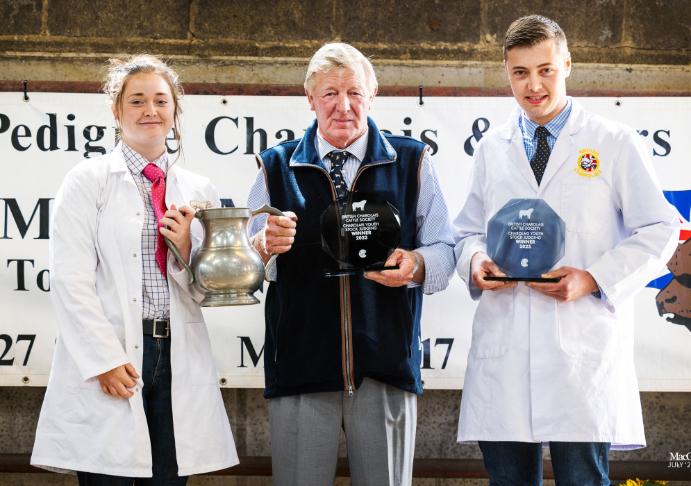

farmers from around the UK gathering to cast their expert eye over world class cattle atone of Britain’s most noted Charolais centres of excellence, the Seawall Herd near Towcester in Northamptonshire.
The Charolais Youth Programme is an industry-leading initiative open to anyone aged from8 to 28, and the Annual Stock Judging Event is the centrepiece of the
programme, showcasing the skills of tomorrow’s Charolais breeders in judging the best of the breed. Winning the Junior Class wasConor Phair from Northern Ireland, the first-place prize in the Intermediate Class was scoped by Scotland’s Gregor Milne with the Scottish Borders representative, Kelly Stott, winning the Senior Class. Winning the Pairs competition were Charlotte Hitchen and Tom Brown representing Yorkshire & North East. This year’s event was the first to be sponsored by Harbro as part of a three-year commitment to support the Charolais Youth Programme, and Harbro experts presented a key seminar on nutrition as part of a busy schedule of demonstrations, seminars, and Q&A sessions that led up to the main business of the day – the judging finals.

The young stock judges were assessed by Master JudgesTracey Nicoll and Iain Millar, thenewly appointedPresident of the British Charolais Cattle Society. “The standard of competition was incredibly high. Right across the age groups these budding young Charolais experts were very good in their judgements and very keen, and the breed is
clearly in safe hands with this younger generation coming through. Both Tracey and I were hugely impressed by their knowledge, enthusiasm, and willingness to learn.
“The eventwas such a success in large part thanks to the kindness and hard work of our hosts, Peter and Sheelagh Donger, their family and their team. I would also like to thank my fellow Master Judge, Tracey Nicoll, and our Stewards, Ben Harman, and Allen Drysdale. And special thanks to Jill Hunter and Michael Richardson from our sponsors Harbro, for their brilliant work with the youth competitors on the day.
“But the biggest thanks go to every one of the 42 entrants who stood up on the day and showed their dedication and their commitment to the Charolais breed. It was very hard indeed to separate them, and I congratulate them all equally. I hope and expect we will see many of them again next year, and I wish them the very best in the Youth Programme in the years to come.”
The RABDF has today (11 July) welcomed details released by the government on regulations set to come into force later this year that will help ensure supply contracts in the dairy sector are fair and transparent, meaning farmers are paid appropriately for their produce.
The regulations deliver on a key commitment set out at the Prime Minister's Farm to Fork Summit earlier this year to help establish stability and accountability across the dairy supply chain. It will enable farmers to challenge prices, stop contract changes from being imposed without an agreement, and ensure farmers can more easily raise concerns.
The regulations have been developed using new powers under the Agriculture Act 2020. The government has worked alongside industry, farmers and processors to ensure they address previous concerns and provide tailored support for those in the industry. The regulations mean:
• Farmers have clearer pricing terms, with contracts setting out the factors which generate the milk price and allowing farmers to challenge prices if they feel this process isn't being followed. This is a major advance in transparency, which ensures fairer pricing and addresses historical discrepancies in the dairy industry.
• Changes to contracts can't be imposed on farmers without their agreement, providing stability and trust in the supply chain. This will encourage dialogue between the parties where changes do need to be made – improving trust within the supply chain.
• Farmers' contracts will all include a straightforward way to raise concerns about their contracts, promoting accountability and timely issue resolution.
• There will be clear rules on notice periods and contractual exclusivity, protecting the rights of both buyers and sellers. This will remove any ambiguity from contracts and protect the rights of both buyers and sellers.
• An enforcement mechanism is created to guarantee the regulations are followed, ensuring a fully fair and transparent dairy industry on a solid foundation to thrive in the future.
Farming Minister Mark Spencer described the regulations as a 'key milestone'.
He said: "Farmers must be paid a fair price for their produce and these regulations will provide price certainty and stability for farmers by establishing written milk purchase agreements with clear and unambiguous terms.
"This represents a key milestone in our commitment to promote fairness and transparency across food supply chains to support farmers and build a stronger future for the industry."
RABDF Chairman Di Wastenage added: "These new regulations will help offer muchneeded security to dairy farmers, giving them the confidence and security to invest in their future and help build a stronger and more resilient dairy sector.
"It is good to see the dairy sector leading the way, with similar regulations to be developed across other farming sectors," she said.
The regulations form part of the government's broader strategy to grow a thriving British food and drink sector which will put more British produce on supermarket shelves in the UK and worldwide.
Regenerative farming can work in all farming systems, explained leading agronomist Helen Dent, Kite Consulting, at last week's (6 July) Down to Earth event in Cumbria. She explained to visitors the fundamental principles and how they should think of feeding their soil the same way they think of feeding their cows. "In both cases, you are feeding microbes," she said.


She broke down the principles of regenerative farming into four key areas for farmers to focus on. They were:
1.Minimise soil disturbance- both chemically and physically
"A lot of soils are not ready for min till," she explained. "It's important you move to min till gradually. Look at your soil and find out what needs doing. The start is only doing what is necessary."
"The microbiology in the soil wants to eat something different. Different plant roots produce different sugars, and the microbes feeding off those sugars give back nutrients to the roots. The more roots in the soil, the more you support the soil microbiology," she added.
Maize is often a plant blamed for contributing to runoff and erosion. Ms Dent explained how it was possible to grow maize without leaving soils bare between rows and cultivations. "Strip tilling can be used to introduce maize, and it can also be undersown, which helps fit the crop into a regen system. It not only makes fields more resilient, but you can have a ready-made cover crop, leading to less nitrogen leaching and providing either a winter grazing or early spring cut.
"Think of the ground as a solar panel and the green leaves are used to harvest the sunlight into energy," she added.
Livestock have an important role in ensuring the regeneration of soil vegetative cover and mineral recycling in grassland ecosystems
Nettex’s Pedigree Cotton Harnesses give sheep farmers access to a high-quality tupping harness with the versatility to fit most makes of crayon markers on the market.

“Made in the UK, the Pedigree Cotton Harness is handmade with high-quality materials at our
manufacturing facility in Staffordshire. Our manufacturing process, which includes hand stitching, ensures harnesses are extremely durable and made to last for multiple seasons with heavy use,” says Emily Hall, livestock farmer and product manager for Nettex.
The Pedigree Cotton Harness features extra
padding in the chest strap and is made from cotton materials to deliver comfort without sharp edges that could cut or chafe rams.
“The durability and quality of the Pedigree Cotton Harness will allow sheep farmers to turn tups out for multiple seasons with the peace of mind that the harnesses are going to work properly,”

concludes Ms Hall. “As sheep farmers servicing fellow sheep farmers, Nettex is committed to providing high-quality tools that can be relied on to help with flock management.”
To learn more about Ram Harnesses and other Nettex products, visit net-tex.co.uk.
hirty years in the hot seat, organizing one of the most important ram sales in Europe, hasn’t dimmed Jane Smith’s enthusiasm. She thoroughly enjoys her demanding role as Executive Director of the NSA Wales & Border Ram Sales.
She came to farming, fresh from years on the international motor racing circuit with her late husband, Robin Smith. That, and a three year stint running Monmouthshire Show meant she was well prepared and successfully negotiated a series of tough interviews before being appointed to run the NSA Wales & Border Ram Sales.
The sight that first year of 22 marquees on the Royal Welsh Showground, housing nearly 10,000 sheep from around 35 breeds, was an indication of the scale of the challenge! And then there were the sheep breeders, for many of whom it was the most important day of the year.
Detail is crucial and it was a steep learning curve, getting a feel of which breeds could be penned together. It’s important that there is a flow to the layout and the proceedings.
Jane Smith recalls:“I had been a showsecretary with Monmouth Show for three years and prior to that motor racing meant I was traveling around the world.
“I thought sheep would be easier, but I didn’t understand the importance of what breeds go together and the importance of the draw and whether the ballot system is right. I try my
utmost to make sure it’s fair and that people get a fair turn over time and aren’t continually at the beginning or end of the sale.

“But people are amazing, one lady was furious about her placing, but she hadn’t told me she hadmarried and moved. So I had no idea that she wasn’t a new vendor. I understand the importance of it all and that people get excited.
Legislation and rules have hugely increased staff numbers and costs. The biggest change came when the Royal Welsh Agricultural Society decided, post Foot & Mouth Disease, that there could be no more sales on grass. The sheep had to move into permanent buildings, ruling out any previous flexibility in terms of penning.
“However If someone is rude I’ll say that I’m happy to talk when they calm down. We’ll sort it. People respect you and usually ring back in a better frame of mind.”
The demands of the job, dealing with sheep and people, haven’t changed. And Jane quickly realized the organization required meant she needs to stay at the showground for a full week before the event. Computerisation brings its own issues, but has made the administration much easier, with a database and ease of input, while internet access has become a necessity.
The general challenges though are very different today from those she faced back in 1993. The legal and health and safety requirements are enormous, with licensing meaning a team has to check each and every licence as the sheep enter and leave.
And the nature of challenge means these tests have ranged from the last minute postponement of the sale when the date conflicted with the funeral of the late Queen Elizabeth II in 2022, to a diesel strike and the impact of a spell of exceptionally hot weather. Jane is grateful that she has always enjoyed the full support of the NSA Wales & Border Committee when she has had to make instant decisions.
She emphasizes:“The committee has always been extremely supportive and we’ve always got out of any scrapes. I really appreciate that and would never have stayed so long if they hadn’t been such great people to work with.”
It’s been a long, challenging, and enormously enjoyable stint and a role that Jane continues to relish. The most memorable occasion being the visit of HRH the Princess Royal to the 40thanniversary sale in 2018. It coincided with Jane having served 25 years and Princess Anne presented her with a framed photograph of her favourite horse, Zeb.
It was the highlight, so far, of an astonishing career.

Sheep farming is a traditional way of life in the Towy Valley and Llandovery has a long history of drovers driving sheep through the town. What is the future for sheep and sheep farming however in the context of our current climate emergency?

A Sheep & the Climate Crisis Forum will take place during September’s Llandovery Sheep Festival. Panelists and guests will discuss the future of sheep farming and sheep and their contribution to solving the changes to the climate.
Llandovery Sheep Festival will take place on 16 and 17 September. The Forum will be in the Castle Hotel from 11am on Saturday, 16 September and everyone is welcome to attend to hear the panellists speak and take part in the debate.
Alan New, a member of the Llandovery Climate Action Group, is organising the event on behalf of the Llandovery Sheep Festival. He said, “Sheep farming is seen to be in trouble. Markets for sheep products are
more difficult to access, food habits are changing to a plantbased diet, wool has little commercial value and sheep are seen as detrimental to the environment. Welsh sheep farmers have reported problems rearing livestock thanks to the recent extreme summer weather. Experts have suggested that climate change could potentially wreck traditional sheep farming in Wales. The Llandovery Sheep Festival is the perfect event to start this open and honest discussion about whether sheep could be a sustainable part of the solution to the climate crisis.”
The panellists for the forum will discuss whether sheep farming can be a part of the solution to climate change Llandovery Sheep festival will be a celebration of rural crafts, food and entertainment, held in the town centre. The weekend-long event will also celebrate old drovers’ trails, sheep farming and the wool industry.
Rachel Everett, Chairman of the Llandovery Sheep Festival, said, “Events such as this are important to the agricultural community, not only in terms of bringing people together, but
also in terms of showcasing the best of local produce, goods and services. The concept behind this community-led festival is to showcase the best of Llandovery, to share its cultural identity and historical past through the promotion of the wool industry and the local farming economy. This year’s packed programme will certainly not disappoint and will have something for everyone.”
The town’s Market Square and Castle carpark will be a kaleidoscope of colour during the event in September with almost 100 exhibitors displaying their wares from textiles, arts and crafts to locally produced food and drink. The streets of Llandovery will be packed with entertainment and music. There will also be a wide range of workshops and courses.
Rachel wants to bring people together to make this year’s Festival as inclusive as possible. If you would be interested in sponsoring the event or volunteering to help please get in touch. Email: info@llandoverysheepfestival. co.uk
A£2.9m project from DEFRA's Farming Innovation Programme to breed sheep with a naturally low carbon footprint will use data and research from the Harper Adams Lleyn flock.
Delivered by Innovate UK, the ‘Breed for CH4ngeBreeding Low Methane Sheep’ project led by Innovis, a leading supplier of performance-recorded rams, aims to help English sheep farmers lower their carbon footprint and support agriculture’s journey towards net zero.
Over three years, the project will measure methane emissions from a total of 13,500 sheep across 45 flocks, and will use the data produced to build and develop tools to genetically reduce methane emissions and improve the efficiency of the national flock. The project will eventually demonstrate the impact of low-carbon sheep on whole farm carbon footprints.
Scientific input, technology and additional genetics expertise will be provided at institutions including Harper Adams University, whereDr Sarah Morgan, Beef and Sheep Production Lecturer,
will be leading the research. She said: “This project will be taking data ‘from the field’ including here on the Harper Adams Future Farm, and feeding it right back into the industry – working with a vast range of partners on a multi-million pound project.”
“We are delighted to be offering our research expertise – and our performance-recorded Lleyn flock – as part of the work, and it is great to know our data will be helping develop sheep which are both better for farmers and better for the environment.”
Three other members of Harper Adams staff –Innovation ManagerDr EricSiquerios, Elizabeth Creak Chair in Agri-Tech Economic ModellingProfesssorKarl Behrendtand Animal Production and Health LecturerNicky Naylor– will also be helping develop the project.
Nicky added: “This research is also going to support a number of final year student projects – so this work will not only benefit our flock, but will also benefit our students – as well as benefit the wider industry.”
Other sheep breeder groups

involved include the Sheep Improvement Group (SIG), breeding the Exlana, Performance Recorded Lleyn Breeders (PRLB) and the Centurion Group of Dorset Sheep Breeders who will assist delivery of the research and host on farm events, and Signet Breeding Services, part of AHDB, providing performance recording services.
Industry and supply chain partners – Centre for Innovation Excellence in Livestock (CIEL), Pilgrims Pride and Waitrose, will steer farm system modelling including the use of carbon calculators and drive an integrated knowledge exchange (KE) programme. The National Sheep Association (NSA) will link with the wider industry and offer a ‘guiding hand’ regarding policy issues. Additional scientific input, technology and genetics expertise will be provided by Scotland’s Rural College (SRUC).
Innovis chief executive, Dewi Jones said: “We are an alliance of forward-thinking sheep farmers and commercially driven breeders applying genetic science and using
performance-recording to deliver profitable maternal genetics at significant scale, all of which are designed to make the most efficient use of grass and forage to produce sustainable and healthy lamb of high nutritive value. Making use of grasslands by way of sheep grazing also helps sequester carbon into the soil.”
“This partnership unifies us with academics, a key lamb supply-chain and industry bodies whose networks extend to thousands of English and UK sheep farmers. We’ve all delivered many successful projects, applied research results onfarm and communicated with a wide audience but never before combined forces; ‘Breed for Ch4ange’ will consequently build on and strengthen existing relationships.”
The project will initially develop on-farm protocols and use new innovative tools and technologies including Portable Accumulation Chambers (PAC) to predict methane emissions from grazing sheep alongside measures of health, production and efficiency traits at the individual animal level. Further measurements,
including rumen size and microbiota, will improve understanding of underlying biology and ensure that reductions in methane emissions positively contribute to sustainable genetic improvement of ewe productivity on UK grass and forage.
The information gathered will enable understanding of the relationships between and genetic control of these characteristics, and DNA sampling will allow the underlying genome of the sheep to be investigated. This will help develop tools to compare the breeding value of sheep in the flocks, identifying stock that will contribute to a lower farm carbon footprint.
Dr Mark Young of CIEL added: “Modern genetic tools provide the means to focus in on hard to measure traits like methane production then incorporate them into balanced breeding programmes using DNA based genomics tools. The wider breeding programmes that Innovis, PRLB, SIG and Centurion run use such tools very effectively so they are well-placed to reduce emissions and improve the efficiency of sheep production using genetics. This is greatly needed to
Further plans could see a communication programme developed for other sheep breeders and farmers throughout England, working alongside supply chain partners and wider industry bodies, including NSA. This will identify the most effective ways of communicating the project’s outputs and implications to other farmers and help support them to make genetic changes.
Dewi Jones adds: “We collectively believe that this project will help to further improve the sustainability of our sheep by using genetic science and breeding to naturally reduce the amount of methane, which is a natural by-product of the sheep’s forage digestion process. Combined with the integrated knowledge exchange programme, we have an initiative that will ultimately reduce flock carbon footprint and help improve sheep farmers’ productivity, sustainability, resilience and profitability.”
Twin row-crop wheels have been introduced for the Vervaet Quad 550 self-propelled slurry applicator by UK importer J Riley. This new wheel option was first used on the continent last year and has now been made available to British customers. Two UK contractors are using dual rowcrops this season, and a third customer has specified slightly single wider intermediate wheels to work with a variety of row widths.
The dual row-crop wheels are configured with a 75cm spacing which allows spreading to be carried out post-drilling and through young maize without causing damage to the crop. This allows an additional dose of digestate to be spread on the growing maize and also extends the working season for contractors by an extra three to four weeks.
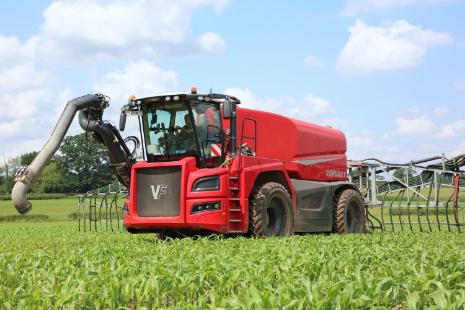
With a tank capacity of 22m3 the Quad is a large

machine, but the dual wheel format spreads its weight across a considerable area to minimise compaction and avoid creating ruts. Rather than fitting single row crop wheels with add-on dualwheels, the heavy-duty twin row-crops are welded solid, effectively creating a single wheel with a pan and rim each side of a strong tubular centre
section. In common with the Quad’s conventional wheels, a variety of tyre sizes and options are available, although the most popular tyre is Michelin’s SprayBib VF 380.90R46.
“The Quad’s versatility is invaluable in allowing contractors and growers to prolong the spreading window and maximise their usage of digestate as a renewable and sustainable nutrient source,” explains Matt Carse, managing director at J Riley
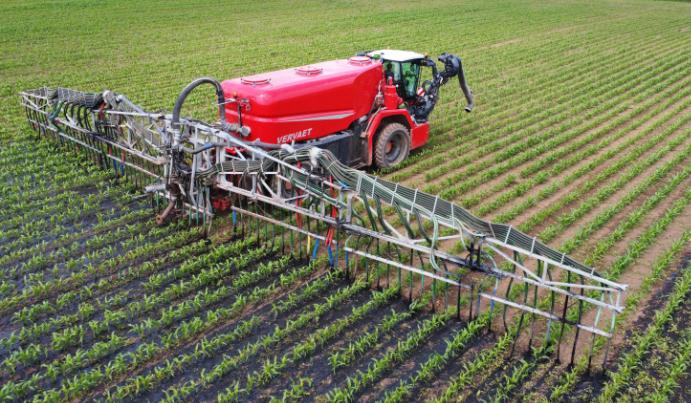
Beet Harvesters (UK) Ltd. “The dual row-crops make it possible to apply digestate with minimal crop damage when historically you couldn’t. In addition, two contractors have now removed the rear tankers from their Quad XL outfits to run solo through the crop. The tankers can be re-attached for working on stubble after harvest when maximum capacity is again the aim, making the Quad the most versatile and flexible machine on the market.”

British farming is a crucial pillar of the nation's economy, supplying a wide array of agricultural products to meet both domestic and international demands. As part of sustainable agricultural practices, the use of slurry tanks has become increasingly vital in managing waste and optimising resource utilisation. However, these tanks come with inherent health and safety risks that demand careful attention. In this article, we will explore the importance of slurry tanks in British farming, the potential hazards they pose, and the key considerations necessary to ensure the well-being of farmers and the environment.
Slurry tanks play an indispensable role in British farming, particularly in the management of livestock waste. As a nation known for its vibrant agricultural sector, the UK houses numerous dairy and livestock farms that generate substantial amounts of animal manure. Slurry tanks are employed to store and handle this organic waste efficiently. The recycling of animal manure into nutrient-rich fertilisers helps improve soil quality and crop productivity, contributing to sustainable and environmentally friendly agricultural practices.
Despite their importance, slurry tanks can pose significant health and safety risks if not managed properly. Some of the primary concerns in British farming include:
1. Toxic Gas Emissions: Slurry tanks can emit toxic gases such as hydrogen sulphide and methane during the decomposition of organic matter. Farmers working in and around these tanks face the risk of gas exposure, leading to serious health complications or even fatal incidents.
2. Chemical Hazards: In certain farming practices, slurry tanks may contain chemical additives or cleaning agents. Accidental spills or improper handling of these substances can lead to chemical exposures, posing risks to farmers' health and the environment.
3. Structural Integrity: Aging slurry tanks or inadequate maintenance can compromise their structural integrity, potentially leading to leaks, spills, or tank failures. Such incidents can result in environmental contamination and jeopardise the well-being of farm workers.
4. Slips, Trips, and Falls: The areas surrounding slurry tanks can be slippery due to spills or wet surfaces. Farmers may be at risk of slips, trips, and falls, causing injuries and lost productivity.
To ensure the safe use of slurry tanks in British farming, the following key considerations should be emphasised:
1. Training and Education: Farmers and farm workers should receive comprehensive training on the safe operation of slurry tanks, potential hazards, and the correct use of personal protective equipment (PPE). Knowledgeable and informed personnel are the first line of defence against accidents.
2. Ventilation and Gas Monitoring: Adequate ventilation should be provided in and around slurry tanks to prevent the buildup of toxic gases. Regular monitoring of gas levels should be conducted to ensure a safe working environment.
3. Regular Maintenance and Inspection: Farm owners should implement a routine maintenance schedule and conduct regular inspections of slurry tanks to identify and address potential issues promptly. Early detection of structural problems can prevent more significant incidents.
4. Emergency Response Preparedness: A robust emergency response plan, including evacuation procedures and first aid measures, should be in place to handle any accidents or gas leaks effectively.
5. Environmental Protection: Implementing secondary containment structures and spillage prevention measures can help protect the environment in case of tank failures or accidents.
In British farming, the use of slurry tanks is instrumental in sustainable waste management and resource optimisation. However, the potential health and safety risks associated with these tanks cannot be ignored. By prioritising farmer education, ensuring proper maintenance and ventilation, and implementing comprehensive safety protocols, the agricultural sector can harness the full potential of slurry tanks while safeguarding the health of farmers and the environment. Embracing a proactive approach to health and safety will strengthen British farming's foundation, paving the way for a prosperous and sustainable future.




In the world of modern agriculture, efficiency and precision are paramount to maximise productivity while minimising environmental impact. Vogelsang, a renowned agricultural machinery manufacturer, has addressed these challenges with their latest innovation, UniSpread. This ultra-agile and superefficient spreader is compact, versatile, and designed to deliver top-notch results. By offering a range of features, including easy installation and retrofitting, a durable UV-resistant hose material, a high-precision distributor, and a chassis-mounted system, UniSpread stands out as the top choice for farmers seeking optimal spreading solutions.
UniSpread boasts a compact and versatile design, making it a versatile tool for a variety of agricultural applications. Farmers can choose to use it as a dribble bar or a trailing shoe, depending on their specific needs. This adaptability allows farmers to cater to different crops, terrains, and field sizes without the need for multiple spreading systems. By choosing UniSpread, farmers can save time, money, and storage space while optimising their spreading operations.

















One of the most significant advantages of UniSpread is its easy installation and retrofitting process. With a small linkage and low overall weight, integrating UniSpread into existing agricultural machinery is a seamless process. This feature is especially advantageous for farmers who wish to upgrade their spreading systems without investing in entirely new equipment. By reducing downtime and simplifying the installation process, UniSpread helps farmers improve their operational efficiency and reduce the disruptions to their farming schedules.









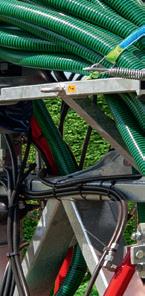




Vogelsang understands the importance of durability in agricultural equipment, particularly when exposed to harsh environmental conditions. UniSpread addresses this concern by employing a durable UV-resistant hose material in its construction. This ensures that the hoses are protected from the damaging effects of sunlight and other external elements, prolonging the lifespan of the spreader and reducing maintenance costs. Farmers can rely on UniSpread to perform optimally even after extended periods of use, providing excellent value for their investment.
UniSpread: the ultra-agile and super-efficient spreader by Vogelsang


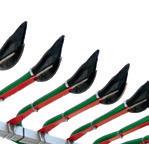
Compact and versatile: choose our UniSpread and use it as a dribble bar or trailing shoe. Benefit from easy installation and retrofitting, small linkage with low overall weight, durable UV-resistant hose material, a high precision distributor and a chassis mounted system. Spread the news – UniSpread is the top choice for best results!




sales.uk@vogelsang.info | 01270 216 600













vogelsang.info

Achieving precise spreading patterns is crucial for maximising the efficiency of fertilisation and minimising resource wastage. UniSpread's highprecision distributor ensures accurate distribution of fertilisers, manure, or other substances, ensuring uniform coverage across the field. This feature minimises the risk of over-application or under-application of materials, which can be detrimental to crop health and yields. By promoting precise spreading, UniSpread contributes to sustainable agricultural practices and helps farmers achieve higher productivity while conserving resources.
UniSpread's chassis-mounted system is another notable feature that sets it apart from conventional spreading equipment. By integrating the spreader directly onto the chassis, UniSpread offers superior stability and weight distribution. This design eliminates the need for a separate support structure, reducing the risk of accidents and damage to the spreader during operation. The chassis-mounted system also enhances the manoeuvrability of the machinery, allowing farmers to navigate through narrow field paths and challenging terrains with ease.
In conclusion, UniSpread by Vogelsang is an
exceptional agricultural spreader that combines ultra-agile design with super-efficient functionality. Its compact and versatile features enable farmers to adapt the spreader to different applications effortlessly. Additionally, UniSpread's easy installation and retrofitting process, combined with its durable UV-resistant hose material, ensure longlasting performance and reduced maintenance costs.

The high-precision distributor ensures accurate spreading patterns, optimising fertilisation and minimising resource wastage. Moreover, UniSpread's chassis-mounted system provides enhanced stability, weight distribution, and manoeuvrability, enhancing safety and performance during operation.
For farmers seeking the best results and looking to streamline their spreading operations, UniSpread stands out as the top choice. With Vogelsang's commitment to innovation and excellence, UniSpread is a testament to the company's dedication to advancing agricultural practices and empowering farmers with efficient, reliable, and sustainable solutions. As the agriculture industry continues to evolve, UniSpread remains at the forefront, revolutionising spreading technology and contributing to a more productive and environmentally friendly future.

t a time when interest rates are on an upward trend, Kubota (UK) Ltd has introduced a collection of generous finance schemes for its M-series tractor range. Available across all models of M-series, the 0% finance schemes focus on fixing the cost of ownership by including two specific Kubota Care fiveyear warranty packages. The first scheme is for M4003, M5002 and M6001U models, which provides a 0% finance offer for new purchases up to a maximum value of 50% of the RRP, and
is based on 2+22 monthly payments. This scheme also includes a five year/2,000hour Kubota Care warranty for M4003, M5002 and M6001U models.


The second scheme is for the 123-142hp M6002 and 130170hp M7003 models. Also 0% finance for new purchases up to a maximum value of 50% of the RRP, but this time using 3+33 monthly payments, the scheme also includes a more generous five year/3,000-hour Kubota Care warranty for M6002 and M7003 models.
“Our Kubota Care package is also one of the best on the

market,” explains Kubota’s agricultural and ground care sales manager Tim Yates. “This latest scheme should give customers reassurance that when they choose an Mseries tractor, they’re buying into the best of Japanese engineering, supported by a comprehensive and generous manufacturer’s warranty.”
The scheme runs until the 30 September 2023, and is provided by Kubota Finance, a trading style of BNP Paribas. Terms and conditions apply.
With a plethora of machinery, technology and productivity grants expected to reopen in December 2023/January 2024, the Midlands Machinery Show is well timed for farmers looking to make the most of these.

On hand to give advice about the various grants likely to be available will be property and business consultants Brown & Co, exhibiting at the Show. Tom Cheer, agricultural business consultant at the firm, looks at the options.
“The main grant relevant to the Show is the Farming Equipment and Technology Fund (FETF) Productivity and Slurry, which is very similar to the old Countryside Productivity Small Grants scheme and aims to improve productivity and efficiency on farm. Applications are online, selecting items from an eligible list and getting paid a fixed amount of grant no matter how much is spent on the item,” explains Mr Cheer.
FETF has had two rounds so far and is expected to open for a third in December 2023/January 2024. Direct drills, camera guided equipment, liquid fertiliser applicators and small seed drills for cover and/or companion crops, some on display at the Midlands Machinery Show, including from KRM, Grange Machinery, Sands Agricultural Machinery, Househam sprayers and Knight sprayers, have proved popular.
“For a 6m direct drill in round two, the amount of grant awarded was £18,720; if it was capable of applying fertiliser simultaneously it was £25,000, shows Mr Cheer. “For N-Sensors
it was £6,675 and for cameraguided inter-row vegetable weeders, a 6m machine attracted £22,745.”
The list of eligible items varies from round to round but is usually added to, with the odd item removed, says Mr Cheer. “The maximum FETF grant is £25,000 but farmers can choose as many items as they like to meet this amount. It is worth bearing in mind that for each item, a minimum specification must be met which the Rural Payments Agency is incredibly strict about.”


There is also the Animal Health and Welfare aspect of FETF as well as larger productivity grants which come under the Farming Transformation Fund (FTF) and include: Water Management –for building reservoirs and irrigation equipment; Slurry Infrastructure; Adding Value to Agri Foods; and Improving Farm Productivity.
Mr Cheer, says: “Improving Farm Productivity is about bringing robotics on farm like robotic harvesters, sprayers and weeders, aimed at the vegetable industry. But also autonomous tractors and robotic milking and feeding systems –anything with a camera to sense its surroundings and decision-making capabilities.”
The grant helps farmers to access more technical machinery at a lower cost, says KRM managing director Mike Britton. “KRM machinery’s tine drill SMP model will be on show at the Midlands Machinery Show and has so far been eligible for the FETF grant. It promotes regenerative farming, moving the soil less, leading to less release of carbon.
“The grant has also covered KRM Calibrators – control systems for fertiliser spreading and variable rate application and KRM Patchwork GPS section control. Both are driving efficiency, meaning farmers use less fertiliser on the field, and less fertiliser is wasted through run-off, with environmental benefits.”
There are also opportunities with the Adding Value grant aimed at packhouse equipment like optical graders. Applying for FTF grants is a two-stage process involving an ‘expression of interest’ or ‘online checker’, followed up by a full application. The grant accounts for 40% of the equipment cost with 60% match funding from the farmer. The minimum grant available is £35,000 and the maximum, £500,000.
Currently closed to new applications, the FTF is expected to re-open in December 2023/January 2024, says Mr Cheer.
“We are looking forward to meeting farmers at our stand at the Midlands Machinery Show to discuss the grant opportunities available.”
For more information and to preregister for free entry to the Midlands Machinery Show, visit www.midlandsmachineryshow. com/


etail sales of construction and earthmoving equipment bounced back in June after falling below 2022 levels in May. Sales in June were over 8% above the levels in the same month last year and this included very strong sales of mini/midi excavators, the most popular product in the UK. As a result, sales in Q2 ended up at 3% above the second quarter last year.

Sales in the first half of the year have reached 19,600 units which is 7% ahead of the first half of 2022. While current sentiment in the market is still anticipating a modest downturn in sales in the second half of the year, this will be from "record" high levels achieved in the first half of the year.
The pattern of sales for the major equipment types is shown in the second chart below which compares sales in the first half of the year with the first six
https://www.claas.co.uk

TheARION600and500range-thenewmid-rangestandard Assistingyou,whereveritisneeded.
Oneofourmostpopulartractorshasjustgotevenbetterthankstoahostofnew functionsdevelopedbyourengineersinconsultationwithARIONdrivers. Afterall,theyworkinthefieldeveryday,sotheyknowexactlywhattheywant.
Formoreinformationcontact:
LodgeFarm,BroughtonRoad, Frolesworth,Lutterworth, Leicestershire,LE175EH
Telephone:01455209300
https://www.sharnfordtractors.co.uk
months of 2022. This shows percentage changes in sales for the different machine types. At this stage, road rollers are showing the strongest growth at 37% above last year's levels, following very strong sales in June. Only the
low-volume products have shown weaker sales than last year in the first six months (-5%), grouped together as "Others" in the chart below.
The pattern of sales on a regional basis in the UK and N Ireland is shown in the map below for the first six months of the year compared with the first half of 2022. This continues to show a mixed pattern across the regions. The strongest sales so far this year are still in Scotland and the South East of England, where sales remain around 30% ahead of last year's levels. Only three regions are seeing lower growth than last year, consisting of the North West of England (-16%), Northern Ireland (-5%) and London (-4%).

Equipment sales in the Republic of Ireland are also reported in the statistics exchange. Sales in May and June were at similar levels to 2022, and sales in the first half of the year are 3% above last year's levels, due mainly to a very strong first quarter.
The construction equipment statistics exchange is run by Systematics International Ltd. This scheme is run in partnership with the Construction Equipment Association (CEA), the UK trade association.
Kubota (UK) Ltd is pleased to announce that GGM is to widen its Kubota portfolio as it expands into the agricultural sector with higher horsepower M-series tractors and R0 loaders, to sit alongside its existing groundcare business.

The extended product range is a logical step for the dealership, as it looks to broaden its customer base with a full range of Kubota tractors suited to the agricultural sector. The additional models will include M6001 Utility, M6002 and M7003 models spanning 104-175hp, plus corresponding LK tractor-loader models and R0 pivot steer loaders.
“GGM’s expansion into agriculture continues to reinforce Kubota’s commitment to its customers and the markets,” explained Henry Bredin, general manager of Kubota (UK)’s Tractor Business Unit. “GGM already has considerable M-series tractor experience, having delivered on sales, service and support with smaller M4003 and M5002 models to a broad spectrum of customers and industries.”
As a specialist supplier of tractors and high-quality professional groundcare machinery, GGM has a long-standing business relationship with Kubota which spans more than 45 years. Based in Colne, Lancashire, with a second depot at Haydock, Merseyside, GGM will be accessible to agricultural customers throughout Merseyside, parts of Lancashire and West Yorkshire.
Accomplished in meeting the needs of horticultural,
local authority, estate management, golf and sports turf sectors, this family-owned and run dealership employs a team of over 40 staff, headed-up by managing director Chris Gibson, his wife Hilary and son Thomas.
“This is an exciting new chapter for our business,” explained GGM’s Chris Gibson. “Many of our staff already have experience and knowledge of the smaller M-series tractors, and we’re in the process of increasing our sales, service and engineering teams to support new and existing customers with Kubota’s higher horsepower tractors and implements, as we extend into the agricultural sector.”
Mr Gibson highlighted that GGM’s experience of delivering fixed cost service contracts for the groundcare sector, backed up by a comprehensive Kubota Care warranty package, is an aspect that many agricultural customers could benefit from.
“We know just how robust and reliable the smaller M-series tractors are, and we’ve every confidence that the higher-powered models will deliver the same levels of Japanese reliability along with a competitive fixed cost of ownership,” he said.
“We already have a strong and competent team that is capable of delivering first class customer service and support, with professional groundcare machinery,” said Chris Gibson. “And we’re confident of replicating that same level of support across the farming sector.”
In the most significant revision since the introduction of Puma tractors 15 years ago, Case IH has released a full line of redesigned Puma AFS Connect CVXDrive 185-260 and Multicontroller 185-220 powershift long wheelbase tractors. Made in St Valentin, Austria, they feature a larger, quieter cab, customisable functions, integral AFS Connect telematics, more power and a bigger footprint. The flagship Puma AFS Connect 260 CVXDrive was previewed at the 2022 SIMA and EIMA shows.
In addition to the now-
established front-end styling with enhanced lighting, one of the most visible changes on the new Puma AFS Connect tractors is a new cab design. This provides 8% more volume, giving the operator more head and leg room and additional storage. One of the most significant upgrades is reduced internal noise levels of 66 decibels, among the lowest in the sector, matched by an interior which features premium automotivestyle trim. There is 11% more glass area for enhanced vision and safety, and a windscreen wiper providing up to 240° of coverage.
To match comfort with control, a new Multicontroller armrest on both Multicontroller (with 19speed PowerDrive full powershift) and CVXDrive (with
CVX continuously-variable transmission) models now incorporates more features, many customisable. It incorporates a turn-and-press encoder dial that can be used if preferred as an alternative to swiping the new 12in AFS Pro 1200 touchscreen for display navigation and feature selection. Through the terminal, the CVX transmission and front axle suspension responses can be configured, and LED-lit remote valve paddles assigned according to preference.
Operation of the AFS 1200 is supplemented by hot key quickaccess buttons. A semi-active hydraulic cab suspension, adjustable to individual preferences or changing terrain, further boosts ride quality and comfort, while optional Case IH

Advanced Vehicle Suspension (AVS) enhances this further by integrating the semi-active cab suspension, rear hitch and front axle suspension, co-ordinating them via software that reacts instantly to changing surfaces. Via the AFS Pro 1200 touchscreen terminal, operators can set up and control AccuGuide guidance, make tractor and ISOBUS implement settings, and set up AFS Connect telematics to record and transfer operating data to the MyCaseIH online portal and allow remote machine monitoring/support by owners and, with permission, dealers. Five years’ AFS Connect subscription is standard.
Puma AFS Connect models are also available with Tractor Implement Management (TIM), which extends the ISOBUS links with compatible equipment by allowing the implement to automatically adjust the tractor’s speed and steering according to
the workload, such as swath density when working with a baler.
Proven drivelines now with custom possibilities
The new Puma tractors combine a compact 2.88m wheelbase with rated power outputs of 180220hp (Multicontroller models) and 180-260hp (CVXDrive models). Maximum respective figures with Power Management boost are 224-260hp and 224302hp. There is up to 11% more power, 15% more fuel tank volume, and 18% more contact area from larger tyre options.
Stage V 6.7-litre FPT NEF sixcylinder engines in Puma AFS Connect tractors produce a maximum 1,250Nm torque at 1,500rpm on the largest model, with up to 11% more power across the range. Engine service interval has been extended to 750 hours. On CVX models, larger, stronger axles permit a gross vehicle weight of up to
15,000kg and allow fitment of up to 2.05m rear tyres (710/70 R42), increasing footprint by up to 18% for more traction and flotation. On 50kph models, top speed is attainable at 1,550rpm to minimise fuel consumption from the 15% larger fuel tank, which holds 470 litres of diesel and 54 litres of DEF, for up to three hours’ extra work. The new tank moulding incorporates toolbox and stowage space, and adjacent is an integral five-litre hand-washing tank.
A new combination of addedvalue telemetry services grouped to encompass all aspects of service support is now available for Case IH Puma tractors. Key features of Safeguard Connect, which complements AFS Connect telemetry, include extended Safeguard warranty, pre-season inspection, dealer remote support, Max Service 24/7 backup, AFS Connect subscription and full operator training.

John Deere has launched a groundbreaking resettlement programme for military service personnel, offering new career opportunities working on some of the world’s most advanced agricultural and professional groundscare machinery.

people who are highly skilled, motivated and extremely competent, and many already have the engineering skills needed to become qualified technicians.
“It’s the perfect fit for John Deere – we are able to play our part in supporting those resettling following careers in the armed forces while also attracting a
manufactures for customers in the UK and Ireland.
While the company is best known for its tractors, sprayers, combines, and other agricultural machinery, John Deere is also a leading provider of mowers, sprayers and utility vehicles used by groundscare professionals to maintain golf courses, sports pitches and amenity land.
Recruits will use the latest automation, artificial intelligence and guidance technologies to ensure customers always get the best performance and utilisation from their machines.
“Those who have served are experts at working under pressure and logically solving problems in order to keep a machine operational,” Allan says. “These are the skills John Deere dealerships need to keep the wheels turning.”
Members of the armed forces have been identified as ideal candidates to bring their unique skill sets and experience to technician roles within UK and Ireland dealerships.

Responding to a global shortage of qualified technicians in the machinery sector, John Deere’s Military Hiring Programme will follow in the footsteps of a hugely-successful scheme launched in the United States which attracts more than 1,000 potential new recruits a year.
“We are passionate about finding a way to give back to those who have served our country,” says Allan Cochran, John Deere Branch Training Manager.
“The armed forces produces
different pool of people into the business.”
Signalling its commitment, John Deere has this week signed the Armed Forces Covenant; a pledge to ensure that those who serve, or have served, in the armed forces, and their families, are treated fairly.
Military personnel have been identified as a key source of talent for the machinery sector as many have already worked with some of the systems and products John Deere uses, making the transition straightforward.
Qualified technicians working across John Deere’s dealer network are required to service and maintain the vast range of machinery the company
Those signing up to the programme will be offered free technical training to help them apply their current skills to John Deere products and services. There are more than 70 courses on offer.
“Everyone who signs up will be assigned to an employee from the John Deere network who has served in the armed forces who will be there to support each individual during the resettlement process,” Allan says.
Interested service members and ex-service members can learn more and fill out a contact card by visiting www.Deere.com/ JDMHP.
After making contact, they will be put in touch with an individual from the John Deere network who has resettled following a career in the armed forces to discuss all potential options.












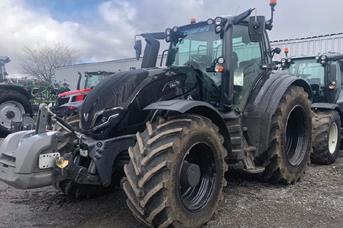











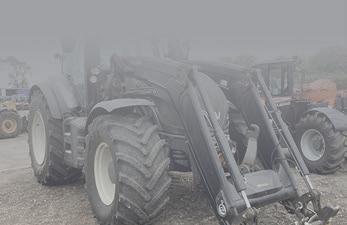









Maschio Gaspardo has launched a new version of its high-speed Chrono precision drill.
The Chrono 500 is a mounted machine which has a key feature that sets it apart from anything else. It can be set up to run with variable row spacings and is equipped with either 8 or 12 planting units, making it suitable for sowing a range of crops with 45cm, 50cm, 70cm or 75cm row spacings. This versatility makes it possible for the operator to switch from drilling sugar beet in the morning to maize in the afternoon, the conversion taking less than two hours.

Whether customers opt for the fixed row variant or the variable spacing option, the 500-series shares all the common features with the other high-speed precision planters in the Chrono range.
When it was launched in 2020, the Gaspardo Chrono brought a new level of sophistication to precision drilling. With a completely new seed delivery system, air bag suspension for each unit and electronicallycontrolled metering for both seed and fertiliser, the Chrono range offered fast-paced precision drilling with unrivalled seed placement and depth control. While conventional precision drills might run at 7-8kph, the Chrono has the potential to at least double these work-rates, at the same time improving the accuracy of seed spacing and depth placement.
This level of precision is all down to the design of the metering unit. Using a combination of traditional vacuum singulation and then pressure delivery down the coulter tube, the moment the seed leaves the metering disc it is kept under control. The
Chrono doesn’t just leave it to gravity to ensure seed ends up in the ground, a venturi puts it under positive pressure, controlling its speed and therefore ensuring it ends up in the soil without bounce.
Aside from conventional vacuum singulation, the other factor that makes for ultra-accurate seed spacing is the angle of each metering unit. Set on an incline of 15deg, seed drops off the disc and straight down the coulter tube without touching the sides. This means it is not slowed up at any point with the result that seed spacing is consistently uniform.
The goal for the Gaspardo design team in the development of the Chrono was to achieve industry-leading work-rates while maintaining accuracy. One of the biggest challenges with this is ensuring consistent seeding depth so the engineers turned to

time-proven technology from the commercial vehicle world. Rather than employing traditional springs or hydraulic rams to generate downforce on each coulter unit, they integrated air-bag suspension into the Chrono’s parallelogram linkages, giving an impressive 300kg per unit coulter pressure.
As well as providing protection against shock-loading from stones and obstacles, the system maintains constant down-pressure, avoiding the units bouncing at speed. With the ability to adjust coulter pressure to cater for differing conditions, this ensures uniform seeding depth at high workrates.
The Chrono is fully ISOBUScompatible enabling all its functions and adjustments to be handled either through an existing tractor terminal or an additional ISOBUS controller. In combination with the electronically-driven seeding units and microgranular applicator, the GPS-compatible drill controller also provides automatic row shut-off/section
control and the potential for variable rate seeding and fertiliser applications.
Despite being a highly sophisticated machine employing the latest technology, there has been a deliberate focus on keeping maintenance to a minimum while extending the working life of the various components. Brushless long-life electric motors fully sealed from dust ingress are used for the seed and microgranular metering units. In addition, there are individual filters for the airintakes on each seeding unit as well as a larger one for the main lobe compressor to ensure zero contamination of the workings.
“The Chrono was specifically developed for fast-paced precision drilling with unrivalled seed placement no matter what shape, size or seed type,” explains Dominic Burt, Maschio UK Field Sales Manager.
“Adding a version to the range that can swap between 50cm and 75cm row spacings in under two hours puts the Chrono
further ahead of the competition and provides the customer with a much more versatile machine capable of drilling multiple crop types.”
With this year’s Maize and Sugar Beet planting well out of the way, Maschio Gaspardo dealers are offering early order discounts for certain Chrono models.
Prices start from £76,535 for a standard fixed width 8-row Chrono 508, while variable row spacing and four additional planter units will add in the region of £8,950 to the base price.
Standard specification includes air-bag suspension, GPScompatible ISOBUS connectivity, 60-litre low-level easy-fill seed hoppers and front disc-openers to ensure consistent coulter penetration in UK conditions. An 1100 litre fertiliser front-tank and electronically controlled microgranular applicators with 16-litre hoppers are an option as are trash-cleaning wheels for minimum tillage and directdrilling situations.


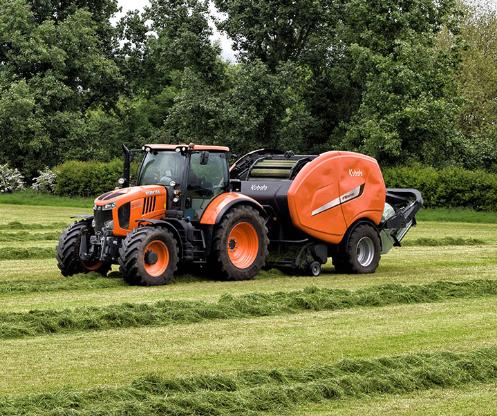
ubota’s baler range has been extended with the arrival of the FB1000 –a non-stop round baler wrapper combination that integrates a pre-chamber, main chamber and wrapper. Designed and developed at sister company Kverneland Group’s baler competence centre in Ravenna, Italy, the FB1000 uses two bale chambers arranged in series, to allow a number of rollers to be shared.
Operating as a prechamber, the front half of the FB1000 produces twothirds of the bale. As the pre-chamber reaches its preset density, crop flow is diverted into the main bale chamber allowing baling to continue non-stop. The prechamber is then opened, moving the pre-formed bale into the main chamber, where it can be taken up to its maximum size of 1.25m.
Once bale formation is complete, crop flow is switched back to the prechamber without stopping, allowing round baling to continue as a non-stop process. Net is then applied to the completed bale in the main chamber. After which, the tailgate is opened and the finished bale is transferred onto the wrapper. This entire sequence enables baling to continue uninterrupted.


To make bale transfer simple, reliable and fussfree, the FB1000 uses a wrapper frame mounted on a parallel linkage. This enables the wrapper to be lowered from its working
position to collect the completed bale as it rolls from the main chamber. This avoids the need for a complex mechanical transfer system.
With the bale collected, the wrapper is raised to allow twin satellite arms to rotate around the bale.
Unlike traditional wrapping mechanisms, the FB1000’s twin satellite arms rotate in a vertical plane. With the required number of film layers applied and the satellite arms in their parked position, the wrapper frame is lowered to allow the rear wrapper roller to be raised, gently releasing the wrapped bale onto the ground.

An ISOBUS compatible machine, the FB1000 is operated through an IsoMatch Tellus PRO terminal, offering fully automatic control of the baling and wrapping processes, along with manual over-ride functions to suit changes in field topography.
Up front, the FB1000 is equipped with a 2m grass pickup with dual cam tracks, feeding crop through an 800mm diameter intake rotor. Overall baler length is kept short for transport by folding the wrapping table vertically behind the main bale chamber.
Operators can choose from a combination of 6, 12, 13 or 25 knives through the Super Cut crop chopping system. Knives benefit from spring-loaded protection, and the FB1000 includes a drop floor mechanism. The Kubota FB1000 is priced at £140,247.


Afleet of four Honda Pioneer side-by-side UTVs and a Honda Foreman ATV helps a team of five gamekeepers manage and look after a wild bird game shoot across almost 2,000ha of the South Downs.


The shoot, on the South Downs near Arundel, Sussex and just a few miles from the sea, is part of the Norfolk Estate, owned by the Duke of Norfolk. The undulating landscape includes many steep slopes and although most of the estate land is farmed, there are large areas of grass, woodland and land within environmental schemes.
The shoot is known as the Peppering Partridge Project, and the team of five gamekeepers is led by Head Keeper, Charlie Mellor who has managed the shoot for the past 14 years. “We manage the land for wildlife and game,” he explained. “Wild grey partridges are the main game birds along with wild pheasants. It’s a large area to look after with challenging steep terrain. Tractors and conventional 4x4 pick-ups are too large and heavy and would damage the wildlife habitats and especially the conservation areas when it’s wet. That is why we rely on our fleet of Hondas to get around the shoot, and transport feed and water for the wildlife.”
The current fleet includes four Honda Pioneer 520 sideby-side UTVs and a Foreman TRX520FA6 ATV. The first three Pioneers were purchased in February 2022, and the fourth came later as it replaced a stolen machine. “I used Honda ATVs on estates where I worked previously and learned that nothing comes close in terms of reliability and practicality,” continued Charlie. “We used Foreman TRX500 ATVs initially, then TRX520s when Honda introduced the newer model. We made a partial move towards side-by-side UTVs with the purchase of a competitor-brand diesel machine several years ago which operated alongside our Honda ATVs, but it was too big and heavy, and lacked power



on the slopes, so we regretted buying it and changed back to another Honda instead.”
An increase in the gamekeeping team from three to five people a few years ago meant additional vehicles were needed, and side-by-side UTVs were again considered. “Some of our ATVs were due for updating at the same time, and we borrowed a demonstration Honda Pioneer 700 UTV from our local main dealer, Rafferty Newman Machinery Ltd,” said Charlie. “The fact that it was a Honda appealed and with its petrol engine it was quieter and had better performance than the diesel machine we owned briefly before. We liked it, but that model was discontinued shortly after, so we ordered three of the smaller Pioneer 520 model instead. The Pioneer 520 shares a similar 518cc petrol engine and five-speed mechanical transmission with the Foreman TRX520 ATVs that we got on with so well. Being lighter and more compact than the previous diesel UTV is a big advantage, and even at only 1,270mm wide, it will transport the operator and a passenger plus loads in the rear cargo bed safely. The tipping load bed is slightly smaller than the Pioneer 700 we tried, but that isn’t an issue as we move water, feed and bulky equipment in trailers. One Honda TRX520FA6 conventional ATV was retained, as most of our implements including spreaders and sprayers are designed for ATV load racks rather than UTVs.”
Each keeper looks after a different area and for six months of the year the main task is patrolling the shoots to check on the welfare of the game birds and control vermin, which takes up to four hours each day. Up to nine hours can be spent riding the machines during the busiest periods, and the keepers find them easy to use and comfortable. “We couldn’t get where we need to and cover the large area effectively without the
Hondas,” continued Charlie. “When the chalk uplands are wet they become very slippery, but the Pioneers travel everywhere without damaging sensitive conservation headlands and cover crops. Being only slightly wider than conventional ATVs, they can squeeze through narrow gaps and minimise damage to vegetation. Our machines have just a cab roof but no front windscreen as that is what our keepers prefer. It gives some protection from rain but most benefit is on sunny days providing shade.
Essential equipment such as clothing for weather protection is carried in purpose-made storage boxes in the rear cargo bed and loads such as bulk feed are transported behind in trailers. These have low pressure, flotation tyres like the ATVs, which help prevent damage to vulnerable ground. Bowsers, also on flotation wheels, deliver water and the Pioneers were busy towing these around the estate this spring as the long drought conditions continued.
Jack Barton is the Foreman TRX520 main user, and he commented that for some of his work the conventional ATV offers advantages. “I get on well with the Pioneers but find it more convenient being able to get on and off either side of the Foreman ATV to open gates or fill feeders. Also, there is no roll bar to obstruct the view which makes it even better for vermin control. The Foreman travels everywhere I need it to and has slightly more ground clearance, but the Pioneers seem just as versatile.”
challenging terrain. Refuelling is quick and easy through large tank filler caps, and daily checks are carried out within just a few minutes so downtime is minimal.


Asked if there are additional features or improvements that the keepers would welcome on future Pioneer models, they all agree that adding a waterproof storage compartment in the cab area for items such as binoculars would be useful. They also suggest that a discrete green body panel option like their Foreman TRX520 ATV would be more suitable for the gamekeeping role than the current brown finish. Mudguards at the rear to reduce dirt thrown from the wheels into trailers would also be an advantage. “There are a few small changes we would welcome, but they really are fantastic machines and I don’t think we could find the same combination of reliability, practicality and value for money from any other brand,” observed Charlie.


The shoot ATVs are usually updated after three years. Charlie pointed out that at this age the Hondas remain completely reliable even after working so many hours. “They hold their value well which keeps our ownership costs low, and we have always been happy with the deals offered by Mick and Joe Challen in the Rafferty Newman sales team. They are fair and easy to deal with.
Since the current fleet of four Pioneer 520s arrived, three have worked approximately 1,200 hours each, and the newer machine has worked 600 hours. There have been no breakdowns and no repairs have been needed apart from replacing a set of rubber gaiters on a front wheel drive shaft. Routine servicing is carried out by Rafferty Newman, and Charlie said that back-up provided by the dealer team is excellent.
Calculating average fuel consumption is difficult as the use is so variable, but Charlie commented that the Hondas use little petrol for the hours they work, especially considering their role and performance on the
“The service department is another reason that we don’t tend to consider other brands or suppliers. Tom Mercer in the workshop is our first point of call when we need advice or the machines require maintenance. Even when we call in the evening we usually get a reply. They don’t just shut at 5pm every day.”
The Foreman TRX520 ATV will be due for updating shortly and Charlie said that it will almost certainly be replaced by another Pioneer 520. “The estate also operates two diesel UTVs of another brand that are used in the parkland. They are larger, with more load carrying capacity but don’t work in the same demanding environment as our shoot machines, so the less powerful diesel engine with a belt-drive transmission arrangement is adequate. “However, if Honda ever adds larger Pioneer models to the range in future, then it’s likely we would consider changing the other two machines as well - making it an all-Honda fleet.”
Suzuki GB has recently announced a fantastic new trade-in offer on its range of KingQuad ATVs which will enable customers to get 10% off the RRP of a new Suzuki by trading in any brand of quad bike in part exchange.


Suzuki’s range currently comprises of three versatile models; the KingQuad 500 and 500XP as well as the KingQuad 750XP (XP denotes power steering). These robust utility ATVs are the culmination of years of refinement and their high levels of technical specification and ease of handling give riders confidence on any terrain, making them suitable for several applications including hill and lowland farming, estate management and use on equestrian properties.
Suzuki’s position as one of the leading suppliers of ATVs to the UK agricultural and land-management markets has been further strengthened by a new security package that includes the CESAR forensic marking system from Datatag and a Thatcham accredited tracking and immobiliser system from Datatool.

The Suzuki trademark is recognised by people throughout the world as a brand whose products offer quality, innovation, reliability and originality. Suzuki stands
behind this global symbol with a determination to maintain this confidence in the future, never ceasing in its efforts to develop ‘value-packed products’ with a focus on the customer.
And this certainly rings true for Suzuki’s ATV division. Back in 1983 the QuadRunner 125 was the ATV that started an industry! It was the first ever production 4-wheel ATV and became a top-seller. This ATV boasted a friendly design that was easy to use and an outstanding cost-performance ratio. It was to be the catalyst that started a future of 4wheel ATV technology.


Today, Suzuki continues to bring classleading technology to the market as well as customer-focussed value propositions such as this trade-in offer.
Mark Beeley, Head of Marine & ATV for Suzuki GB said, “We are proud to be able to work in partnership with our national network of expert Dealers to offer customers this trade-in option. We currently have good stock availability on all models ready to satisfy the anticipated uplift in demand during this key buying period for farmers and land owners.”
The new trade-in offer is available at participating Dealers only until the end of September. To find your local Dealer, you can use the Dealer locator here.


Whether it is working on the farm or transporting materials across construction sites, having the right equipment is essential. The Kawasaki Mule Pro MX delivers the rugged, reliable and adaptable attributes that will help you take on any terrain.

Designed to work hard, the robust Mule Pro MX. Powered by a torqueladen 700cc CVT singlecylinder engine, the Pro MX offers 32.8 kW {45 PS} / 6,000 rpm, guaranteeing a fun-to-drive vehicle that can easily hail cargo for work or weekend fun. The spacious cargo bed is able to carry up to 317 kgs 700 lbs, making chores or hauling gear a breeze.
Measuring 2795mm long and
For more information
1525mm wide, with a wheelbase of 2005mmthe Mule Pro MX is the perfect mid-sized vehicle, offering superb manoeuvrability and mobility that ensures it can negotiate the tightest of trails. To maximise comfort, the all-
effect on the chassis.


Of course, these workhorses are designed to be used throughout the year in all conditions. That is why the Pro MX is equipped with 25” tyres on 12” rims, guaranteeing fantastic off-road traction and ground clearance. Strong and reliable front and rear disc brakes provide effective braking, especially when combined with the Mule pro MX’s proven engine braking.
terrain vehicle features double-wishbone suspension at the front and rear, enabling the Kawasaki to easily traverse obstacles and elevations with minimum
While its performance is unmatched, Kawasaki has also focused on making the Mule pro MX model as accessible and user-friendly as possible. Coming equipped with doors as standard, users will be protected from mud and puddles, while a 5.3 litre
storage bin underneath the passenger seat ensures that there is plenty of space to securely store all of your belongings.
Bright digital instrumentation ensures you can always see essential information at a glance and the console also comes prepped for an accessory audio system. The multi-function display is built directly into the dash and features an array of insight, including:
• Driving mode (2WD/ 4WD) indicator
• Digital speedometer
• Digital fuel gauge
• Clock odometer
• Dual trip meters
• Hour meter
• Differential indicator lamp
• Check engine lamp
• Electric Power Steering warning lamp
• Water temperature warning lamp
• Seatbelt warning lamp
• Parking indicator lamp
• Reverse indicator lamp
• Neutral indicator lamp
The contoured bench seat complements the body and provides ample space and comfort for two adults at a time. Kawasaki’s high-grade Electric Power Steering (EPS) is speed-sensitive, providing users with light steering at low speeds and tightened steering at higher
speeds. It can also work to enhance rider comfort by acting as a damping system, reducing the bumps and kickbacks created as you go along bumpy terrain. Drivers are also able to set the position of the steering wheel to not only suit their preference but also to lift it out of the way when getting in and out of the vehicle. An electrically selectable 2WD/ 4WD and dual mode rear differential system ensures quick and simple changing to suit the changing terrain.
Since its launch, the Kawasaki Mule Pro MX has established itself as one of the leaders in utility vehicles, used by farm workers, gamekeepers, construction workers and event workers across the globe. More information on the MULE pro MX can be found at www. kawasaki.co.uk



Delivering all the rugged, reliable and adaptable attributes that Kawasaki’s MULE utility vehicle brand is justi ably famous for, the Kawasaki MULE PRO-MX range relies not only on a torque laden 700cc CVT single-cylinder equipped engine but also bene ts from the Shinari design philosophy.
FOR MORE INFORMATION AND TO FIND YOUR LOCAL KAWASAKI DEALER, VISIT WWW.KAWASAKI.CO.UK

Agriculture faces a potential drought in young people looking to continue family farms or pursue a career in farming. To inspire his children and embrace new ways of working, Quintin Dunlop has invested in machinery that enables his children to share some of his passion and work with him.

“We purchased two Yamaha Viking Side-by-Side vehicles. With three seats it means both my son and daughter can join me when I go out to feed or tend to the flock. I have a Yamaha Kodiak 700 ATV too, which is fine for working alone, but the Viking helps me to show my children what is needed to manage our land and livestock,” he says.

The Viking is a capable workhorse which has offered him an even greater carrying capacity than his Yamaha Kodiak ATV. It also enables him to work more closely with his brother and parents who share the farm partnership.
“My father started farming without an ATV, let alone a vehicle like the Viking. My first ATV was a trike and I have since had a string of Yamahas because I find them comfortable and reliable. The Viking enables me and my brother to ride and work together. It has a cargo bed that is much safer for transporting sheep and it is capable of
going anywhere on the farm,” he says.
Emscleugh Farm is near Dunbar with mixed and hilly land. Mr Dunlop and his family farm 2300 acres with 2100 ewes and 100 pure bred Texel ewes. They also rear 250 suckler Limosin Cross beef cattle.
“I went into farming young and I enjoy the life it has given me and my family. We breed tups as well as rearing lambs for sale. Breeding is fascinating and there is a fine line between a lamb that is worth £85 and one


that could be worth as much as £85,000,” he says.
He spends the majority of his time managing livestock, covering upwards of 1000 kilometres per month on his Yamaha Kodiak 700. The ATV acts as an extension of his body. Something he was made very aware of when he injured his back.
“I had an operation 20 years ago and found the ATV I had at the time painful to ride. I trialled a Yamaha from my local dealer Frank Gibson ATV and I didn’t experience the same pain, plus with an automatic transmission it made life so much easier. Today, Euan Gibson and his team looks after us very well, supplying replacements ATVs when ours need servicing and making sure new models are available when we need them,” he says.
His Kodiak has both power steering and diff lock to manage the tricky terrain on the farm. With the Yamaha’s powerful 700cc engine it is more than capable of pulling 600 kilos, even when fully laden. Mr Dunlop has also invested in three Logic snackers and trailers which can be towed by either the Kodiak or the Viking.


“We use both vehicles to pull trailers and snakers. Calving outside can be tricky if the conditions are wet and the soil becomes waterlogged. The only way to get to the herd is with one
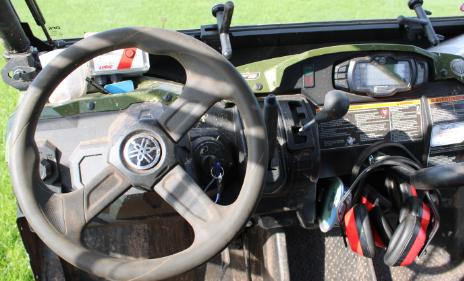
of the Yamahas and a trailer. If we used a tractor it would ruin the soil, and may get stuck,” he explains.
He had also equipped the Viking with a set of tracks to enable it to run in the often deep snow the farm experiences. The snow makes parts of the farm inaccessible to most vehicles but, with its tracks, the Viking can ride through snow and ice in a way that also minimises soil compaction.




“Tractors can get stuck in the snow and sometimes cause irreparable damage to the land. With its tracks, the Viking can handle anything. The kids love it because it looks like a Bond vehicle, but it really is a very practical option for us when the weather turns,” he says.
He suggests that having the machinery is helping to inspire his children. This has led to him and his brother buying two YFM90Rs, Yamaha’s junior ATV for children aged 10 plus. They believe that offering the children the opportunity to learn and respect the machines whilst also enjoying the freedom to travel around the farm will inspire them to stay and continue to work on the farm for years to come.
“My daughter Addison has really taken to riding the ATV, she loves it. I think introducing her to it at a young age and taking her and her brother with me in the Viking has helped them to experience what it is like for me,” he concludes.

he innovative range of HiSun lithium-ionpowered electric utility vehicles is designed to work just as hard, if not harder, than traditional fuel-powered machines. There are four models, 5 kW, 7.5 kW, 15 kW and a 4-seater 15 kW.
The move to electric UTVs offers many benefits over petrolpowered machines. There is no compromise on power, with these latest lithium-ion UTVs providing all the power needed for use in tough, off-road conditions. They are free from harmful carbon emissions, which supports the shift to a virtually zero-carbon economy in the drive to tackle climate change and reduce global warming.
These multi-functional, hardworking machines are ideal for applications in farming and agriculture. Due to their compact size, they are versatile and convenient for many farm chores that larger vehicles are not suited for; transporting feed to livestock in remote areas, hauling equipment, towing, ploughing and harrowing.
The top-of-the-range Sector 15




kW has all the power and torque to tackle the most challenging terrains. With the ability to climb steep slopes, the Sector 15 easily handles 30-degree plus inclines in forward and reverse. When the going gets tough, you can switch to selectable fourwheel drive with rear/front diff locks to tackle difficult terrain.
The 4-seater version of the 15 kW UTV can transport up to four passengers, carry machinery and equipment and easily tow heavy loads. The lithium-ion technology batteries that power both models are designed for longer run times, and a single charge will keep the UTV working for a full day.


Like its bigger brother, the Sector 7.5 kW is a reliable, everyday machine capable of tackling many tasks, whatever the weather. The open cargo bed will carry up to 280 kg/ 67 lbs, ideal for transporting everything from logs, hay, tools and equipment.

The smallest of the lithium-ion powered models, the 5 kW UTV still has the power and torque to climb slopes over 30 degrees. The longer run times of the lithium-ion batteries will keep this reliable worker going for up to 44* miles on a single charge.
There is also a 49-volt dry cell battery model, the Vector E1.
Producing 27 hp, the Vector E1 is powerful enough to go over the toughest terrain without all the noise of petrol-powered engines. Selectable 4-wheel drive, nitrogen-assisted independent suspension and four-wheel hydraulic brakes add to the Vector’s all-terrain credentials.
All models have the option of the DFK fully enclosed cab kit that includes a glass windscreen with wash/wipe, rear screen, metal roof, and lockable doors so that the UTVs can be customised

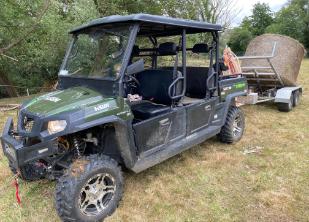
depending on customer requirements.
Choosing electric power offers huge savings in fuel costs, with an overnight charge costing around £1*. There is also the bonus of no road tax, as electric UTVs can be used both on and off-road. Electric UTVs are usually cheaper to service and maintain with no engine and fewer parts to service.

The quiet electric motor is a key attribute making these machines ideal for driving near animals or
in areas where noise must be kept to a minimum. An electric UTV has no gearbox, so acceleration is smoother, making for a more comfortable ride.



HiSun vehicles are supported and distributed in the UK by Barrus Ltd. For more information visit www.barrus.co.uk, call 01869 363665, or email vehicle@barrus.co.uk
*Figures quoted are intended as a guide only. Cost/mileage would be dependent on usage and conditions.


Balancing loads on front and rear racks, sitting astride a saddle, having no room for a passenger and being fully exposed to the elements – while the ordinary ATV also has its benefits, there are plenty of downsides to the ‘quad bike’ design. So the side-by-side utility vehicle (UTV) alternative, with its full load bed, conventional seating for more than just the driver, and either cab frame or full cab, offers many advantages. But with a number of machines on the market from which to choose, selecting the right UTV for farm use can be a difficult task. Separating out the models with design features clearly built to withstand the rigours of agriculture is a worthwhile exercise.
A diesel engine that offers both power and economy is a given on most lists of ‘wants’, saving trips to the fuel station for petrol and providing the torque needed to climb hills and clamber over tough going. With Kioti’s K9, the successor to the popular Mechron, a three-cylinder powerplant, built by the same manufacturer as the machine itself, provides efficiency and energy in equal measure, along with the reliability for which South Korean engineering has become synonymous. Minimal fuel stops are another prerequisite for any agricultural vehicle, and with 37 litres of diesel capacity, the K9 is capable of long days without refuelling.

Surefooted traction and a decent turn of speed with a comfortable ride are also on the agricultural ‘wants’ list, and the K9 meets the bill here with a twin-range CVT transmission that provides smooth take-off and slow-down. There is also quickly-selectable 2/4wd and a locking rear diff, plus a helical spring/stabiliser arm suspension arrangement that cushions the driver/passengers and the load in rough going. And for smoother terrain, the K9’s top speed is a rapid 40km/hr (25mph).
A UTV engine also needs to provide the guts to shift a full payload with ease,

and the K9 doesn’t disappoint here. The 1.0-litre powerplant produces 24hp, more than enough to shift the machine’s 0.5-tonne load capacity with ease, meaning it is competent and capable of handling typical agricultural loads of fencing stakes, spare parts, slug pellet bags and more. A urethane coating ensures long-term bed protection, while options include hydraulic tipping – mechanical tipping is standard. For additional items there’s an optional storage box under the hood.
Of course, one of the most important features of a UTV is its ability to carry more than one person legally, safely and in comfort. The Kioti K9 features two full seats with an optional smaller mid-seat, all with safety belts. A full rollover frame with roof is standard, while options include a windscreen, halfdoors and, for maximum weather protection, a full cab package with heating. Full road lighting and mirrors are standard, as is front bull-bar protection to guard against the knocks and scrapes that are unavoidable in agriculture.

A vehicle aimed at satisfying the demands of agricultural buyers needs to be universal in what it can carry, and to this end the K9 is available with a
• 3 cylinder 24 hp economical diesel engine
• Room for 3 persons to sit comfortably
• Various options cabin sun canopy etc
• High ground clearance 31cm
• Urethane coated load space for long lasting protection
• Homologated for road use

wide range of rear fitments, such as a galvanised livestock canopy ideal for transporting lambs. There are also hitch hooks at both the rear and the front of the machine, making it possible to not only pull a variety of trailed implements, but also manoeuvre equipment around the yard. Meanwhile, on the options list is an external hydraulic outlet, for even greater versatility –powering a tipping trailer, for example. The K9 has a maximum towing load of 590kg, helping to more than double its carrying capacity.
Stability and manoeuvrability are also essential factors for an agriculturallytargeted UTV. With a width of 1,590mm, the K9 can squeeze through tight door-, passage- and gateways, while ground clearance of 304mm ensures it rides over rough terrain with ease.


For all their uses off-road, UTVs are often also called upon to travel on the
Think
road between tasks in different fields, and for this, of course, road homologation is a must. With the Kioti K9, that’s not an issue, as the machine is fully homologated for road use. And like every machine on the farm, reliability is critical to ensure uninterrupted work. Kioti UK, which recently moved to brand new premises
in a central and accessible location close to Huntingdon, and has a dealer network of more than 80 outlets, now provides a full two years’ warranty for the K9, with unlimited hours. Along with a specification that more than matches agricultural needs, that’s another factor in favour of the K9 on many farmers’ UTV ‘wants’ lists.
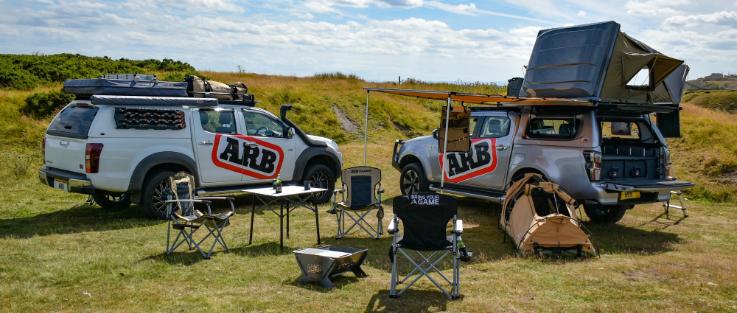
Isuzu UK has recently approved an extensive range of 4x4 off-road and camping accessories for the NewLook Isuzu D-Max from ARB UK, the 4x4 division of pick-up accessories leader Truckman.
This new partnership provides Isuzu D-Max owners with a vast array of high-quality accessories designed and engineered to enhance their vehicle's capabilities and adapt it to suit their needs, whether it be for professional or recreational endeavours. Isuzu UK and ARB's collaboration showcases an impressive assortment of enhancements, including innovative drawer systems equipped with convenient slide-out kitchens, premium rooftop tents, versatile awnings, and top-ofthe-line camping gear. Additionally, the collection boasts durable roof racks, reliable recovery gear, and practical canopies, further solidifying Isuzu D-Max as the ultimate choice for versatile customization.
Participating Isuzu dealerships will be offering these accessories, giving customers the option to purchase a vehicle pre-loaded with accessories to suit their needs.
The Isuzu D-Max is already designed with ruggedness and durability in mind, but the addition of ARB accessories will make it even more versatile. The accessories approved by Isuzu have been rigorously tested in real life
conditions to ensure they meet the high standards for quality, safety, and performance set by both Isuzu and ARB.
ARB 4x4 is a renowned provider of premium off-road accessories and equipment, specializing in delivering exceptional quality and innovative solutions for 4x4 enthusiasts worldwide. With its origins rooted in the Australian outback, ARB offers a comprehensive range of products, including bull bars, winches, suspension systems, roof racks, recovery gear, and camping equipment. Trusted by adventurers and off-road enthusiasts, ARB is synonymous with durability, reliability, and performance, ensuring that your vehicle is equipped to conquer any terrain and endure the rigors of off-road exploration.
Matthew McConaghy, Commercial Director of ARB UK, said: "This exciting partnership between Isuzu and ARB will allow Isuzu D-Max owners to fully customise their vehicle to suit their needs – whether off-roading or outdoor adventurers."
Steve Page, Accessory Sales & Marketing Coordinator for Isuzu UK said: "We are excited to partner with ARB UK and provide our customers with a comprehensive range of accessories that will enable them to customise their Isuzu D-Max according to their specific requirements. This partnership allows us to
offer a vehicle that can suit any need, whether it's for work, adventure or lifestyle.
“Isuzu is committed to providing its customers with the best possible products and services, and this partnership with ARB is just one example of that commitment. With a range of

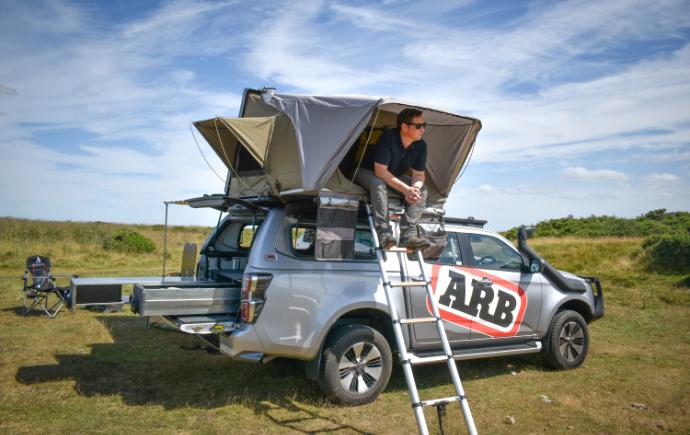
approved accessories now available, Isuzu DMax owners can look forward to even greater versatility and functionality from their vehicles.”
For more information about the range of ARB accessories approved for use with the Isuzu DMax, please visit your local Isuzu dealer.
The new Volkswagen Amarok pick-up has gone on sale with the 5+ Promise standard warranty and service plan, providing the ultimate peace of mind to all new buyers.
The enhanced plan includes five services (comprising three Oil Change services, two Oil Change and Inspection services plus three MOTs), a five-year warranty (extended from the standard three years and up to 200,000 km or 124,000 miles) cover across the UK and Europe, and five years’ roadside assistance (extended from the standard three)**.
The new Amarok is available to order from £33,000 + VAT which includes the 5+ Promise within the price*. In total, this package, would cost customers up to £2,300 if they were all purchased separately.

The premium pick-up is available in a choice of
four trims: Life, Style, PanAmericana and Aventura. A longer wheelbase and shorter overhangs improve the Amarok’s off-road ability, and mean much more space in the cab.
Visually, the new Amarok’s front end is characterised by bold horizontal upper radiator grille crossbars, while the rear end is distinguished by new C-shaped rear lights.
Customers can see the new Amarok in Volkswagen Commercial Vehicles’ network of over 60 UK Van Centres now; or virtually explore the model from the comfort of their own home. Follow this link to find out more, or scan the QR code below to see a lifesize 3D model of the pick-up in all trims and colours.
For more information on the new Volkswagen Amarok, visit: https://www.volkswagen-vans.co.uk/ en/new-vehicles/new-amarok.html

Four stylish new Volkswagen Tiguan Black Edition models – including one plug-in eHybrid – go on sale in the UK this July.
The Tiguan is already Volkswagen’s best-selling model worldwide and widely regarded as a highly capable family SUV, and these eye-catching Black Edition trims are set to add to the model’s popularity.
Sitting between the R-Line Edition and R trims, each Tiguan Black Edition comes with a sporty styling pack that comprises R-Line body-coloured bumpers, rear privacy glass, black decorative trims and exterior mirror housings. Also included are striking 20-inch Suzuka Black alloy wheels, a panoramic sunroof and metallic paint in three colours – Deep Black Pearl, Dolphin Grey and Reflex Silver – as well as the premium colour Oryx White Mother-of-Pearl for an additional £475.
Other features that come as standard include a seven-speed direct-shift gearbox (DSG), a Discover Media navigation system with streaming and internet, and a leather-wrapped, heated, multifunction sports steering wheel with touch control and shift paddles.
Three 4MOTION all-wheel-drive models are available from Tuesday 4 July, priced from £42,340 RRP on-the-road including VAT:

The new eHybrid model went on sale on Thursday 13 July:
These models are in addition to the two Tiguan Black Editions launched earlier this year to coincide with Volkswagen’s money-saving March SUV event: a 1.5 TSI 150 PS and 2.0 TDI 150 PS, both with a seven-speed DSG and priced £38,755 and £40,945 (RRP, OTR) respectively.
All Tiguan Black Editions are available until the end of September on a 7.9-per-cent personal contract plan (PCP) from Volkswagen Financial Services and with a £1,500 deposit contribution.



Suzuki is celebrating some very good news from the results of the 2023 What Car? Reliability Survey in which over 25,000 readers reported on their car ownership experience between six and up to 20 years old.
Of the 30 car brands measured, Suzuki ranked first place in the league table with a score of 94.7 per cent. Owners were asked if their car had suffered any faults over the last two years, how long the repairs took as well as how much it cost.
The good news continued with two Suzuki models ranking well inside the top 10 most reliable models. Vitara (2015- present) ranked the second most reliable car in the small SUV category with a score of 99.3 per cent with only six per cent of owners

reporting any faults with their car. Most importantly, all cars could still be driven, and were repaired on the same day.
The Swift model (2010-2017) followed very close behind at 98.1 per cent. Consumer Editor of What Car? Claire Evans comments: “The Swift might not be the most popular small car, but it’s got a lot going for it, including great driving manners, a reasonable amount of space and a high rating for safety. Like other Suzuki models, it’s also bullet proof, even as it ages.


Only six per cent of the Swifts in our survey developed a fault, and the battery was the only component affected. All cars could still be driven, half were fixed in less than a day, and no repair bills exceeded £100”.
Since April 3rd, Suzuki introduced its Service Activated Warranty which is offered once the car or motorcycle reaches the end of its manufacturer warranty period and is booked in for its next scheduled service within the Suzuki Dealer network. This warranty stays in place until the next qualifying service and is then simply renewed again up to a maximum vehicle age of 7 years / 100,000 miles for cars or 70,000 miles for motorcycleswhichever comes first.
As a celebration of the 20th anniversary of our original Range Rover project, KAHN® unveils the ‘Fintail’ under the new Racing Green programme.

2023 marks two decades since the inception of the original KAHN® Range Rover project, the first chapter in a 20-year odyssey of influential vehicle
Rover would, however, only last so long, explains Afzal Kahn: “As KAHN® evolved, coach-built projects such as Vengeance and The Flying Huntsman became a focus at HQ, leading us to take a five-year hiatus from Range Rover projects. With the arrival of the latest Range Rover comes an exciting opportunity to return to the roots of KAHN®, while focusing firmly on the future of automotive fashion.”
by a full exterior styling package.
The styling package is comprised, at the front of the vehicle, of a single sweep front bumper valance which merges seamlessly into vented front bumper extensions, representing a subtle homage to the very first KAHN® Range Rover project.

refinement for which the design house has become worldrenowned. The original KAHN® Range Rover project sent ripples across the automotive industry, inspiring countless bespoke offerings from manufacturers and, soon after its release, demand for such conversions grew to warrant a direct vehicle supply from Jaguar Land Rover, who themselves went on to develop their own special vehicles division known as SVO. This brand synergy with Range
With the Fintail, Racing Green set out to embody the best of British engineering on land and in the air, drawing on diverse influences from over half a century of British motorsports heritage that evolved in the wake of seismic aerospace development during the 1940s.
The Racing Green Fintail cuts an imposing figure. Its threespoke wheels, akin to a modern take on those found on Princess Diana’s 1995 Range Rover, sit below a sleek body accentuated

Along the flanks are side skirts, bolstering the width of the vehicle with a fusion of influences from both ground effect racing machines of yesteryear and the stabilising fins found on modern fighter jets.
To the rear of the vehicle, a winged diffuser with additional stabilising fins reemphasises the underlying design influences of the Racing Green Fintail.




Expect more news soon on our plans for the latest incarnation of the Range Rover, including further developments with the Racing Green brand.
Website:https://www. racinggreenautomotive.com/

Smart electric vehicle company NIO has today launched its EL6 in Europe. The smart electric all-round SUV promises users in Germany, the Netherlands, Sweden, Denmark and Norway an experience beyond their expectations.
The EL6 adopts NIO's pure, sophisticated, and progressive design language while showcasing its "Design for AD" philosophy, which sees the brand’s watchtower sensor layout seamlessly blending with the vehicle's roof, setting a new paradigm for the design of smart EVs. It measures 4,854 mm in length, 1,995 mm in width, 1,703 mm in height, and has a wheelbase of 2,915 mm.


A cocooning doublelayer dashboard design takes inspiration from nature, benefitting from sustainable rattan and invisible air vents. For the first time, the EL6 features tailor-made acoustic fabric on the speakers, enhancing the audio experience while providing a premium look and

feel. Thanks to the EL6 offering the largest openable sunroof in its class, almost one square meter of natural sunlight can enter the cabin to further boost the atmosphere.
With the user experience of the utmost importance, NIO has put great focus on comfort and convenience. NIO’s premium, proprietary seat platform – capable of 20-way adjustment for the driver’s seat – has been developed in-house by NIO’s engineers. The seats feature a multi-layer comfort system with nine layers of supporting materials.

An upgraded passenger Lounge Seat boasts exceptional features such as 22-way adjustment, including a comfortable zerogravity position that can be engaged with a single tap.
Reclining mode, capable of rotating through 160degrees, delivers extra comfort thanks to the adjusting leg rest, offering a nearhorizontal resting position. It also features ventilation,
an eight-point massage system, and three-zone heating available separately for the seat cushion, back and leg rests. The rear row of seating also comes with power adjustable seats.
Alongside a comfortable ride, the EL6 boasts flexible storage space with a three-layer trunk offering a maximum volume of 668 liters. The rear seats can be folded down in a 40/20/40 layout, generating further storage space up to 1,430 liters.
Encompassing NIO’s high-performance DNA, the EL6 features a standard dual-motor four-wheel drive system comprising of a 150 kW front induction motor and a 210 kW rear permanent magnet motor, with a total power output of 360 kW and a peak torque of 700 Nm. It is capable of accelerating from 0 to 100 km/h in just 4.5 seconds, while high-performance four-piston fixed calipers deliver a braking distance of just 34.5 meters from 100 km/h.


Users can choose from nine driving modes. NIO's proprietary Intelligent Chassis Controller (ICC) works with the car’s Continuous Damping Control (CDC) system to make up to 500 damping adjustments per second. It only
takes 0.01 seconds to complete a damping force adjustment of over 6,000 N, providing comfortable flexible control over the vehicle's dynamics. NIO is debuting its Intelligent Smooth Stop (ISS) on the ES6, which can automatically adjust its braking force.
The EL6 comes with NIO AQUILA Super Sensing, consisting of 33 high-performance sensing units, and NIO ADAM Super Computing with four NVIDIA Drive Orin X chips, achieving a computing power of 1,016 TOPS.
The EL6 features a Heads-up Display (HUD) and intelligent Adaptive Driving Beam (ADB) headlights as standard. Supported by the AQUILA Super Sensing system, the LiDAR works with the frontview cameras to automatically detect road conditions, controlling the lighting system to ensure accurate beam distribution while avoiding interference with other road users to enhance safety.
The EL6 is available in ten body colors and four interior themes, including two shades that are exclusive to the car –Galaxy Shadow for the exterior and Warm Gravel for the interior.

Kia UK is set to roll out new nationwide ‘EV9 Electric Experience’ events to give customers the chance to get hands-on for the first time with Kia’s latest electric model, the EV9.
The events demonstrate Kia’s leadership in electrification and provide customers with the opportunity to learn more about the hotly anticipated EV9 seven-seat electric SUV and see it in the metal. Customers will also have the chance to explore the performance focused EV6 GT and the ground-breaking Niro EV.

Customers can see which dates their local dealerships will host the ‘EV9 Electric Experience’ using the dedicated website and searching by post code. If the closest event has reached maximum capacity, other dealers in the area will be available to choose.
Every event will include an unveil show followed by an in-depth presentation about the EV9 and the opportunity to look around the vehicle in detail. Electric vehicle experts will be available to answer questions so that customers are fully informed with first-hand knowledge about Kia’s latest electrified range. Customers also have the option of putting in an order for the EV9 and other award-winning Kia models.
The EV9 is a seven-seat electric SUV available in three grades, ‘Air’, ‘GT-Line’ and ‘GT-Line S’, a six-seat variant is also exclusively available for the range topping ‘GT-Line S’ grade. EV9 pre-orders are open now with prices starting from £64,995.
The ‘EV9 Electric Experience’ events will be held across Kia’s 190 dealerships up and down the country, starting in the south east before heading north.
The EV9 will make its public and dynamic UK debut at the Goodwood Festival of Speed on 13-16 July 2023, before embarking on its tour of the UK. Two event teams will simultaneously work their way across the UK to host EV9 Electric Experience events. Citygate Kia Slough and JCB Kia Rainham will serve as the first dealers to host the tour started on 20 July.
The ‘EV9 Electric Experience’ events run dealerby-dealer until mid-November and are available to all members of the public who book a place via the

The EV9 is powered by either a single motor rear-wheel drive setup for the ‘Air’, or a dual motor all-wheel drive powertrain on the ‘GT-Line’ and ‘GT-Line S’. Every grade of EV9 is equipped with a large 99.8kWh fourthgeneration lithium-ion battery. Range for the rearwheel drive EV9 ‘Air’ is rated as up to 336 miles (WLTP combined), while the all-wheel drive EV9 ‘GT-Line’ and EV9 ‘GT-Line S’ variants offer up to 308 miles range per charge. Based on Kia’s ground-breaking E-GMP platform, every EV9 is capable of 800V charging which can deliver 10-80 per cent charge in 24 minutes at the fastest 350kW ultra-fast charge points1.
Leaders in electrification, Kia plans to launch 15 fully electric models globally by 2027, nine in the UK, as part of its ‘Plan S’ strategy that was first announced in 2020.

Astandard all-electric IVECO eDaily 3.5 tonne van has claimed the official GUINNESS WORLD RECORDS™ title for the ‘Heaviest weight towed by an electric van’.
The IVECO eDaily is known for its class-leading 3.5 tonne towing capacity and strong truck-based chassis, with the van’s robust engineering now cementing its place in the history books with an official Guinness World Record.

Towing an incredible 153.58 tonnes, this standard production electric vehicle is now globally recognised for its extensive capabilities. In fact, this achievement surpasses records set by all-wheel drive electric cars, an impressive feat delivered by the eDaily’s 140kW rear-wheel drive drivetrain with 400Nm of torque.
On 20th June 2023 the record-breaking eDaily was hitched to the enormous IVECO X-Way Strator truck, built for IVECO customer Essex haulage company G&B Finch. This mighty machine was specially engineered to cope with moving large-scale loads of up to 150 tonnes.
The truck’s trailer was laden with a huge Collard Group earth-mover weighing in excess of 50 tonnes, with an additional seven tonnes of ballast being added for good measure. A fully-loaded IVECO X-Way 8x4 tipper truck was then attached to the Strator’s trailer before an allterrain airport fire truck completed the 153-tonne road train. A specialised towbar designed by Mike Parker Design meeting record criteria insured this vast weight was secured to the eDaily.
Once it started moving the eDaily made steady progress down the stipulated 100ft of runway and crossed the finish line in front of the GUINNESS WORLD RECORDS™ invigilators to claim its impressive accolade. The van’s ‘hi-power’ modefitted to every eDaily as standard - was utilised on the run which provides bursts of additional power in demanding towing conditions for the all-electric van.
Blackbushe Airport in Surrey was selected as the record attempt location as its additional runways, surface and gradient met the strict GUINNESS WORLD RECORDS™ criteria. All towed vehicles were weighed using precision weigh pads supplied by Micro Weighing Solutions as part of the official Guinness regulations.

Who better than Britain’s current Strongest Man, Adam Bishop, to drive the eDaily and break the world record. He said: “The van was incredible. The scale of its challenge and what it towed was unbelievable, but it rolled up its sleeves and got on with the job. Amazing!”
IVECO UK Light Business-line Director, Mike Cutts said: “The IVECO eDaily has made history with this impressive record, reinforcing the strength, durability, and extensive capabilities of the eDaily. With an initial target of 130 tonnes, the eDaily far surpassed record requirements. I would like to thank everyone who came together to make this possible – it was a real team effort.”
The IVECO eDaily made EV history and highlights the benefits of its body on frame concept and the immediate torque delivery of its electric motor. Operators undertaking demanding towing missions can rest assured that the eDaily is more than capable of its official up to 3.5 tonnes towing capacity.
Ford Performance has raced and won from Le Mans to Monaco, Daytona to Bathurst and Finke to Ensenada. But it has yet to take on one of the toughest races on the planet – the iconic Dakar Rally.
Today, Ford announced the time has come to fill that gap in its sweeping motorsports resume. Extreme racing versions of the “bad-ass” Ford Ranger and Ranger Raptor will forge the way for the FordPerformance expansion into global off-road racing, including the famed and fearsome DakarRally in 2024 and beyond.
The first step in the multi-year plan to compete in the Dakar Rally is to finish and learn in collaboration with longtime partners M-Sport and Neil Woolridge Motorsport (NWM) for vehicle development, servicing and event management.

"To lead the charge at one of the ultimate global off-road events – the Dakar Rally – has been a goal of ours,” said Mark Rushbrook, Global Director, Ford Performance Motorsports. “We cannot underestimate the enormity of the challenge ahead of us. We need to finish and learn first with Ranger T1+ and partners like M-Sport and NWM, who bring their expertise to bear. Together, we can do amazing things in the sand dunes of the Arabian Peninsula.”
Leading the charge into the 2024 Dakar Rally, taking place January 5-19 in Saudi Arabia, will be a purpose-built, high-performance Ford Ranger racing in the Rally Raid T1+ category.
The joint Ford Performance, M-Sport and NWM team has implemented a series of development phases through 2023 and continues testing with the Ranger T1+, based on the previous generation global Ranger, with a 3.5-litre EcoBoost engine. Test races are expected to include Spain’s Baja España Aragón and Morocco’s Rally du Maroc rallies in July and October, respectively, before tackling the Dakar Rally next year.

“Our first time in Dakar will be a learning adventure that will help inform how we compete in the future,” said Rushbrook. “But as with all racing, we’re not just racing to win, we’re also racing to help build better products for our customers.”

For the 2025 Dakar Rally, Ford Performance and M-Sport are developing an all-new, custom-built Ranger Raptor –the ultimate performance derivative of Europe’s best-selling pickup –designed and built to Dakar’s T1+ class regulations.
“The Dakar Rally is truly among the pinnacle of global off-road racing events,” said Malcolm Wilson, M-Sport managing director. “We’ve achieved great success over the years with Ford in FIA WRC rally racing and can’t wait to apply this same level of focus, energy and effort to competing with Ranger in Dakar.”
M-Sport is well regarded as a leading developer and campaigner of the M-Sport Ford Puma HybridRally1 in the FIA World Rally Championship, as well as engine builders for the Mustang GT3 program. NWM has played a pivotal role since the infancy of the Rally-Raid Ranger, as the team developed and built units at its facility in Pietermaritzburg, KwaZulu-Natal, specified to compete in full Dakar T1+ regulations in the South African Rally-Raid Championship (SARRC) and around the world.
INEOS Automotive’s hydrogen fuelled Grenadier Demonstrator makes its global debut at this year’s Goodwood Festival of Speed. The 4X4 emits nothing but water vapour and demonstrates INEOS’s belief that hydrogen is a key fuel of the future.
The hydrogen Grenadier Demonstrator is identical to the production Grenadier apart from a bonnet power bulge to accommodate the additional height of the fuel cell, but this would not be present in a production model.
Lynn Calder, CEO, INEOS Automotive, says: “The hydrogen powered Grenadier Demonstrator is an extraordinary vehicle, capable of doing everything a conventionally powered Grenadier can do but with zero emissions. It shows INEOS’s determination to make supremely capable cars that will help us reach net zero.”
The project to develop a hydrogen fuelled Grenadier began in June 2022, when the business partnered with Austrian engineering supplier/ powertrain consultancy, AVL, to develop the current vehicle with a clear ambition – zero emissions with no compromise to the 4X4 experience.

The 4X4 uses BMW Group’s latest hydrogen fuel cell, zero-emissions powertrain, considered the most advanced and powerful in the automotive sector.
The flexibility of the Grenadier platform allowed INEOS Automotive engineers to integrate the zero emissions powertrain by modifying the ladder
frame and rear axle, accommodating the electric drive units to deliver true torque vectoring drive control to each rear wheel. The capabilities of torque vectoring result in what INEOS calls ‘gecko capability’ - outstanding control and manoeuvrability in all off-road conditions, as well as a tighter turning circle and enhanced on-road driving dynamics.
To get to this point, the hydrogen Grenadier Demonstrator has undergone rigorous testing to ensure there has been no compromise to its onand off-road capabilities or towing capacities. Like the other versions of the Grenadier, the demonstrator has conquered the notorious trails of the Austrian mountains and the various offroad challenges around Graz.

Lynn Calder, CEO, INEOS Automotive, says: “The hydrogen powered Grenadier Demonstrator along with our all-electric model due in 2026, shows INEOS commitment to net zero. BEVs are perfect for certain uses, shorter trips, most private car journeys and urban deliveries, whilst Hydrogen FCEVs are more suited for longer trips, heavy duty cycles where batteries impact too much on payload and where long range between stops is necessary.
“INEOS also produces 400,000 tonnes of hydrogen per annum and is committed to hydrogen as a key fuel of the future. Our demonstrator proves that the technology is capable, but what we need now is support from policy makers to help provide the infrastructure for the next generation of hydrogen vehicles.”
Hyundai Motor Company’s IONIQ 5
N — N brand’s first high-performance, all-electric model — made its world premiere today at the Goodwood Festival of Speed in West Sussex, England. IONIQ 5 N represents N brand’s electrification future and a new way for high-performance enthusiasts to electrify their passion for driving on road and track.

The new vehicle represents Hyundai’s long-standing legacy of offering highquality mobility alongside driverfocused N models. N brand made a comeback to WRC in 2014 and its subsequent success with multiple world championships infused Hyundai with a winning DNA, reflected in the N high-performance models. This momentum carries forward with electrification, as the awardwinning E-GMP-based IONIQ 5 provides the perfect foundation to create N’s first highperformance EV.
IONIQ 5 N establishes Hyundai N as the technology powerhouse within Hyundai Motor and spearheads advanced technologies to be shared with all Hyundai EVs with the strategic goal of increasing Hyundai’s overall competitiveness. IONIQ 5 N represents the first step to this strategic shift with additional electric N models to follow.
“Hyundai N spearheads the technological leadership of Hyundai Motor Company,” said Jaehoon Chang, President and CEO of Hyundai Motor Company. “N brand’s winning combination of technological know-how and motorsport experience is pushing the limits of vehicle performance, which has most recently resulted in IONIQ 5 N, a gamechanger for electric high performance. Key

“IONIQ 5 N, was developed to take driving fun to a new level by utilizing the latest technologies available. Starting with IONIQ 5 N, N brand aims to deliver N’s signature fun driving experience regardless of petrol, electric or hydrogen,” said Till Wartenberg, Vice President and Head of N Brand and Motorsport at Hyundai Motor Company. “To accomplish this, we’ve closely monitored the voices of our N fans in order to fine-tune our first all-electric N with the goal of electrifying the driving passion of our most demanding Nthusiasts.”
Dual-motor AWD with rally-inspired handling supports
developments around this vehicle will further strengthen the competitiveness of all Hyundai models going forward. This is why N brand exists.”
IONIQ 5 N combines the standard model’s ElectrifiedGlobal Modular Platform (EGMP) with N’s motorsport-bred technologies and leverages N’s expertise from electrified ‘Rolling Labs’ (e.g., RM20e, RN22e and N Vision 74) to maximize the EV’s high-performance capabilities and ensure it meets N’s three performance pillars: ‘Corner Rascal,’ ‘Racetrack
IONIQ 5 N’s Corner Rascal capabilities begin with enhancements to the body-inwhite (BIW) structure with 42 additional welding points and 2.1 meters of additional adhesives. The motor and battery mounting are reinforced while front and rear subframes are enhanced for lateral rigidity. World Rally Championship-inspired integrated drive axles (IDA) are applied both front and rear and reinforced to endure stronger electric motor torque while reducing unsprung mass together with the 21-inch forged aluminum wheels.

To enhance steering response and feedback, IONIQ 5 N’s steering column has been strengthened for improved rigidity. Additionally, the vehicle features a specially tuned N RMDPS (Rack-Mounted MotorDriven Power Steering) system with a higher steering ratio and enhanced torque feedback. These enhancements result in a more direct and communicative steering experience that will instill greater confidence in drivers.
N Pedal was developed as a solution to address the inherent weight and size of EVs while aiming to achieve the responsive handling characteristics seen in Hyundai’s championship-winning i20 N WRCs. This intelligent software function, found in IONIQ 5 N, is designed to provide instant turn-in behavior and enhanced throttle sensitivity. Drawing on similar technology used in iPedal’s regenerative braking system, N Pedal prioritizes fast and exhilarating cornering over energy efficiency. By utilizing decelerative force, an aggressive weight transfer is created, resulting in sharper corner entry.
N Drift Optimizer helps to maintain the drift angle by balancing multiple vehicle controls responding to real-time inputs. The integrated Torque Kick Drift function allows the driver to simulate the clutch kick action of rear-wheel-driven ICE vehicles for driving scenarios that require more immediate drift initiation. This is a result of sophisticated electronic control technology.
N Torque Distribution provides fully variable front and rear torque distribution that can be adjusted to 11 levels. The e-LSD (electronic limited slip differential) at the rear axle optimizes cornering performance and control. Additional wheel sensors and broader damping
capacity with increased damper size widens the performance range of the electronically controlled suspension.
Improved PE system, enhanced battery cooling and N Brake Regen bolster Racetrack Capability
This powerful EV benefits from several technical improvements. Its electric motors spin up to 21,000 RPM providing 478 kW / 650 PS with N Grin Boost engaged. This is a result of the two-stage inverter with increased energy efficiency for stronger power output from the new 84 kWh battery.
Several exclusive features aid track performance. N Grin Boost maximizes acceleration by a power increment of 10 seconds
management system, with increased cooling area, better motor oil cooler and battery chiller. The independent radiators for the battery and motor maximize IONIQ 5 N’s resistance to performance degradation before and during intense track driving.
Before driving, the driver can utilize N Battery Pre-conditioning to optimize the battery cells to the most power-efficient temperature by choosing between ‘Drag’ mode for a short burst of full power or ‘Track’ mode that optimizes the lowest possible battery temperature for more laps.
N Race feature further optimizes the EV’s endurance on the circuit, giving drivers more direct control over the car’s energy usage. N Race applies a motorsport-derived approach to maximizing resources for the fastest possible times. While this type of setting change would normally require a team of mechanics and equipment, IONIQ 5 N offers it at the convenience of a few button presses.
and N Launch Control provides three different traction levels for the fastest possible start, allowing drivers to launch their vehicle like a professional race car. Track SOC (state-of-charge) automatically calculates battery consumption per lap.
IONIQ 5 N sets a new benchmark for thermal management in severe racetrack conditions. Compared to its competitors, IONIQ 5 N boasts a higher resistance to heat induced power degradation — loss of maximum power due to overheating.
The enhanced battery thermal
With N Race, drivers are given the strategic choice to prioritize ‘Endurance’ or ‘Sprint.’ ‘Endurance’ maximizes range on the racetrack. This is achieved by limiting the peak power, which results in a slower build-up of temperature. Comparatively, ‘Sprint’ prioritizes power and provides shorter bursts of full energy. This will help drivers accurately manage their energy strategy and create an ideal performance window to achieve their driving performance targets.

IONIQ 5 N boasts N-tuned brakes, which represent Hyundai’s most powerful braking system. It features 400-mm diameter front discs with fourpiston monobloc calipers and 360-mm rear discs. These brakes are constructed with new

lightweight materials and optimized airflow for improved cooling efficiency. In addition, the regenerative (regen) braking system typically used for enhanced efficiency has been reinterpreted in IONIQ 5 N to enhance braking performance. It serves as the primary source of brake force, while the mechanical brakes supplement additional braking force when required, ensuring enhanced endurance on the track.
To address the harsh braking demands of the Nürburgring Nordschleife, Hyundai N engineers designed N Brake Regen, an N-specific region braking system developed specifically for IONIQ 5 N. It offers up to a maximum of 0.6 G decelerative force — an industry leading figure — through N Brake Regen alone and remains engaged under ABS activation with a maximum of 0.2 G. The risk of brake fade due to the EV’s relative heaviness is minimized by maximizing regen braking power, which results in lower brake force applied to the mechanical brakes.
The seamless blending between the N Brake Regen and hydraulic brakes creates a smooth transition that is imperceptible to the driver. Moreover, left foot braking allows the brake and accelerator pedal to work at the same time when driving on the track.
As an everyday sportscar, IONIQ 5 N delivers an engaging shift feeling and emotional driving through the integrated N e-shift and N Active Sound +. N e-shift provides a sense of control over power delivery and shift feeling while N Active Sound + works
collectively to deliver not only a futuristic EV sound but also ICElike engine and exhaust sounds that provide a more engaging experience behind the wheel. Together, they enhance the fun and joy of driving by simulating the jolt feel and sound of an ICE vehicle.
Many performance enthusiasts have been outspoken about the lack of driver feedback behind the wheel of many EVs. That’s why Hyundai N engineers developed the N e-shift and N Active Sound + functions to deliver greater driver feedback and therefore more precise driver control of IONIQ 5 N’s dynamic driving. The unique emphasis on precise power control differentiates N’s approach to EV sound from past applications.
N e-shift simulates the eightspeed dual-clutch transmission
‘Ignition’ theme simulates the sound of N’s 2.0T engines and ‘Evolution’ provides a signature high-performance sound inspired by the RN22e. The ‘Supersonic’ theme is a unique concept inspired by twin-engine fighter jets, featuring variable volume during cornering. The objective of N Active Sound+ is to provide drivers with an acoustic reference to gauge the power being utilized.
IONIQ 5 N also is equipped with N Road Sense, which automatically recommends the activation of N Mode when double-curved road signs are detected, enabling drivers to enjoy every second of their drive to the fullest (EU only).
Like the standard IONIQ 5, its N variant is equipped with Vehicleto-Load (V2L), which allows the driver to use the stored energy from the EV’s high-voltage battery to recharge devices, such as an e-bike, electrical camping equipment or domestic appliances — even when the vehicle is turned off.
Performanceenhancing design elements to inspire passionate driving
(DCT) of internal combustion engine (ICE) N cars. It simulates a gearshift by controlling motor torque output and simulates the jolt feeling between shifts. As a result, it provides a more precise, interactive driving experience that feels closer to ICEs than previous EVs.
N Active Sound+ is paired with N e-shift to enhance the driving experience of EVs by creating a more engaging and exciting sensory experience for the driver. It incorporates a 10speaker system (eight internal, two external) that offers three distinct sound themes. The

IONIQ 5 N’s exterior adds many performance-enhancing design elements, such as contrasting black trim parts and a wing-type rear spoiler, which emphasize the sporty aspects of the standard model and maximize its circuit driving potential.
The N model further distinguishes itself from the standard IONIQ 5 with a change of proportions. It is 20 mm lower overall, 50 mm wider at the bottom to accommodate wider tires and 80 mm longer due to the more prominent diffuser.
At the front, there is a N Mask graphic fascia with functional

mesh along with air curtain and air flaps for extra cooling. A lip spoiler runs across the lower part of the bumper to emphasize the car’s slow-slung stance and convey its performance intent. The EV N-exclusive ‘Luminous Orange’ at the bottom of the black front bumper cover continues along the side skirts, giving the IONIQ 5 N a racetrack-ready look.
This impression is further reinforced by the forged 21-inch aluminum wheels that are wrapped in high-grip 275/35R21 Pirelli P-Zero tires for improved ride and handling and better grip in track performance.
At the rear, the prominent, Nonly wing-type spoiler, along with orange-accented rear diffuser and air outlet, help control airflow to support optimal aerodynamic performance, further highlighting IONIQ 5 N’s highperformance capability and adding to its aggressive styling. Integrated in the spoiler is a triangular N-only HMSL brake light. Below the rear hatch is an N-exclusive black bumper cover with checker flag reflector graphics. There is also a rear window wiper.
IONIQ 5 N’s interior neatly conveys the N family look with the application of N-branded elements, including the steering wheel, seats, door scuff panels and metal pedals, etc., and is optimized for track driving.
The newly designed N steering wheel prominently features the N logo for the first time, flanked by N buttons that set the desired drive mode, arranged to suit the driver’s preference. Driving modes can be customized and matched to each button in various combinations to maximize IONIQ 5 N’s fun driving spirit. N Grin Boost

button positioned at 3 o’clock allows instant and intuitive access to maximize acceleration and driving fun. Paddles are optimally positioned at driver’s fingertips to engage N e-shift and N Pedal features.
IONIQ 5 N’s center console is optimized for track driving with knee pads and shin support as well as a sliding armrest. An extension to the lower part of the console enhances rigidity to further support sport driving. For everyday use, it also offers a Ctype USB, wireless charger and cupholders.
The N seats have reinforced bolsters, so that even if strong lateral acceleration occurs during sharp cornering, it firmly supports the upper and lower body to maintain a stable driving posture at all times. The N
maintain a stable driving posture at all times, including strong deceleration moments.
The new checker flag theme — a track-inspired riff on IONIQ 5’s iconic parametric pixels — can be found on the door scuff panels metal pedals and footrest, representing N Brand’s motorsport spirit.
Much like the standard IONIQ 5, sustainable materials are applied throughout IONIQ 5 N, including recyclable paperette door decorative garnish, BIO PET yarn from sugarcane, recycled PET yarn from recycled PET bottles, BIO TPO from sugarcane and eco processed leather. IONIQ 5 N also adds recycled tire pigment paint and recycled poly Alcantara seat cover cloth.
IONIQ 5 N at Goodwood Festival of Speed 2023
bucket seats are positioned about 20 mm lower compared to the basic specification, designed for customers who pursue highperformance drivability. N emblems are arranged front and rear of the seat with welcome lighting at front. The two-toned design theme of the bucket seats carries over to the rear.
Due to the nature of N driving, IONIQ 5 N’s pedals are optimized for foot contact in track driving scenarios that involve oversteer, drifting and power slides, reducing the risk of foot slippage in two-foot driving. The footrest is optimized to
IONIQ 5 N will take center stage as the N brand makes its inaugural appearance at the Goodwood Festival of Speed 2023. N brand has constructed a dedicated stand that will showcase multiple vehicles, including i20 N WRC, N Vision 74, RN22e and the newly unveiled IONIQ 5 N. Additionally, the stand will feature various public activations, such as race simulators and photo booths.
The highlight of N brand’s presence at Goodwood will be the exclusive ‘N Moment’ held during the iconic Goodwood hill climb. The N Moment will showcase N brand’s motorsport models and rolling labs, culminating in the presentation of the new IONIQ 5 N and the world debut of N brand's ‘IONIQ 5 N Drift Spec’ show car. Furthermore, a 2023 specification i20 N WRC will participate in the Forest rally stage.

HVS (Hydrogen Vehicle Systems), an innovator in zeroemission commercial vehicles is calling for the implementation of a ‘pay-as-you-pollute’ carbon-based pricing scheme on fossil-fuelled heavy vehicles to drive a faster transition to clean technology.
Welcoming a letter, signed by over 40 leading companies such as Nestle, Pepsico, and Nike sent to the EU this week, which has called for more ambitious CO2 standards, plus a clear date for 100% of new trucks to be zero emission, HVS believes simply setting carbon reduction targets without accompanying policy measures is not sufficient.
early adoption and drive faster uptake of sustainable solutions.
HVS is at the forefront of a cleaner haulage industry with its visionary hydrogen-electric Heavy Goods Vehicle and supports this commitment to the greater incentivisation of green commercial vehicle technology, which will accelerate the production of zeroemission electric and hydrogen trucks at scale and reduce costs for all.
This week, an influential coalition of companies appealed to Members of the European Parliament and Environment Ministers to enact stricter EU-wide emissions regulations and adopt more ambitious CO2 standards. Specifically, the group has urged for an increase in the 2030 CO2 emissions cut target from 45% to 65%. By taking proactive measures sooner, the coalition hopes to see over 150,000 additional green trucks on Europe's roads in 2030 compared to the European Commission's proposed target.
carbon pricing. The polluter must pay, whether that’s through escalating fossil fuel prices, EU support for operators buying zero emission heavy vehicles based on well-to-wheel emissions and more comprehensive carbon-based road pricing. HGVs are the second largest contributors to UK transport emissions and with their numbers increasing, their emissions are likely to increase. We need to act quickly to ensure we can support the haulage industry seamlessly move from fossil-fuelled fleets to green hydrogen HGVs.
“HVS' technology holds the potential to play a crucial role in achieving emissions reduction targets and drastically contribute to cleaner transportation. We are committed to revolutionising the haulage industry by offering sustainable solutions, working collaboratively with policymakers, industry partners, and other stakeholders to drive the adoption of zero-emission trucks.”
To effectively achieve the reduction in emissions and reach targets and accelerate the uptake of clean and green heavy goods vehicles, it is also calling for the introduction of a series of policy levers, advocating carbon pricing, specifically by implementing a carbon emissions price escalator on fossil-fuelled vehicles, which follows the principle of polluters paying.

The proposed initiative of gradually increasing the price of diesel based on a predetermined trajectory would incentivise the adoption of zeroemission and alternative fuel vehicles by making their total cost of ownership more favourable.
Additionally, EU-wide support for operators purchasing zero-emission vehicles based on their emissions from well to wheel, as well as the implementation of more comprehensive road pricing scaled to carbon emissions, would further strengthen the economic case for
With a clear phase-out date of ICE for heavy trucks there will be a definitive timeline for the industry's transition, offering clarity and direction to manufacturers, fleet operators, and other stakeholders.
Jawad Khursheed, CEO of HVS commented: “There is a real urgency for the transition to zeroemission heavy goods vehicles, so we are very encouraged to see parties across the industry actively initiate a call to action for policymakers to make those decisions that will expedite this shift. Collectively, we need to work together to push for bolder decisions and ambition from current proposals, which is desperately required to help advance the development of zero-emission solutions.
“However, we need to do more than simply call for carbon reduction targets - these must be backed by a series of policy levers to effectively deliver them, which is why HVS believes the best approach is for
The company's HGV, designed from the ground up, boasts advanced technology and holds immense potential in helping achieve emissions reduction targets. With a remarkable capacity to travel up to 370 miles (600km), HVS' state-ofthe-art fuel cell stack enables longer range, higher load-carrying capacity, and faster refuelling compared to battery-electric technology alone.

HVS’ powertrain also employs KERS (Kinetic Energy Recovery System) to recapture energy under braking and while the truck is slowing down. The integrated powertrain is controlled with HVS' advanced control system ‘SEMAS,’ which monitors interactions between drivers and control systems, delivering class-leading fuel efficiency and durability.
The only emission from the vehicle is water vapour, meaning there are no harmful greenhouse gas emissions of any kind. With classleading technology and championing the fight for more ambitious zero-emission truck targets, HVS aims to pave the way for a cleaner and more efficient freight industry and minimise environmental impact.
Honda has confirmed the pricing and specifications for its all-new electrified SUV – the ZR-V e:HEV – following the European launch in May.


ZR-V e:HEV – Orders open from Tuesday 4th July. Starting from £39,495 OTR.
Offering the perfect blend of sophisticated styling, practicality and sporty driving experience, all grades of the ZR-V feature Honda’s award-winning e:HEV full hybrid system as standard –upgraded to increase power and responsiveness.
airbags, a rear-view camera, and an eight-speaker audio system. A nine-inch touchscreen display is available across the range, complete with Honda Connect, navigation, and Apple CarPlay / Android Auto compatibility, alongside a seveninch digital instrument display behind the leather steering wheel.


Sport grades (from £41,095 OTR) come with a unique front bumper and grille treatment, gloss black mirrors and window trim, matte black wheels, and a fabric and synthetic leather combination interior trim. Sports pedals, ambient LED lighting, hands-free power tailgate, wireless charging, and additional USB ports are also standard.
diamond cut alloys. Customers opting for the flagship ZR-V also benefit from a premium 12speaker BOSE sound system, a 10.2-inch multi-information display, and an all-new six-inch head-up display (HUD).
Starting with the well-equipped Elegance grade, this features 18-inch grey alloy wheels, front and rear parking sensors,11
Range-topping Advance models (from £42,895 OTR) feature full leather seats with perforated inserts and silver stitching, a heated leather steering wheel, panoramic sunroof, and gloss black and

“The ZR-V delivers the performance, comfort and usability that Honda customers have come to expect,” says Tom Gardner, Senior Vice President, Honda Motor Europe. “With a compelling mix of attractive designs and high specification levels, alongside strong, engaging dynamics and an advanced hybrid powertrain”.
Full pricing, finance and specification details for the ZR-V, visit https://www.honda.co.uk/ cars/new/zr-v-hybrid-suv/ register-interest.html




